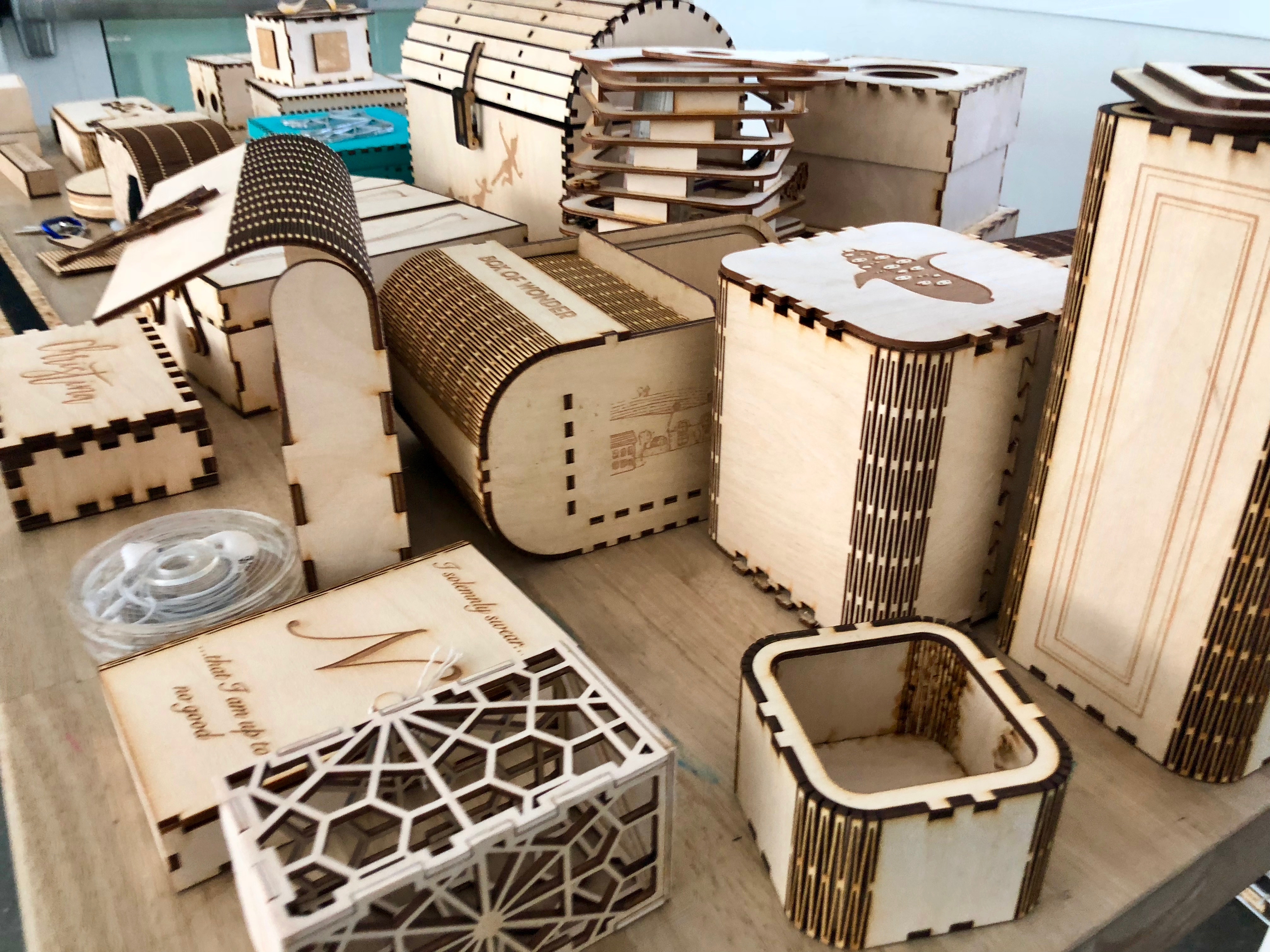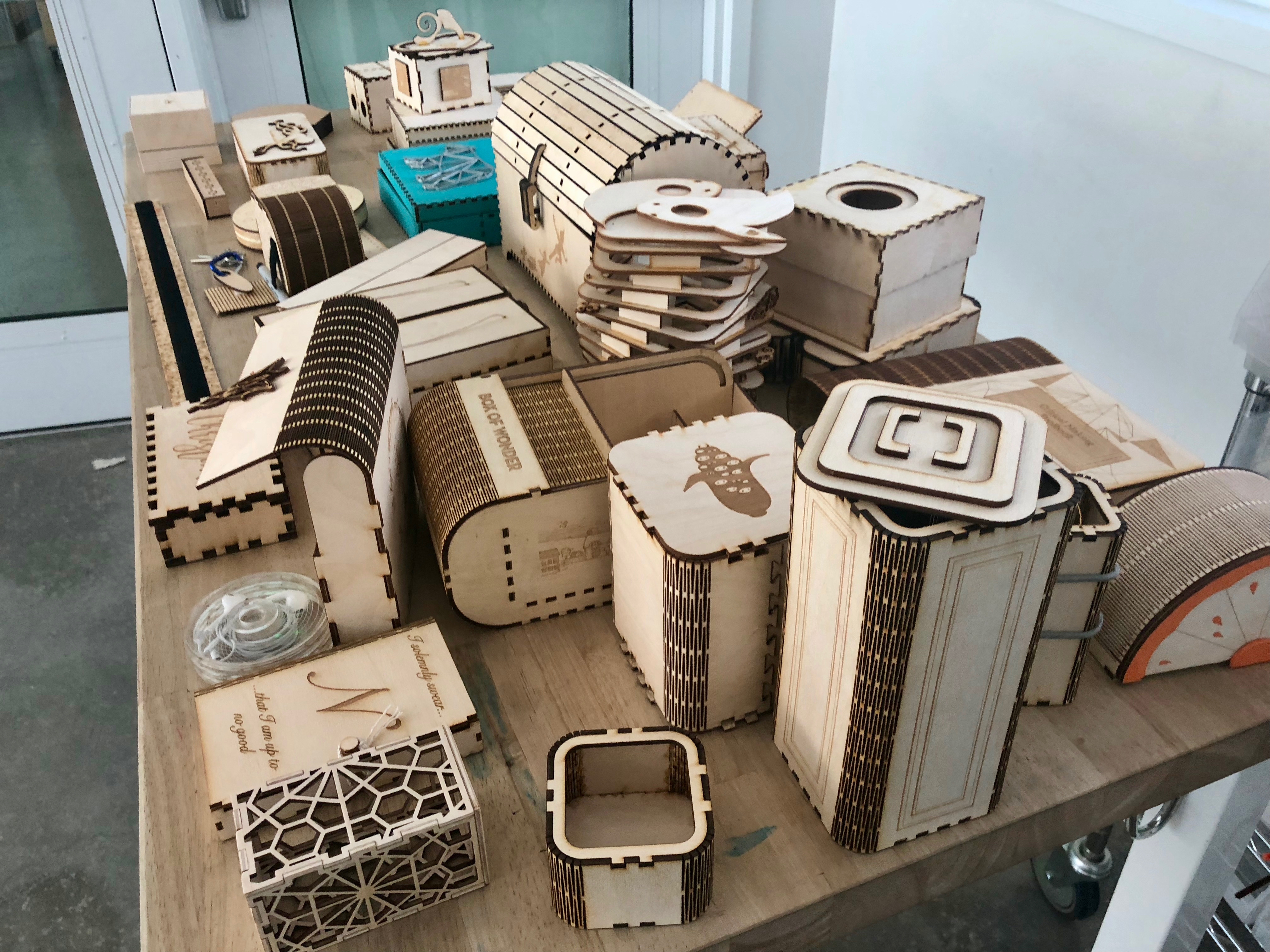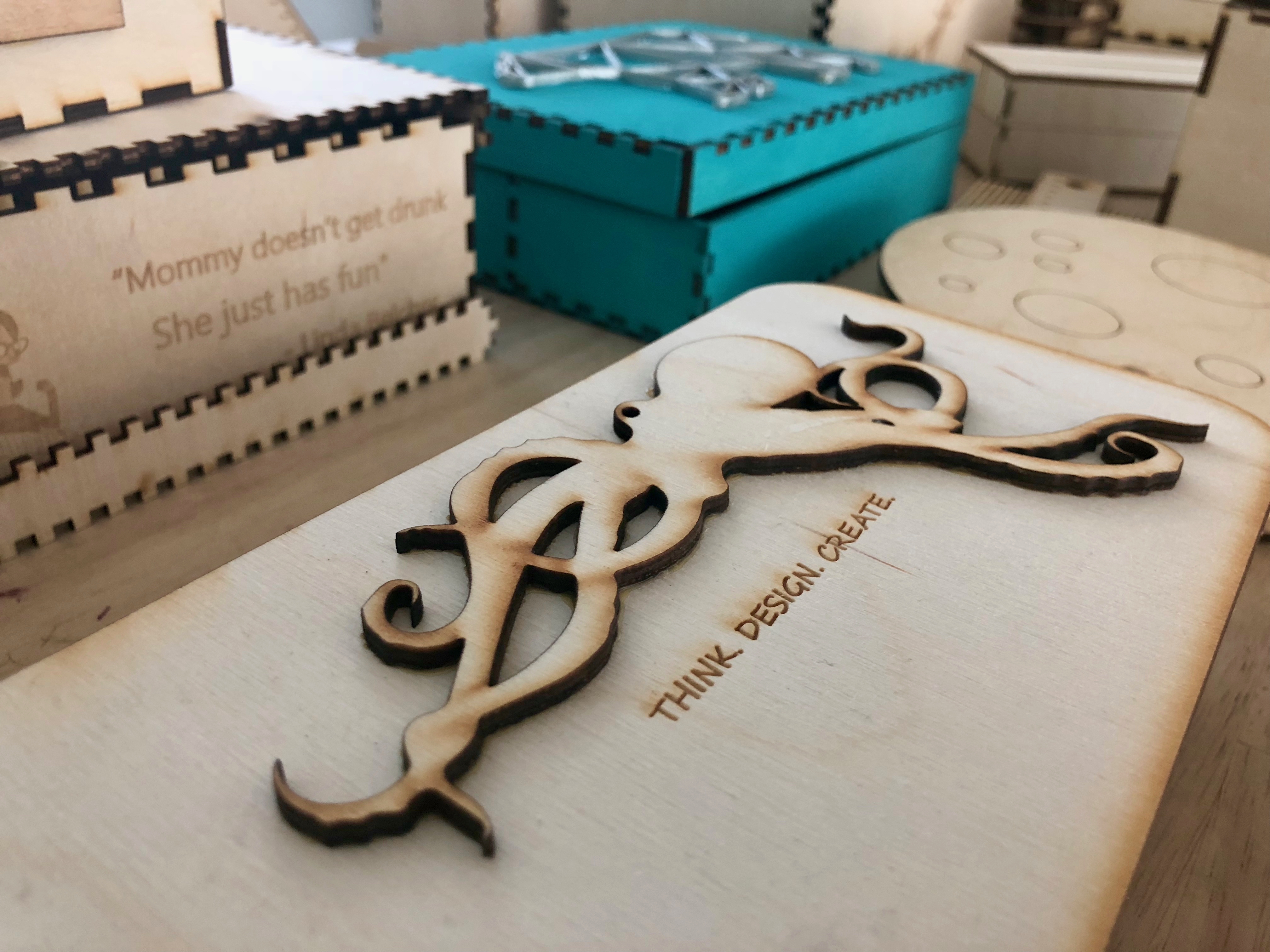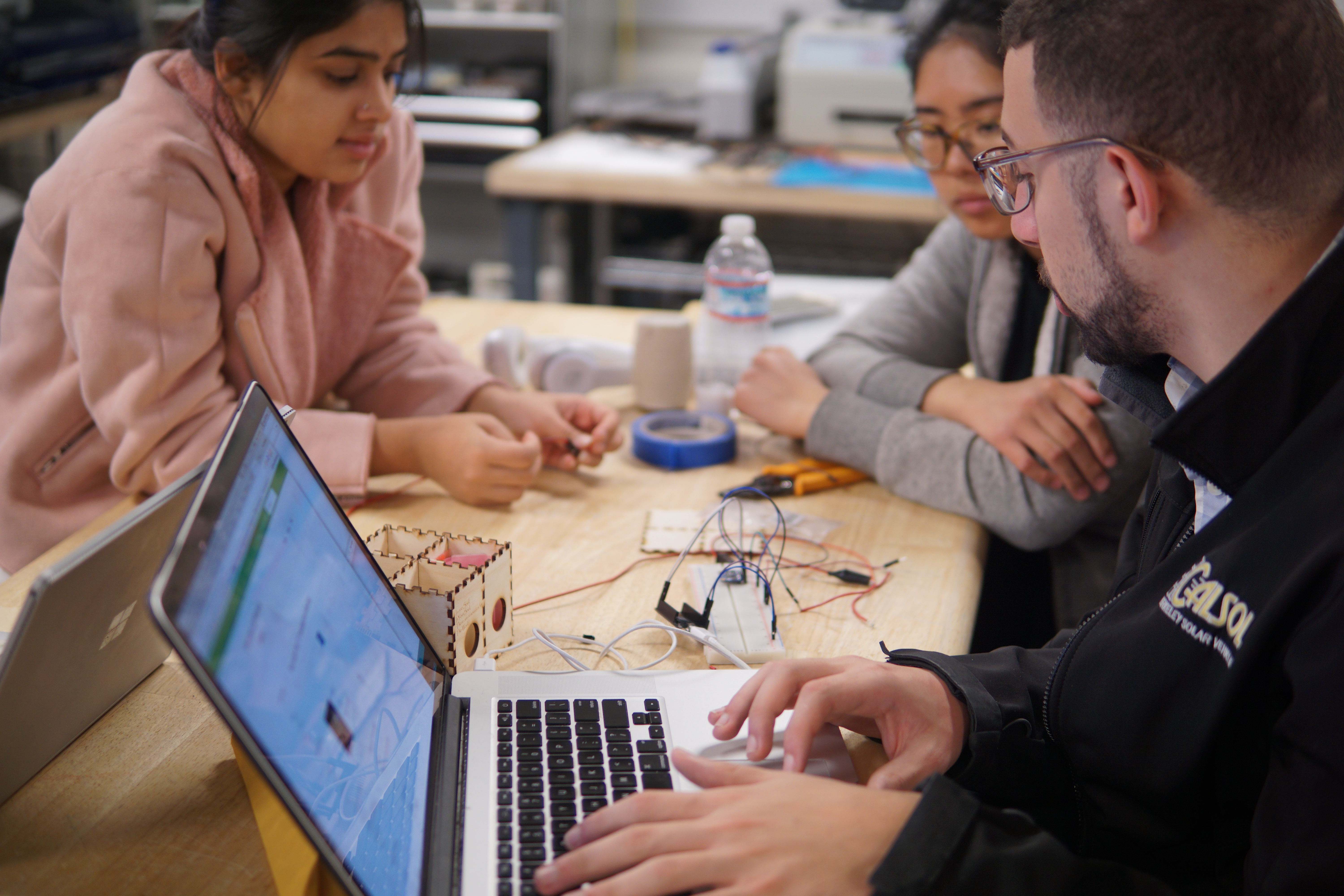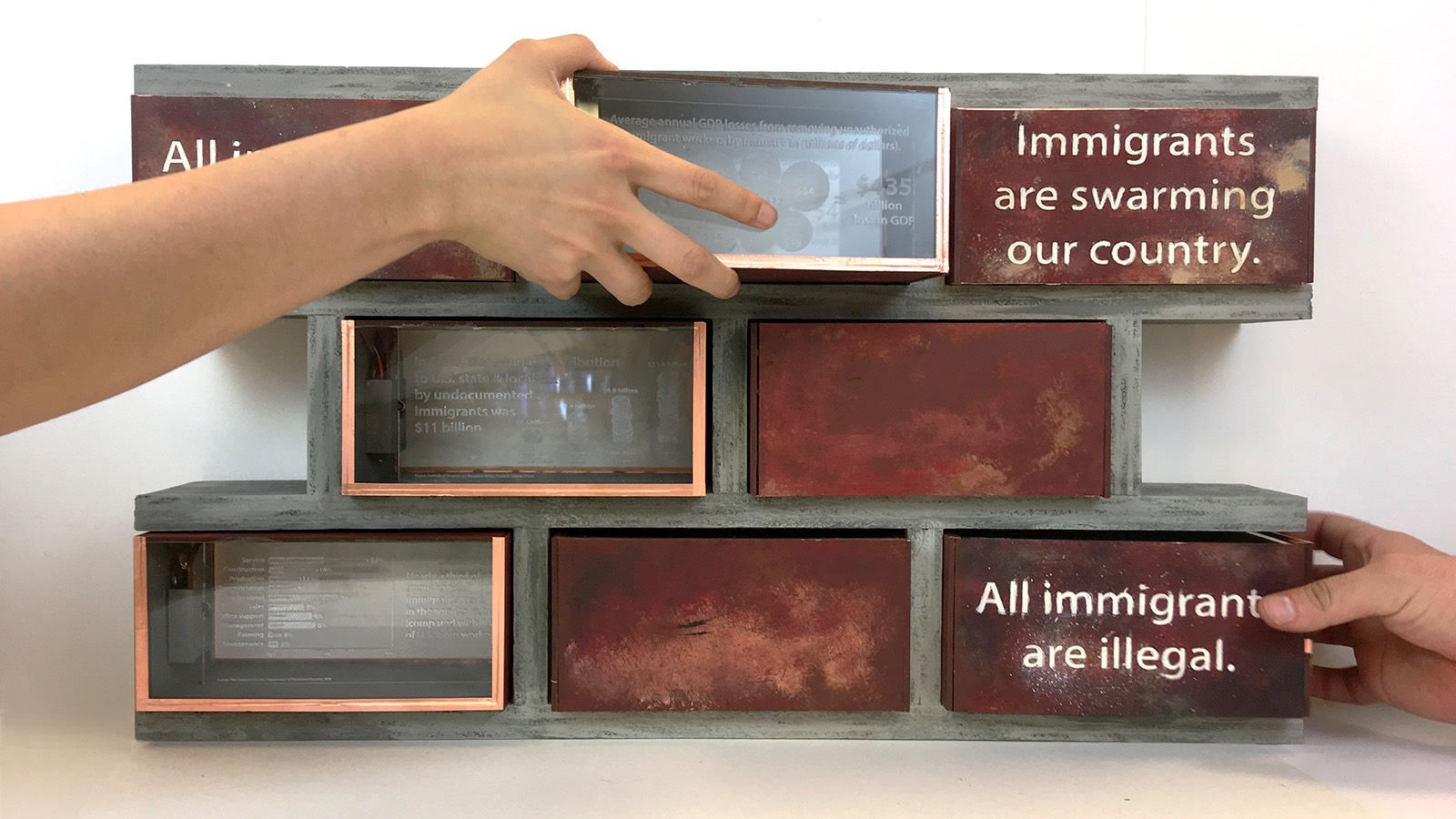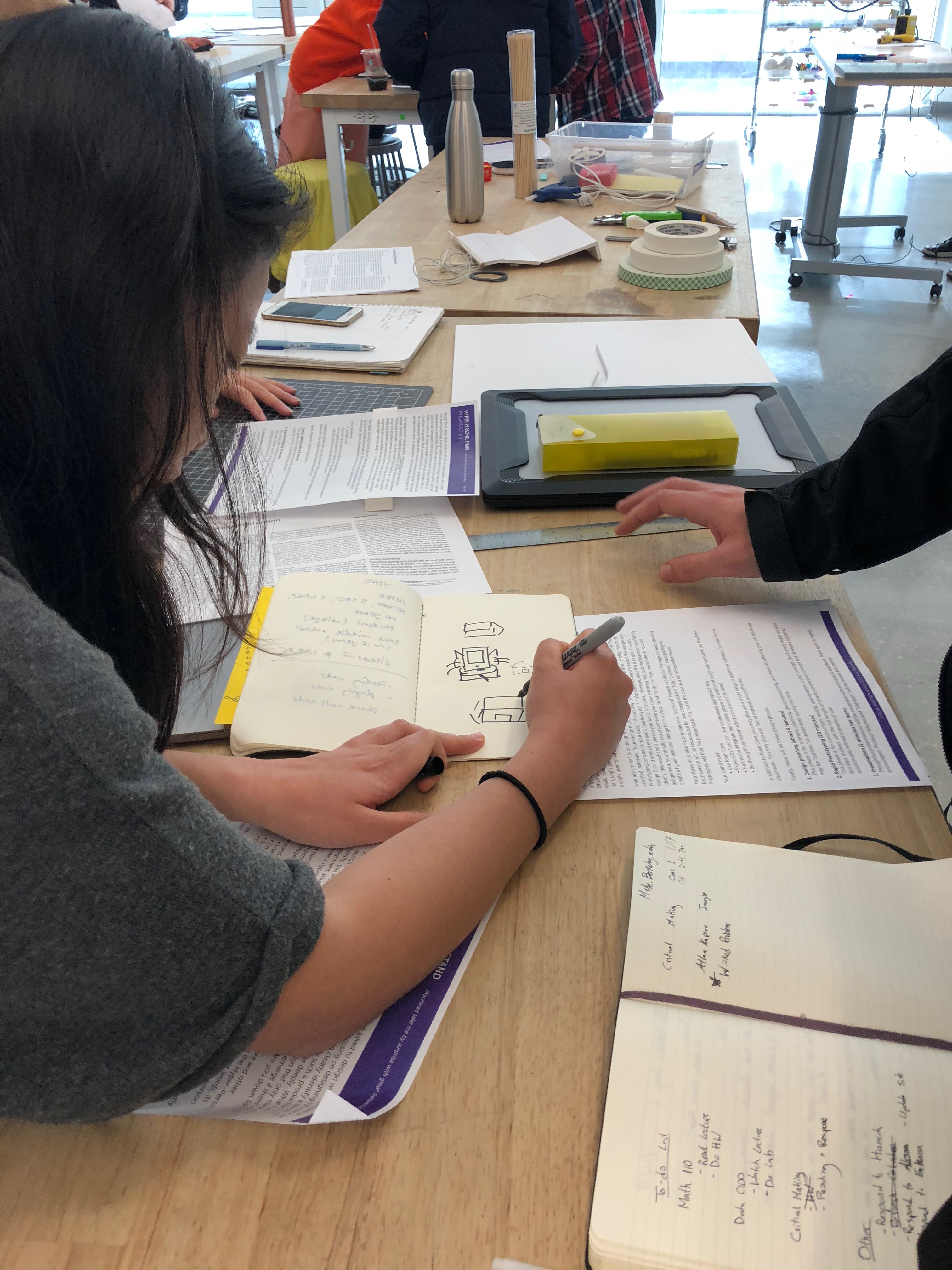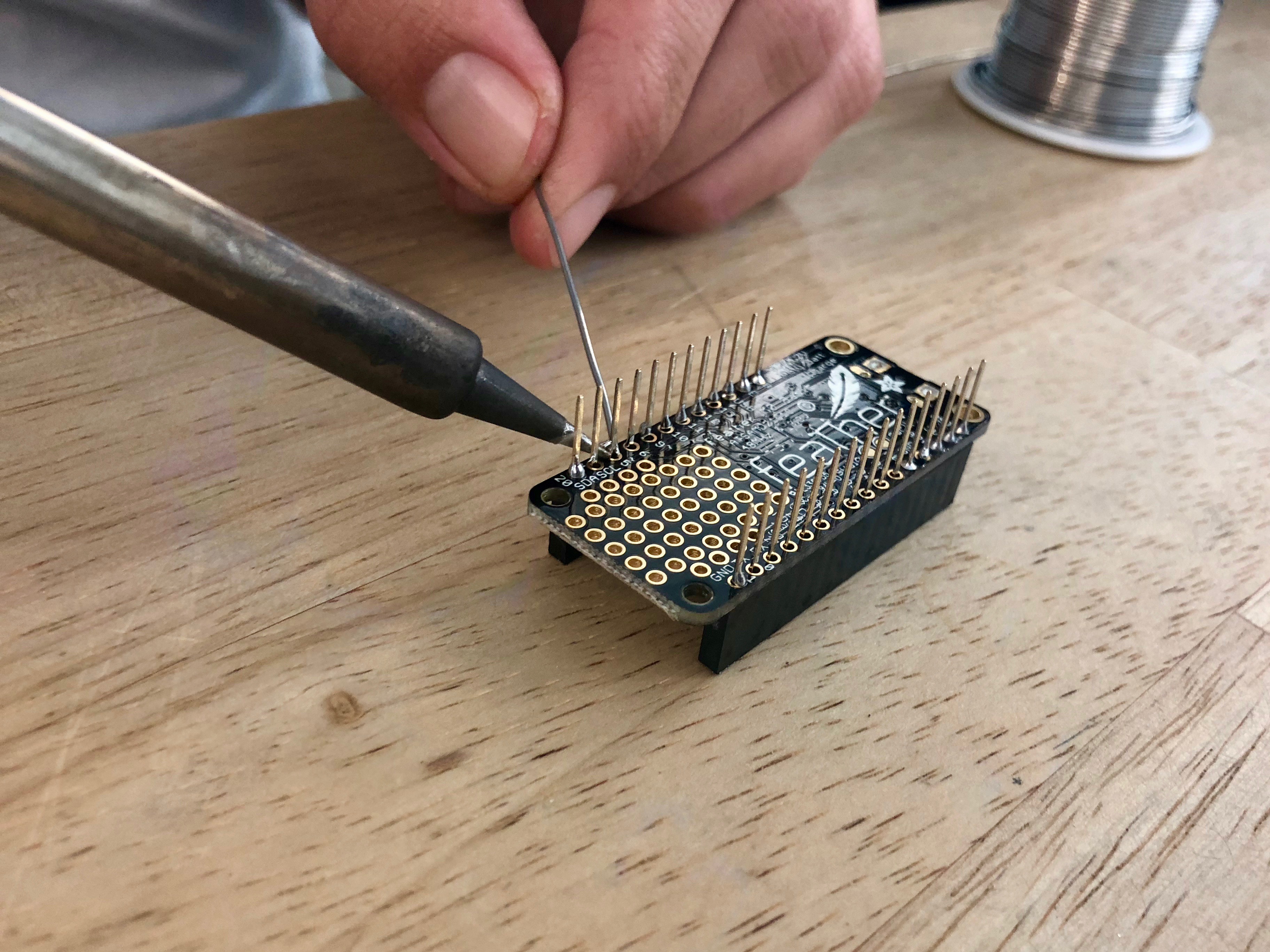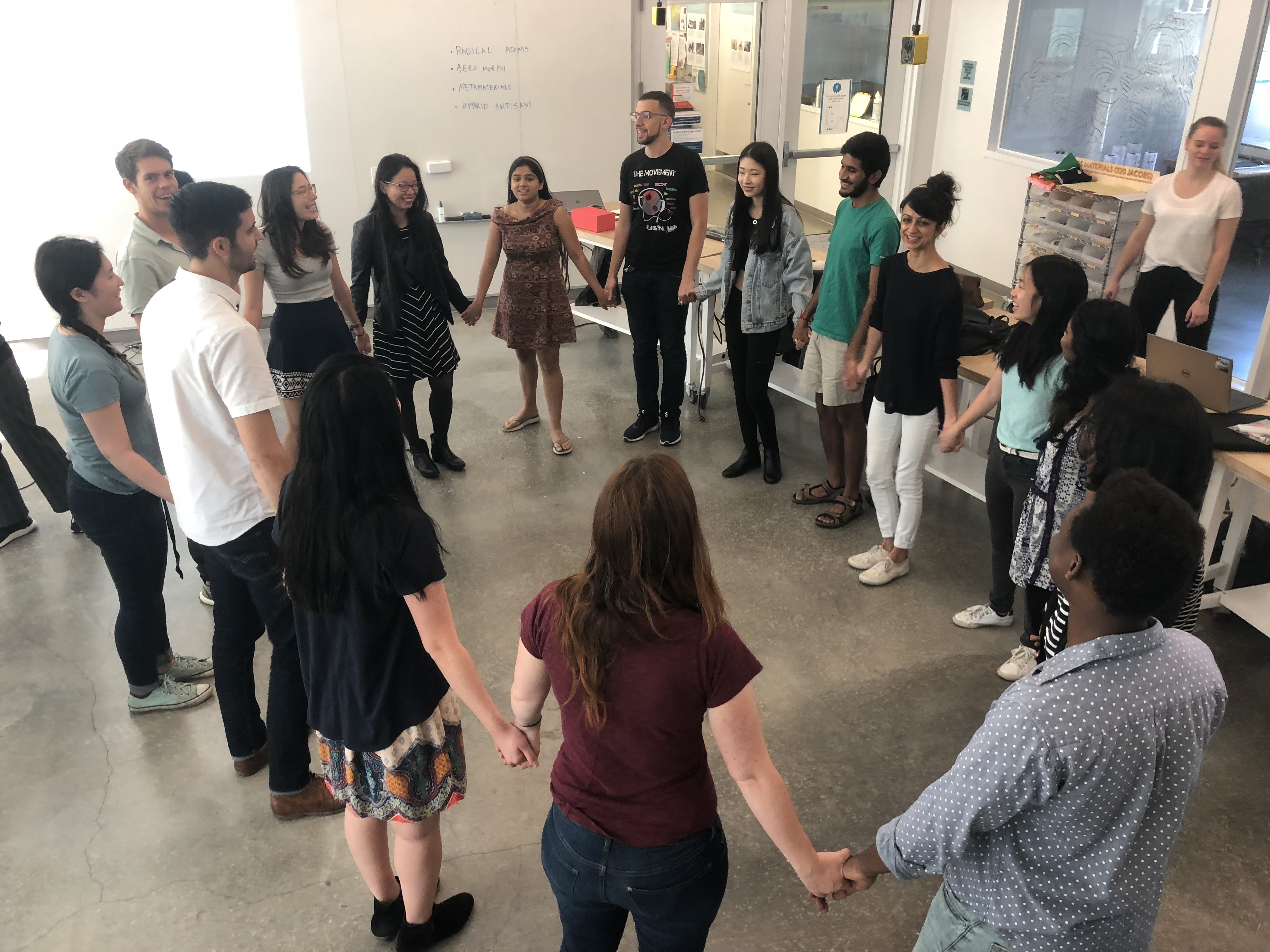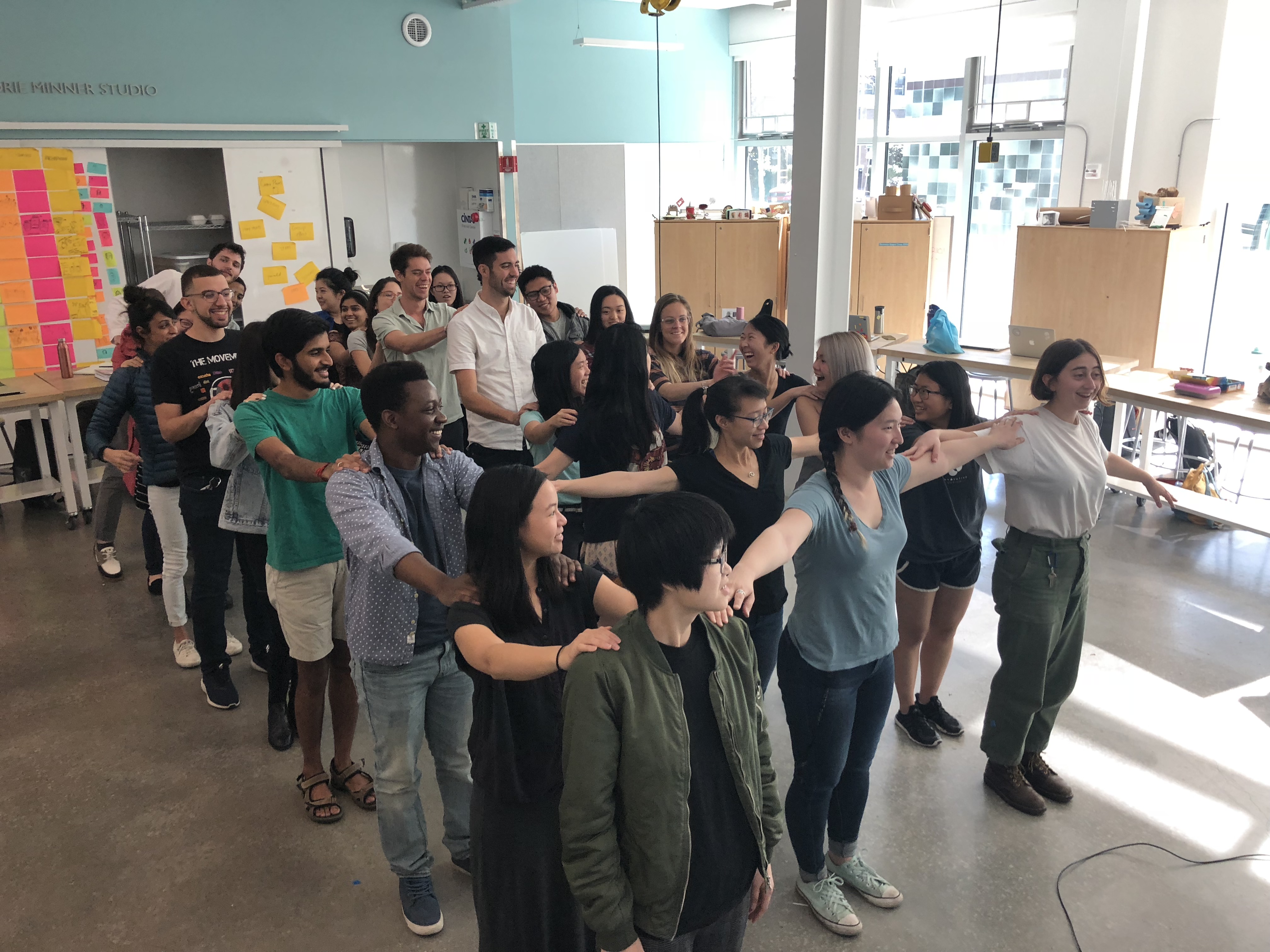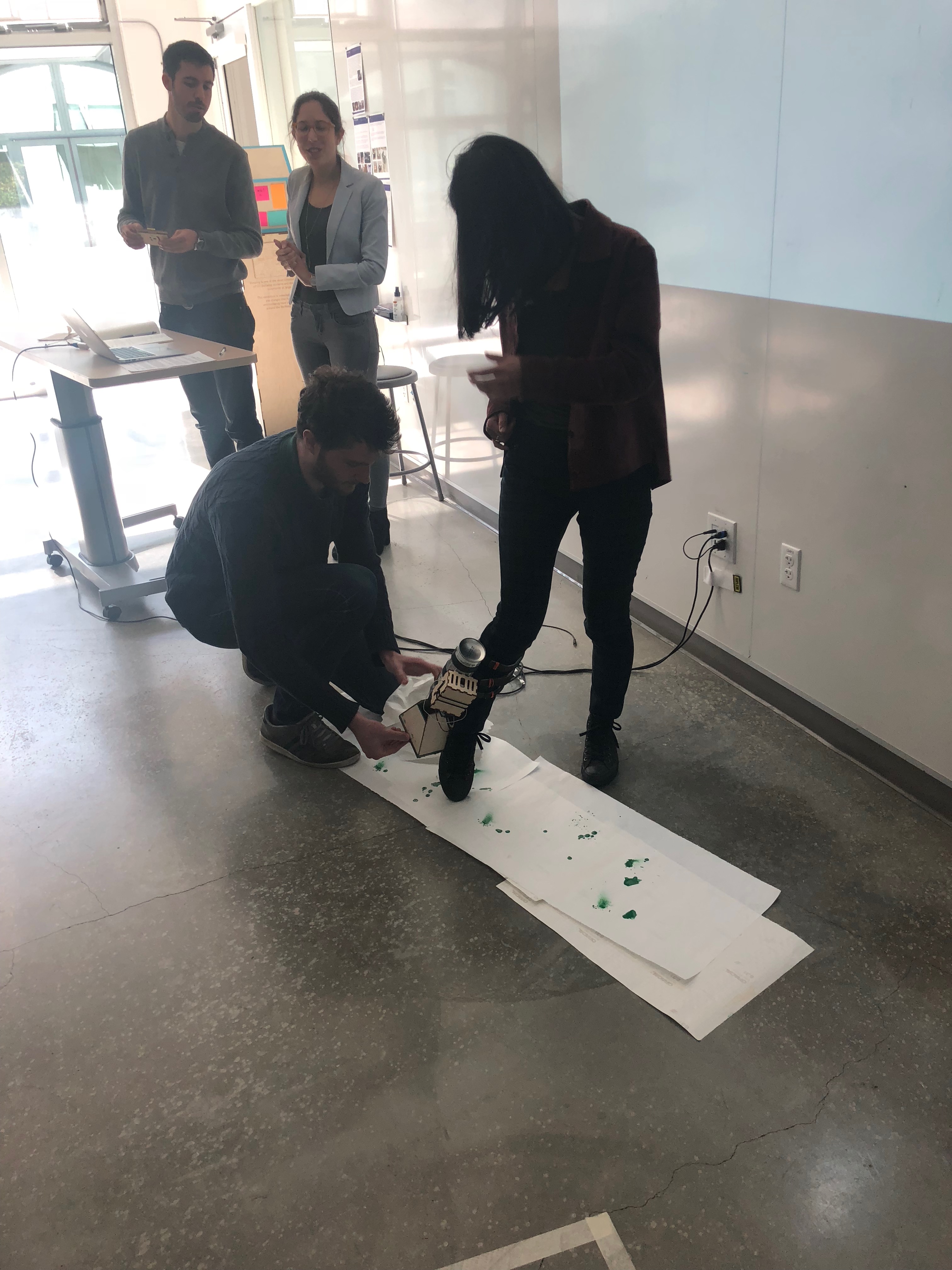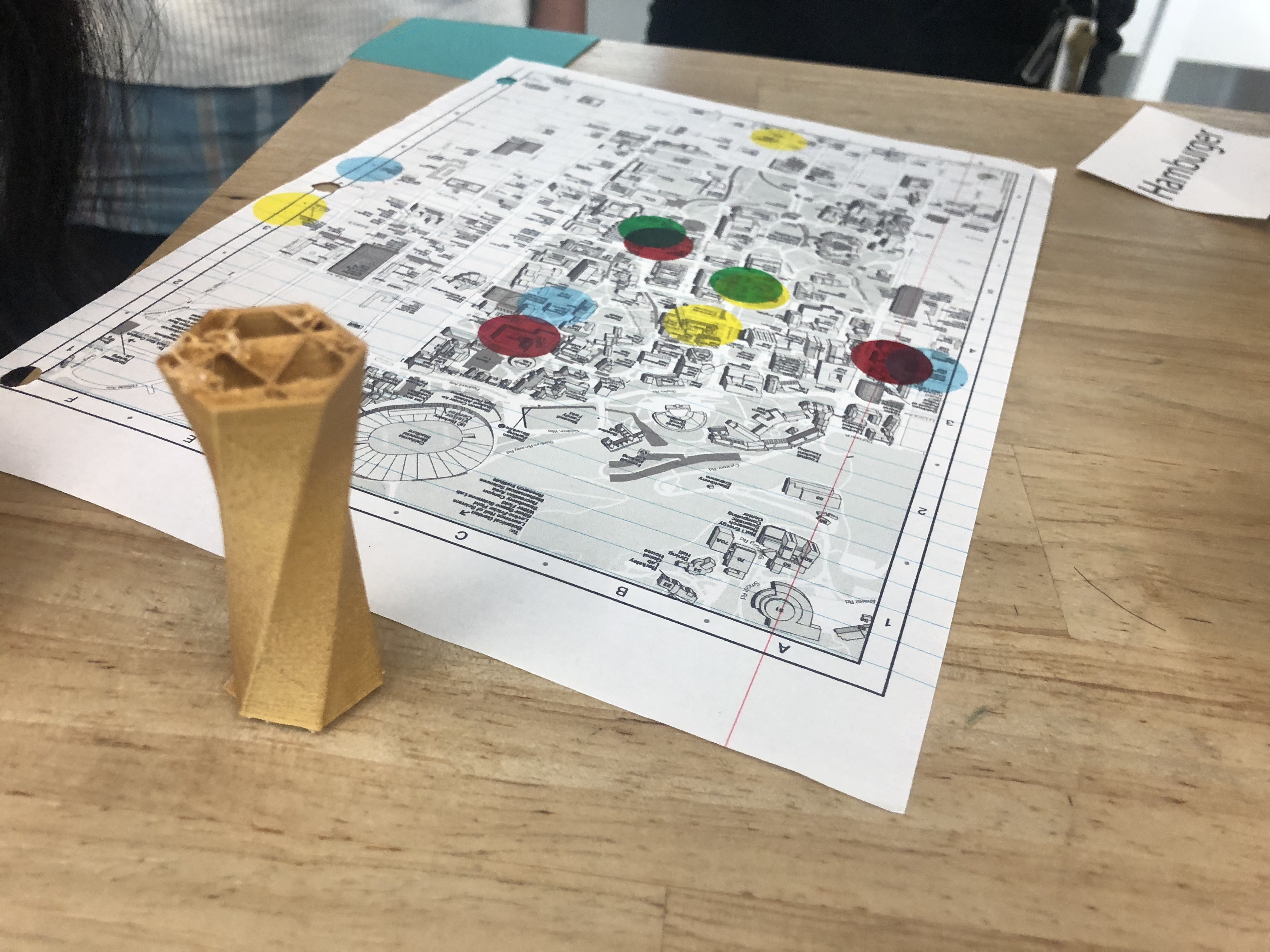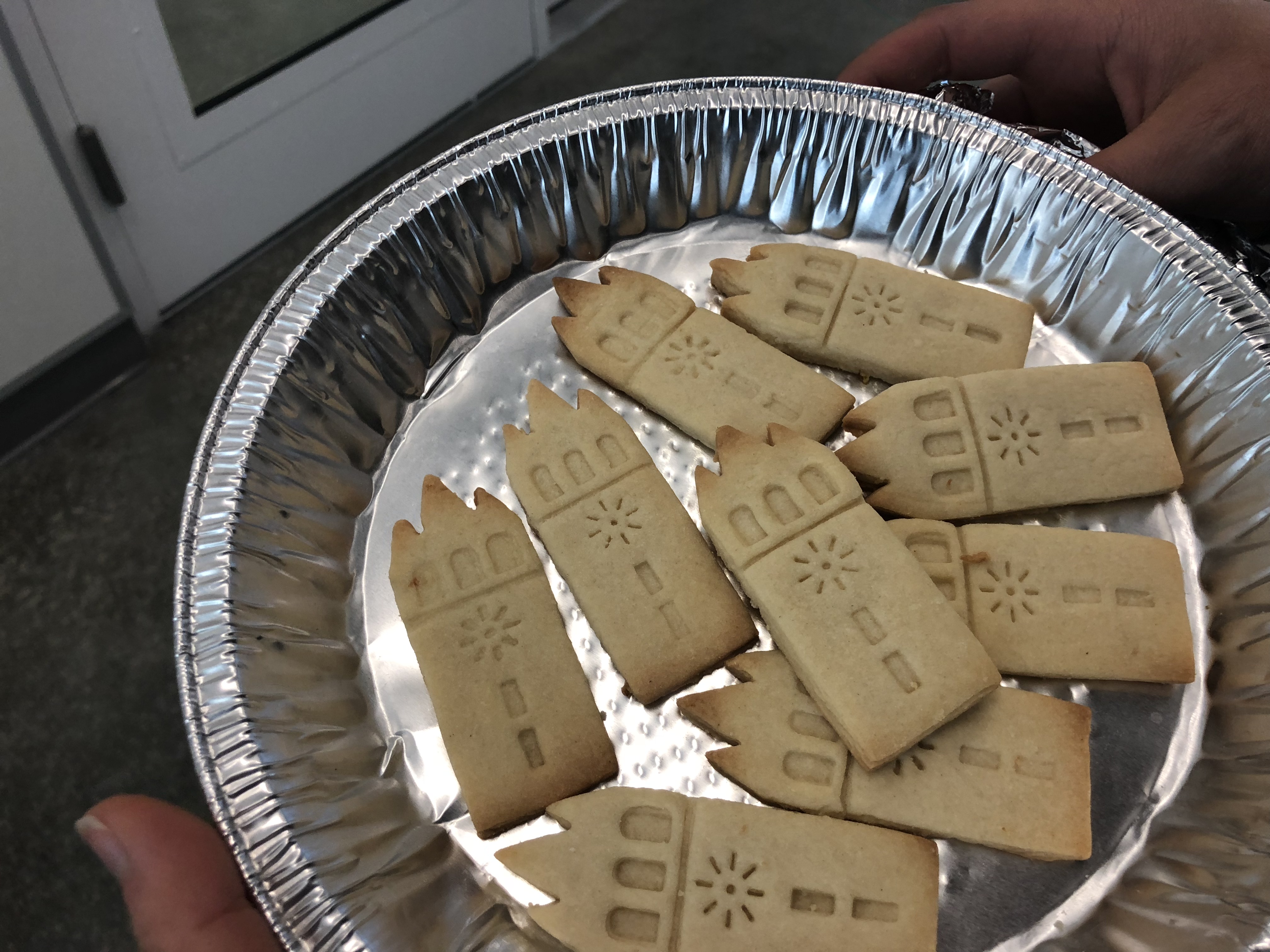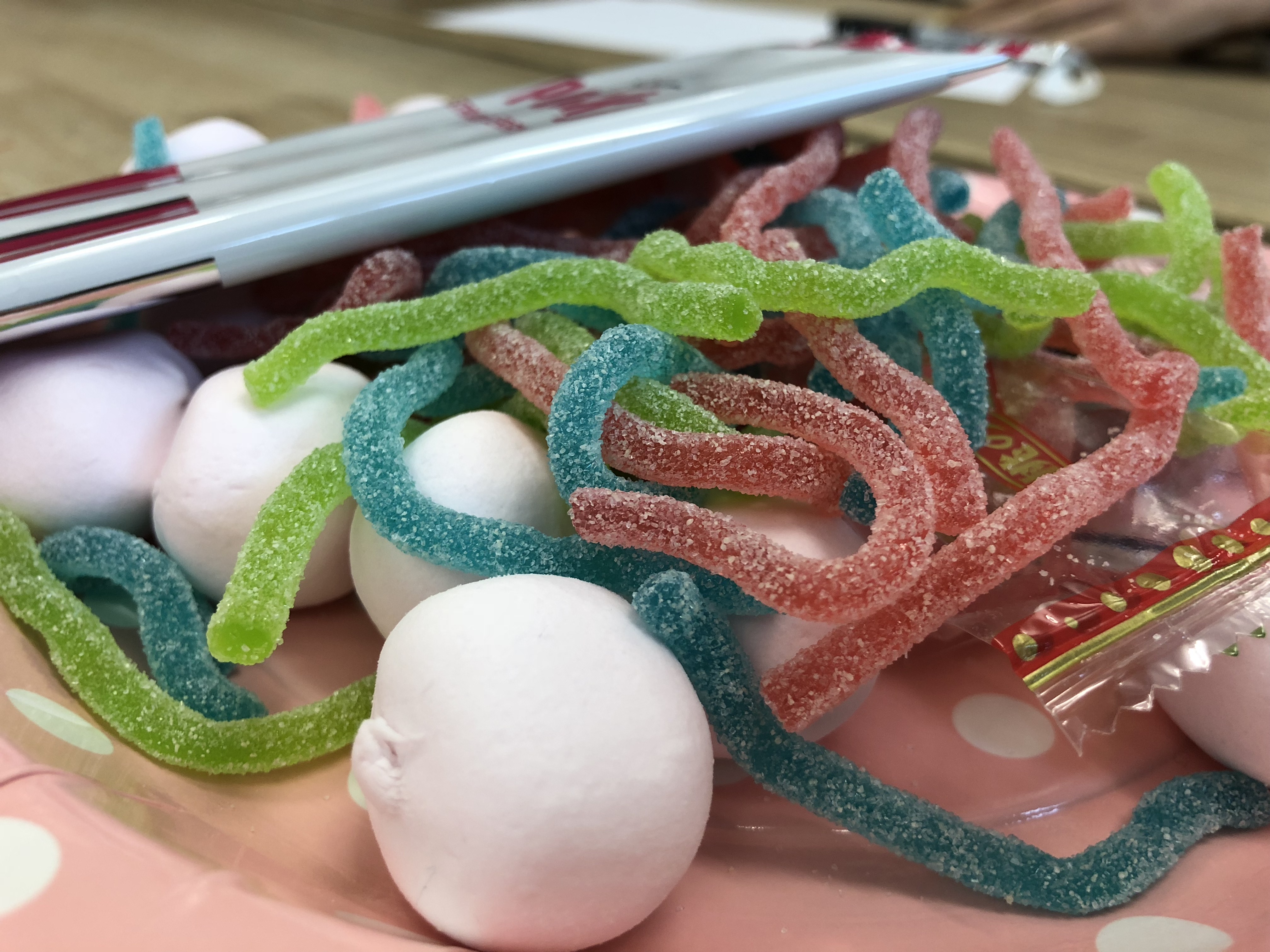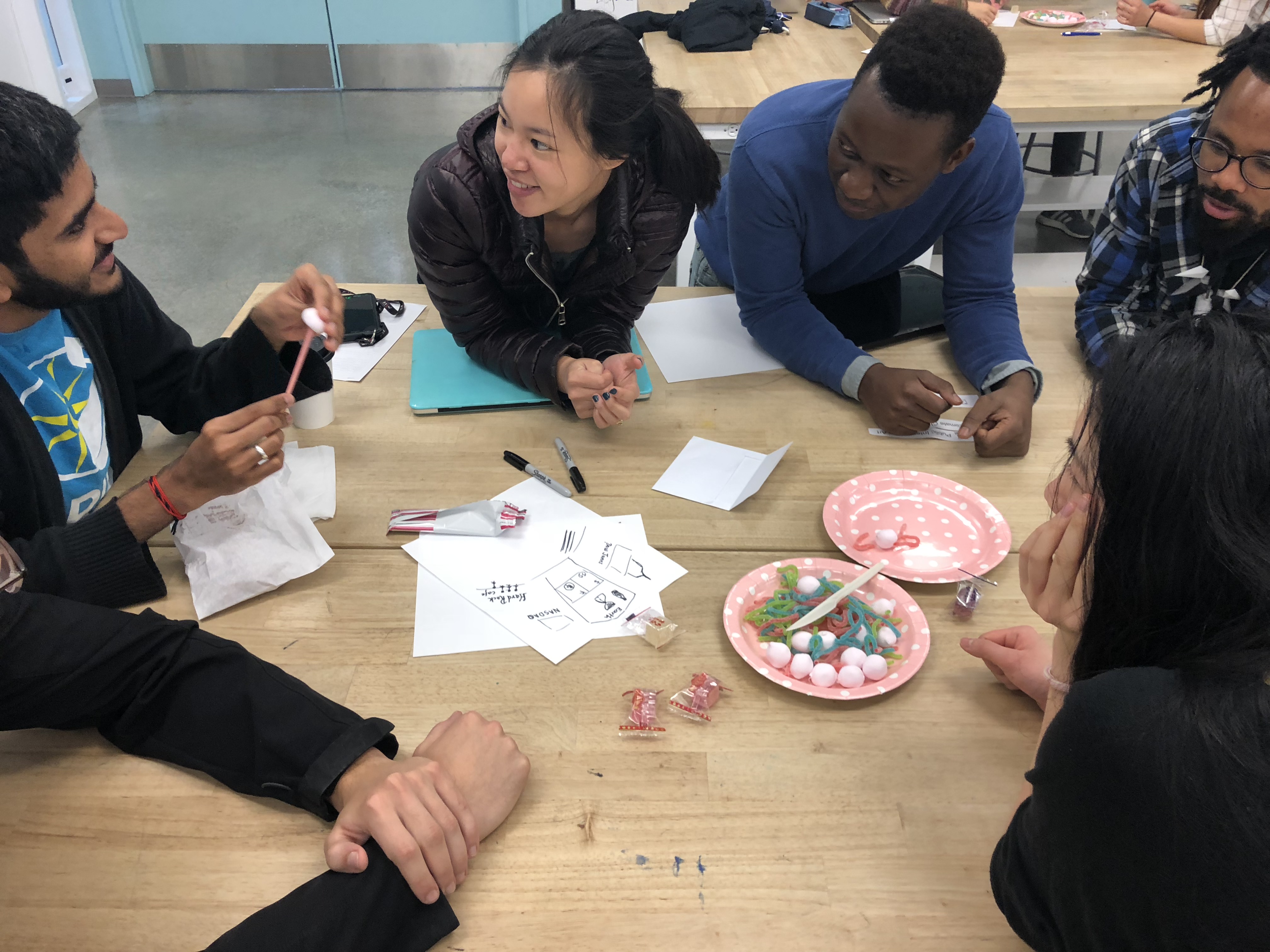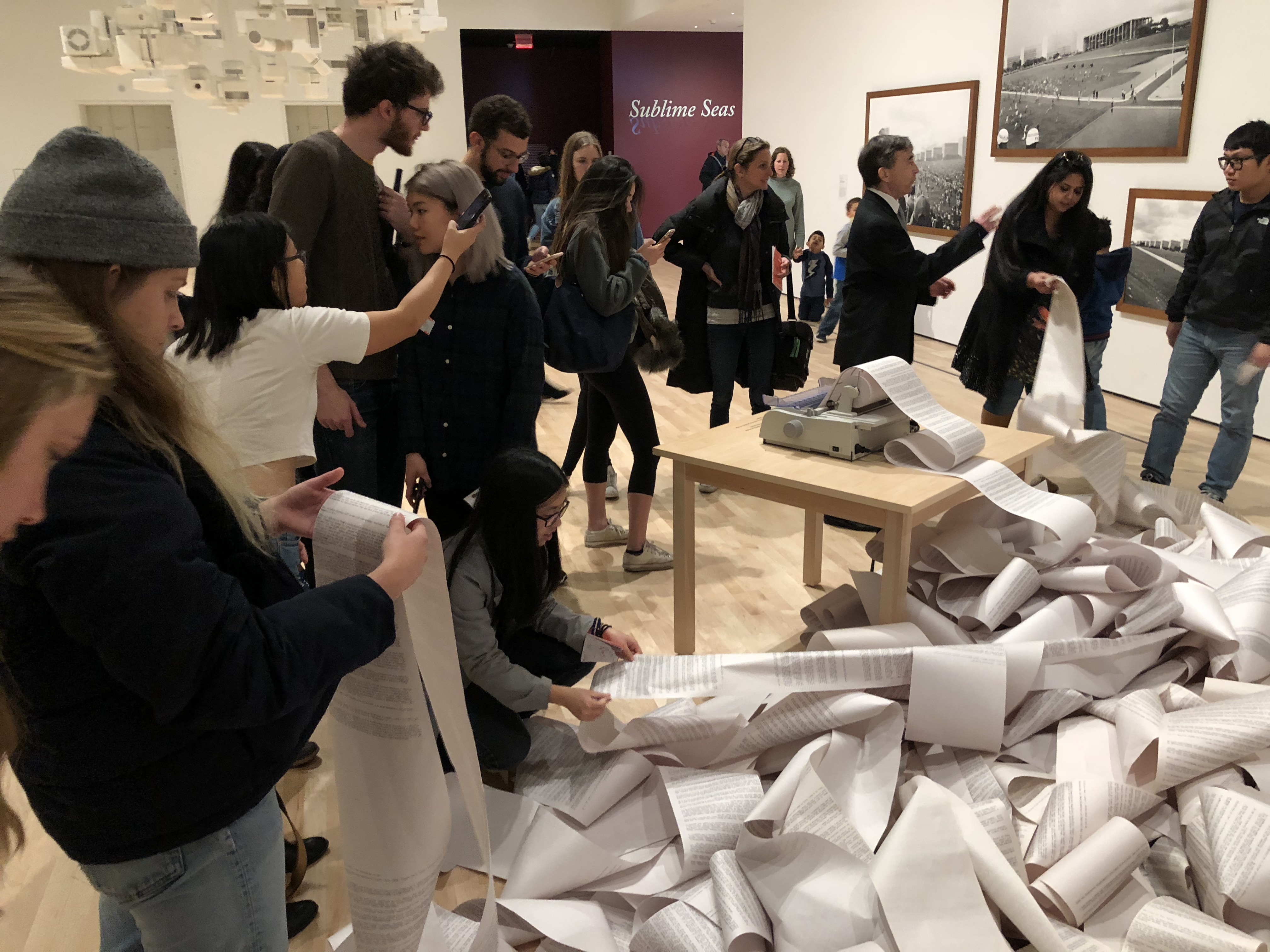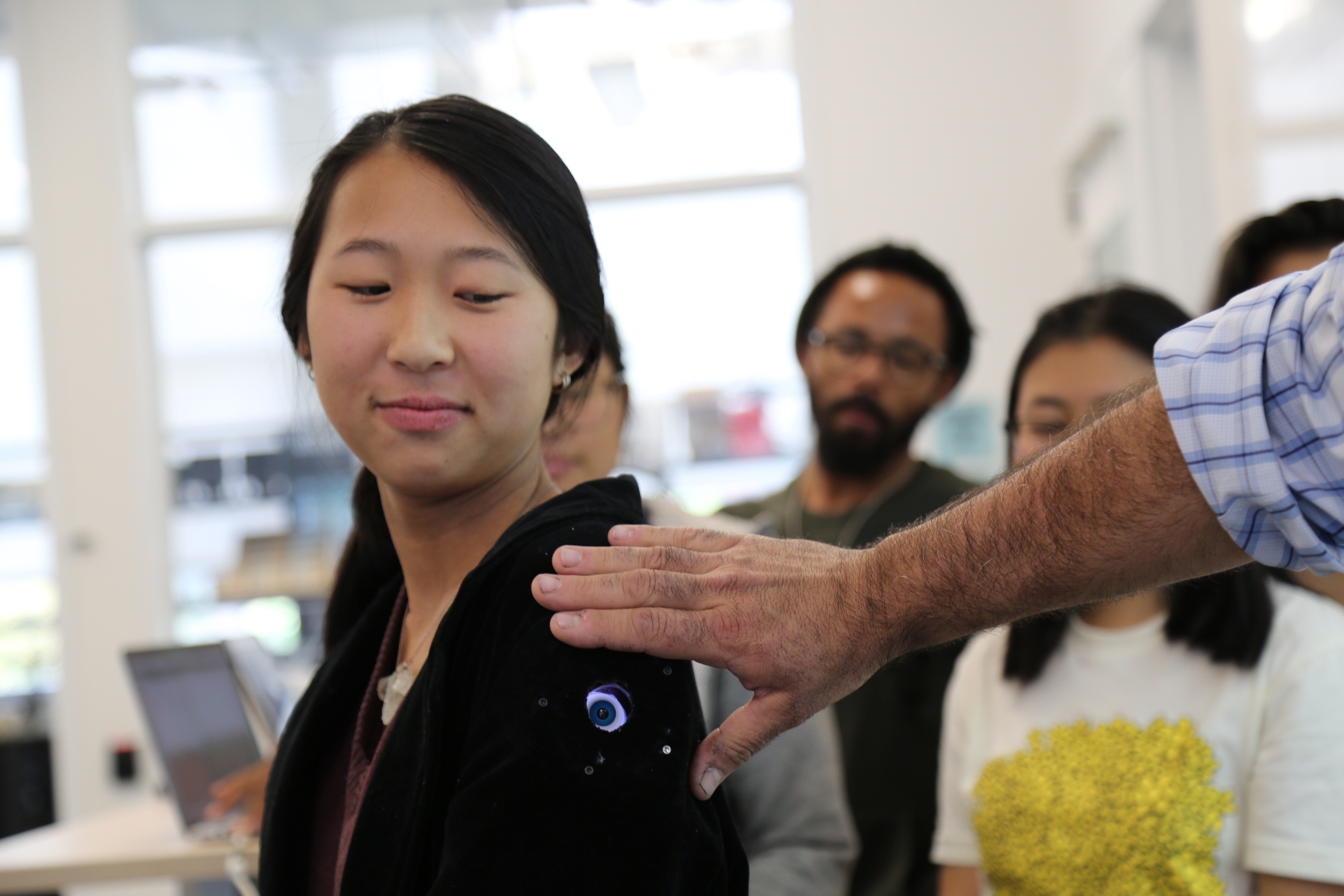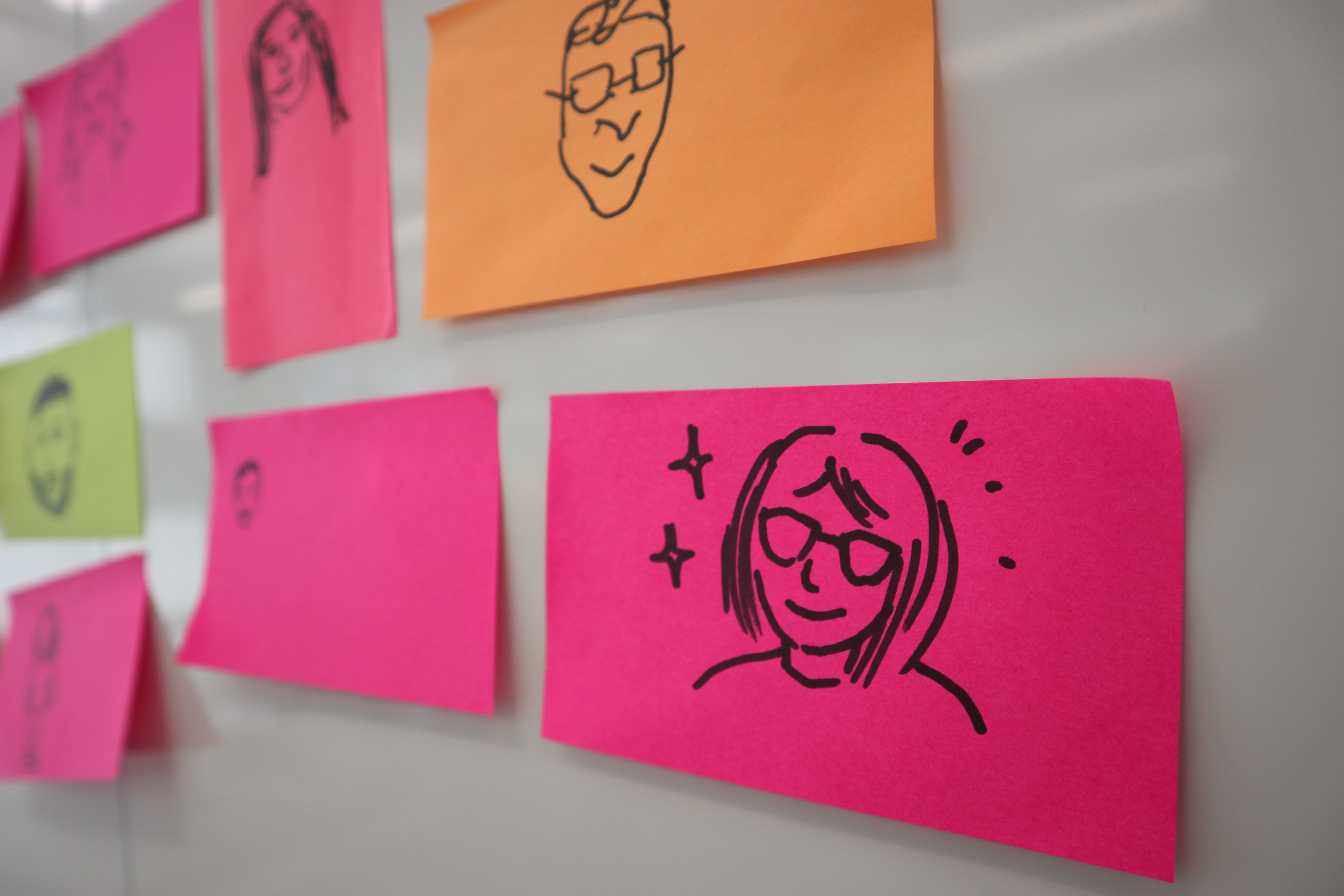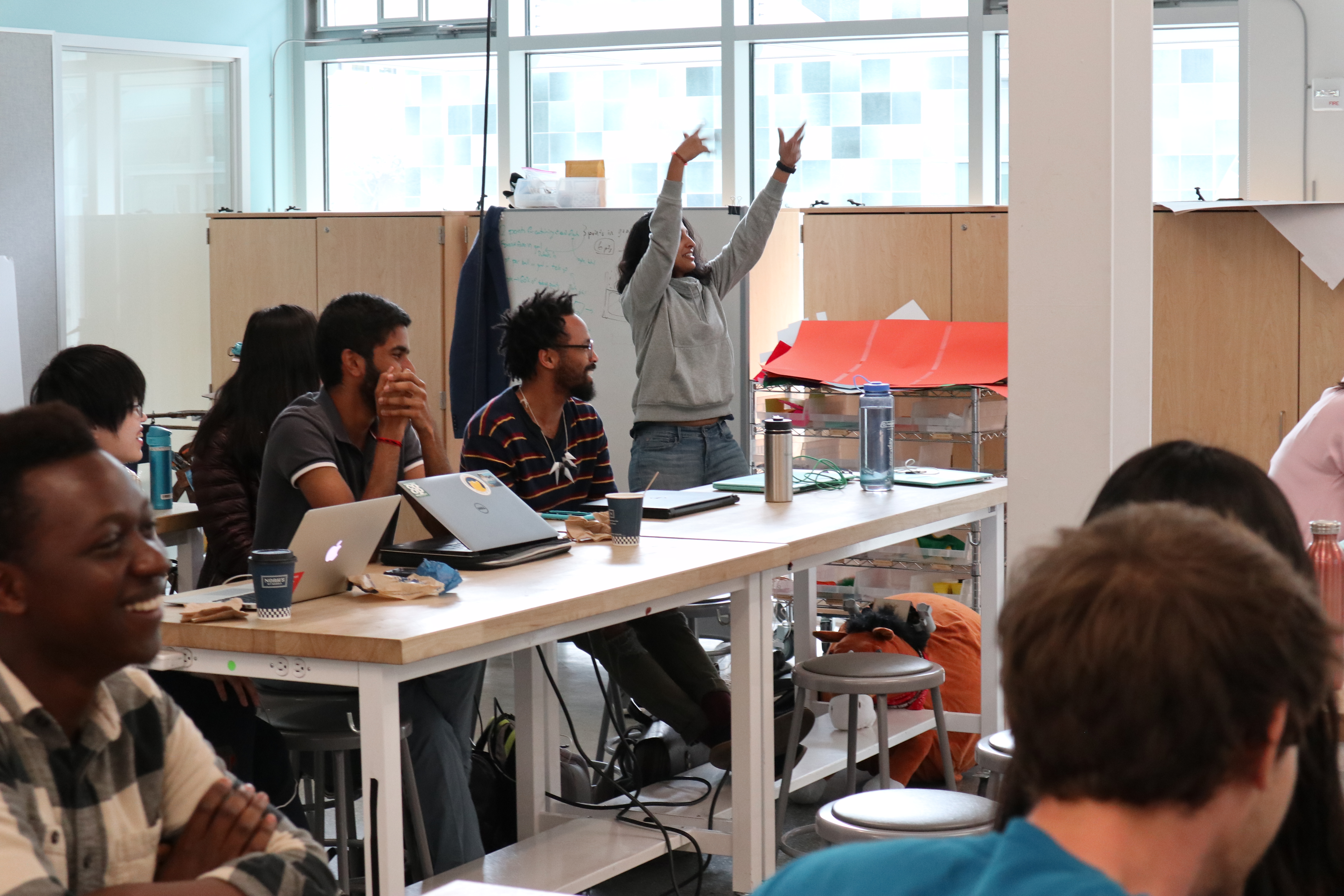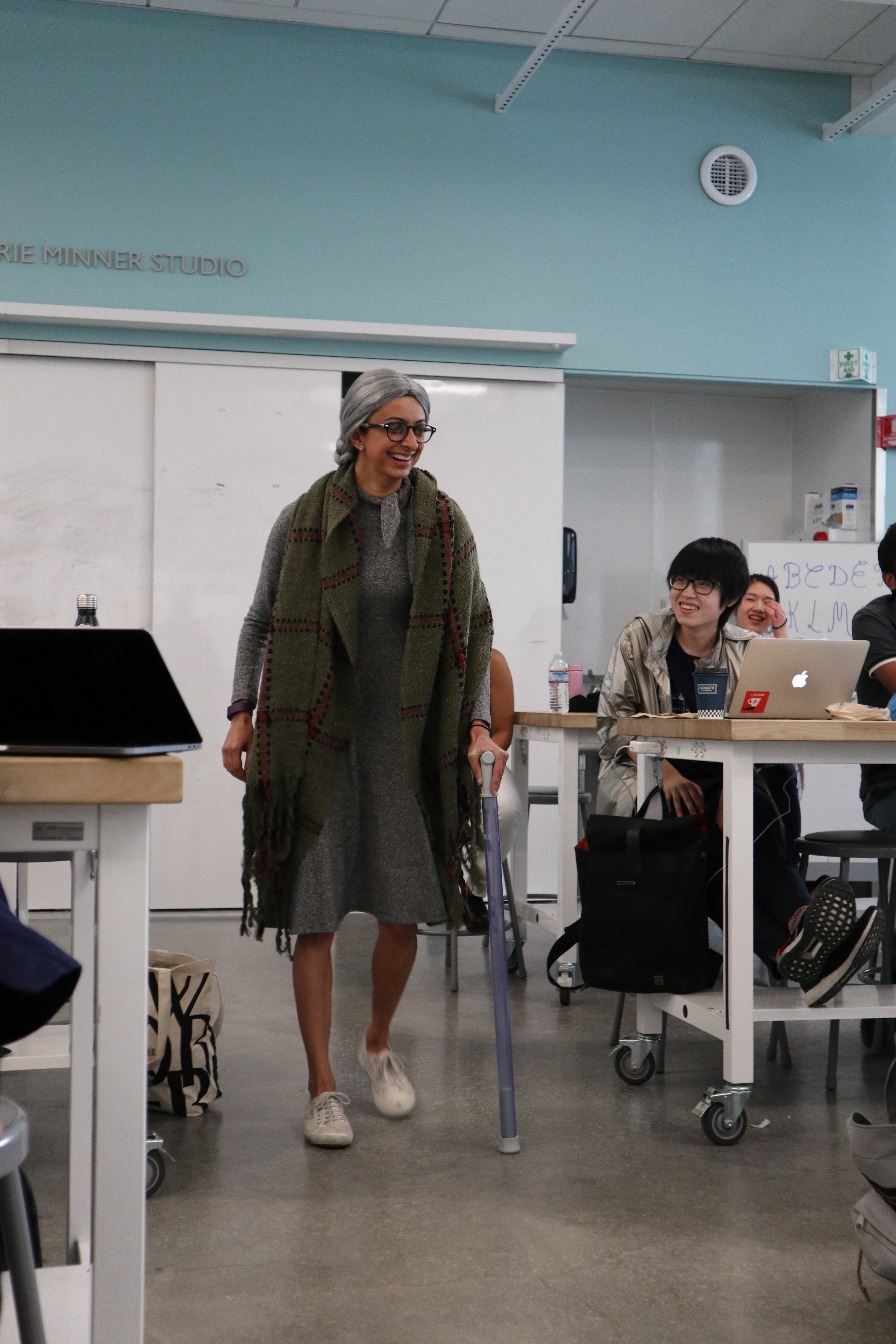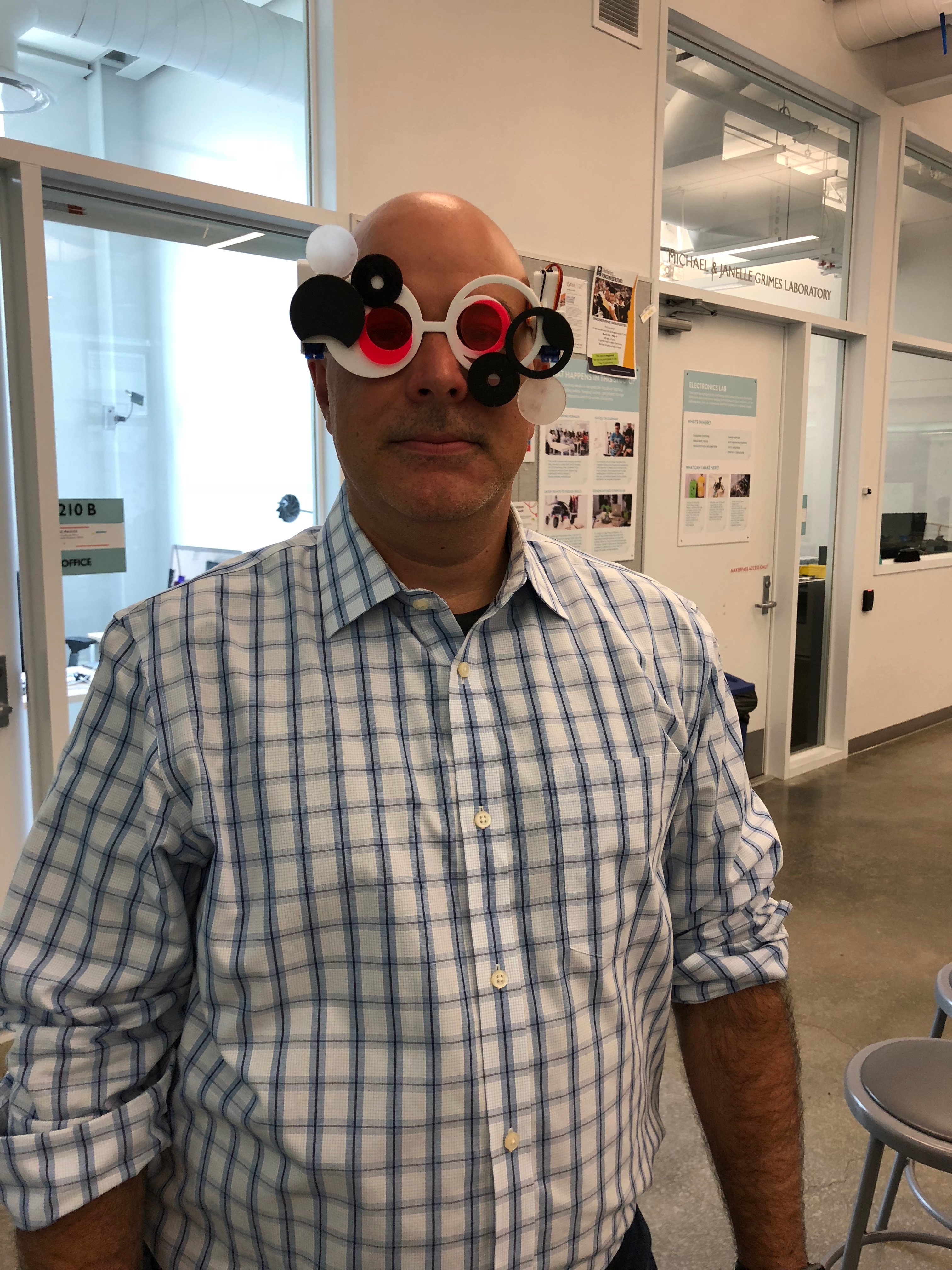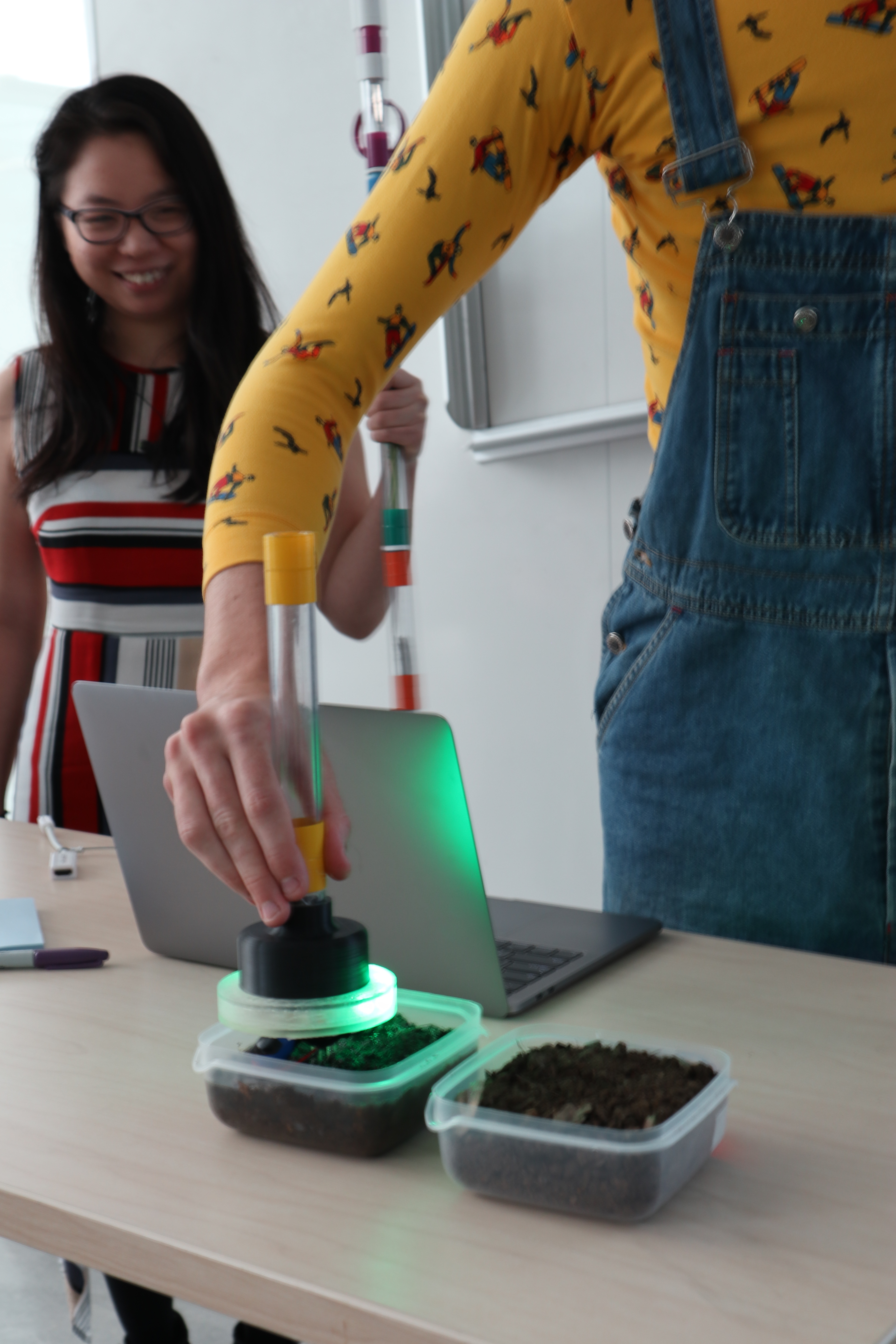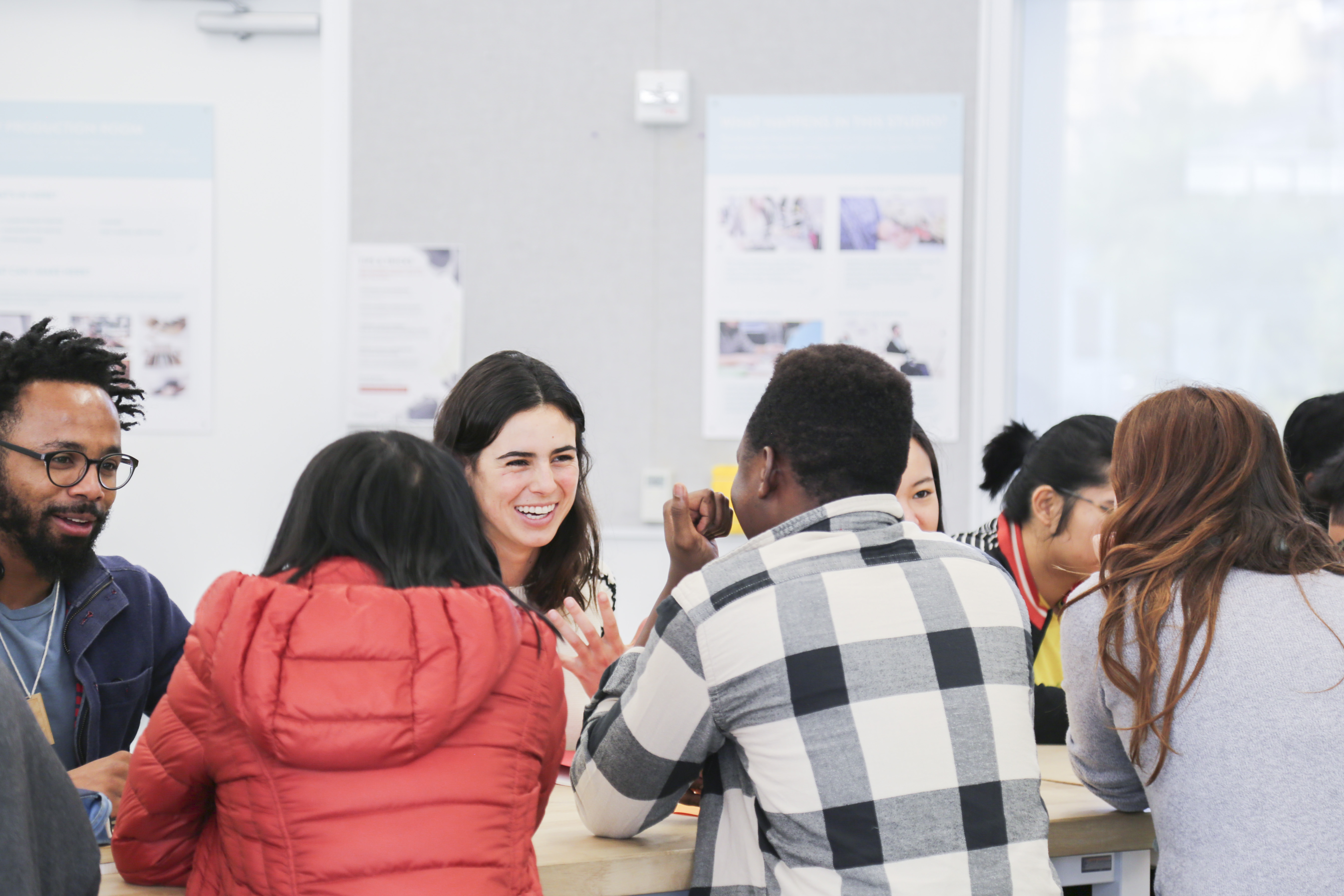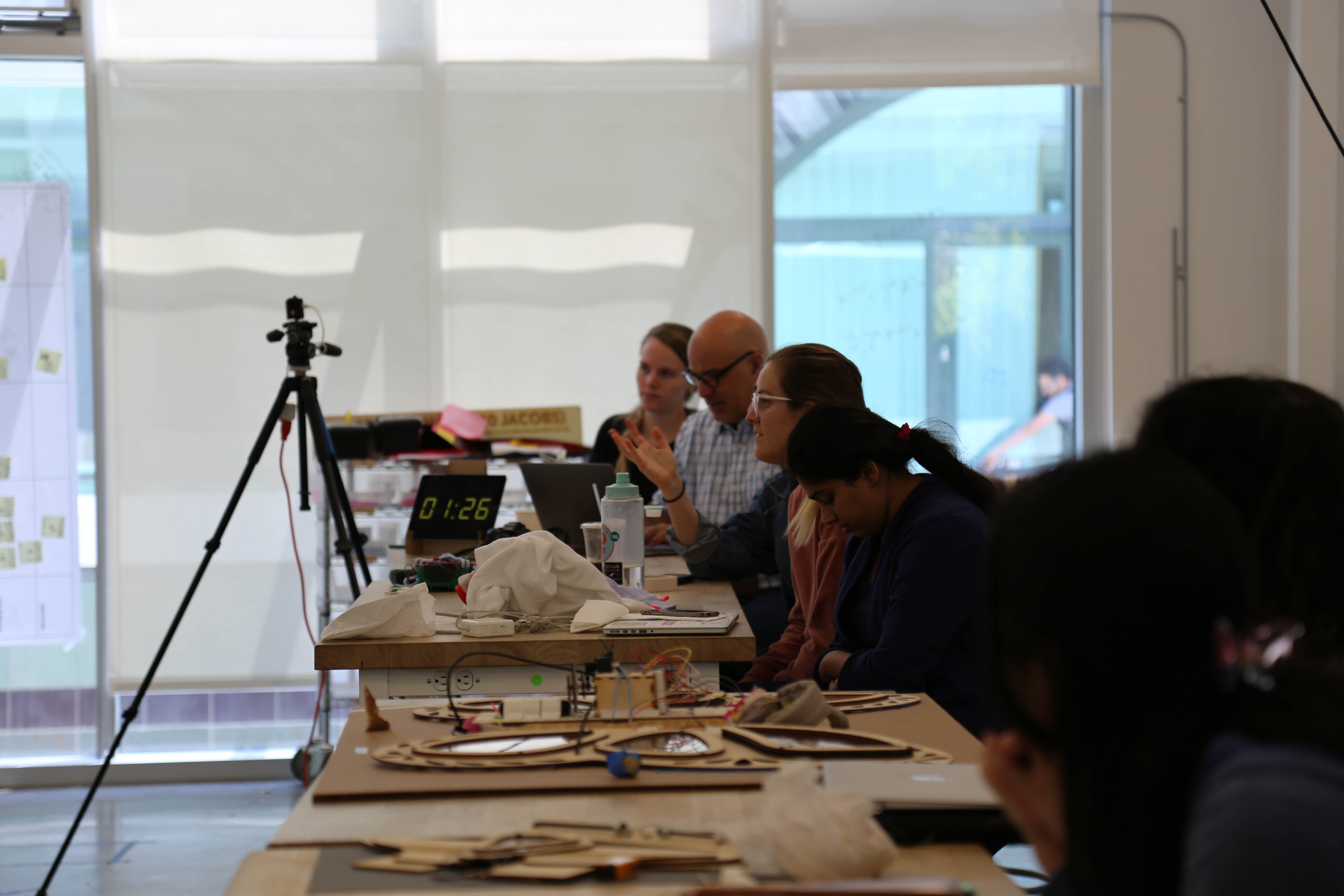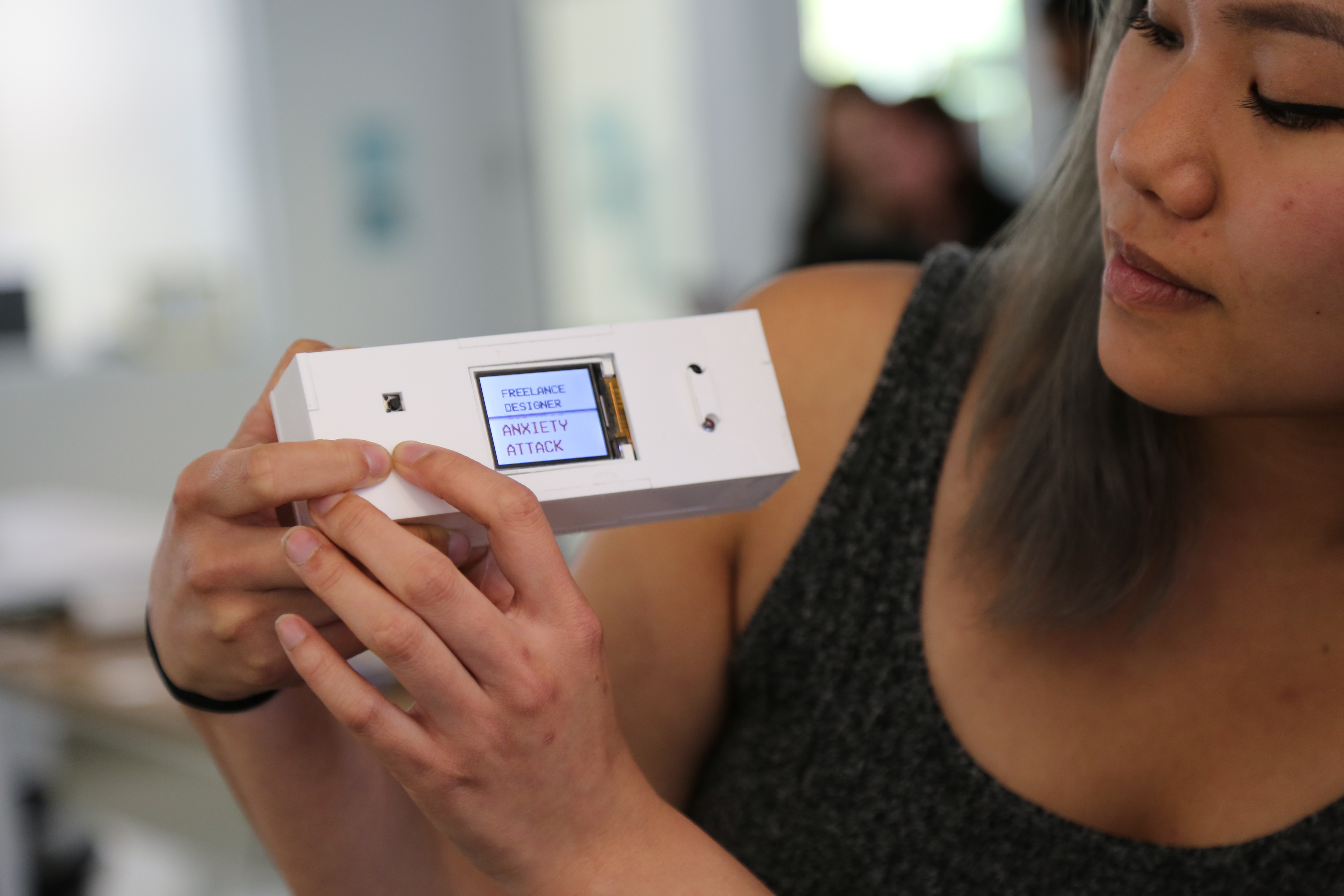Spring 2018
NWMEDIA C203 • MEC ENG C205 • 4 units
Mon+Wed 10:00–12:00
220 Jacobs Hall
Syllabus
Professor • Eric Paulos
GSI • Christine Dierk
Invention Lab Manager • Chris Myers
Final Provocation Projects
In this provocation, students were asked to design a new wearable within the landscape of cosmetic computing. That is, a new physical object (or collection of objects) that are body-worn.
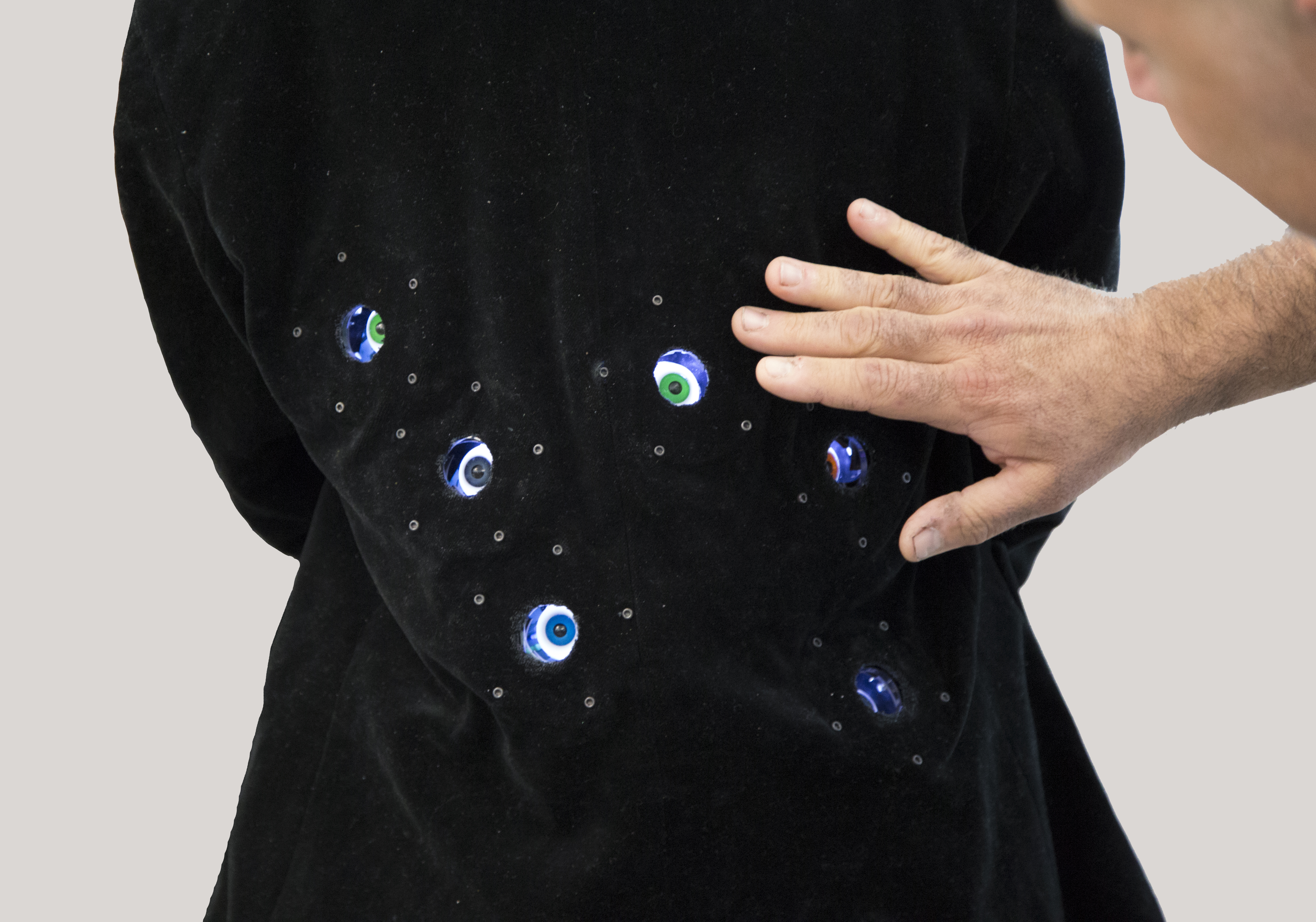
Eyeris
Silvia Kim
George Moore
Arianna Ninh
Katherine Qiu
Eyeris is a performative wearable that aims to tackle the issue of sexual harassment –specifically, non-consensual touch. It’s common for many people, especially women, to experience inappropriate touching in their day-to-day lives. So, how can we prevent these violating encounters from happening? We designed Eyeris, an interactive coat speckled with mechanical irises that deter potential predators from pursuing non-consensual contact. When someone touches the jacket without the wearer's consent, the irises open to reveal eerie, glowing eyes. This causes the assailant to feel like they are being watched, hence discouraging criminal, inappropriate behavior. This subtle yet immediate reaction to touch reminds us to be more cognizant of the implications of our actions.

PerSpectacles
Nour Eldifrawy
Leeann Hu
Crystal Lee
Nigel Mevana
Many of today’s problems stem from social disconnect, despite social media’s promise of making the world more “connected”. That’s why we created PerSpectacles, a pair of spectacles that challenges that promise of a more connected world. They provide a comfortable, but narrowed perspective, symbolic of the actual effect social media has on our world view. Each of the lens were designed to exaggerate the ways technology facilitates and/or manipulates the way we view the world (e.g. unduly optimistic, narrow-minded, and ignorant). The ability to manually control the filters, as users of technology, is symbolic of our role in causing our lives to become more filtered, controlled, and detached.
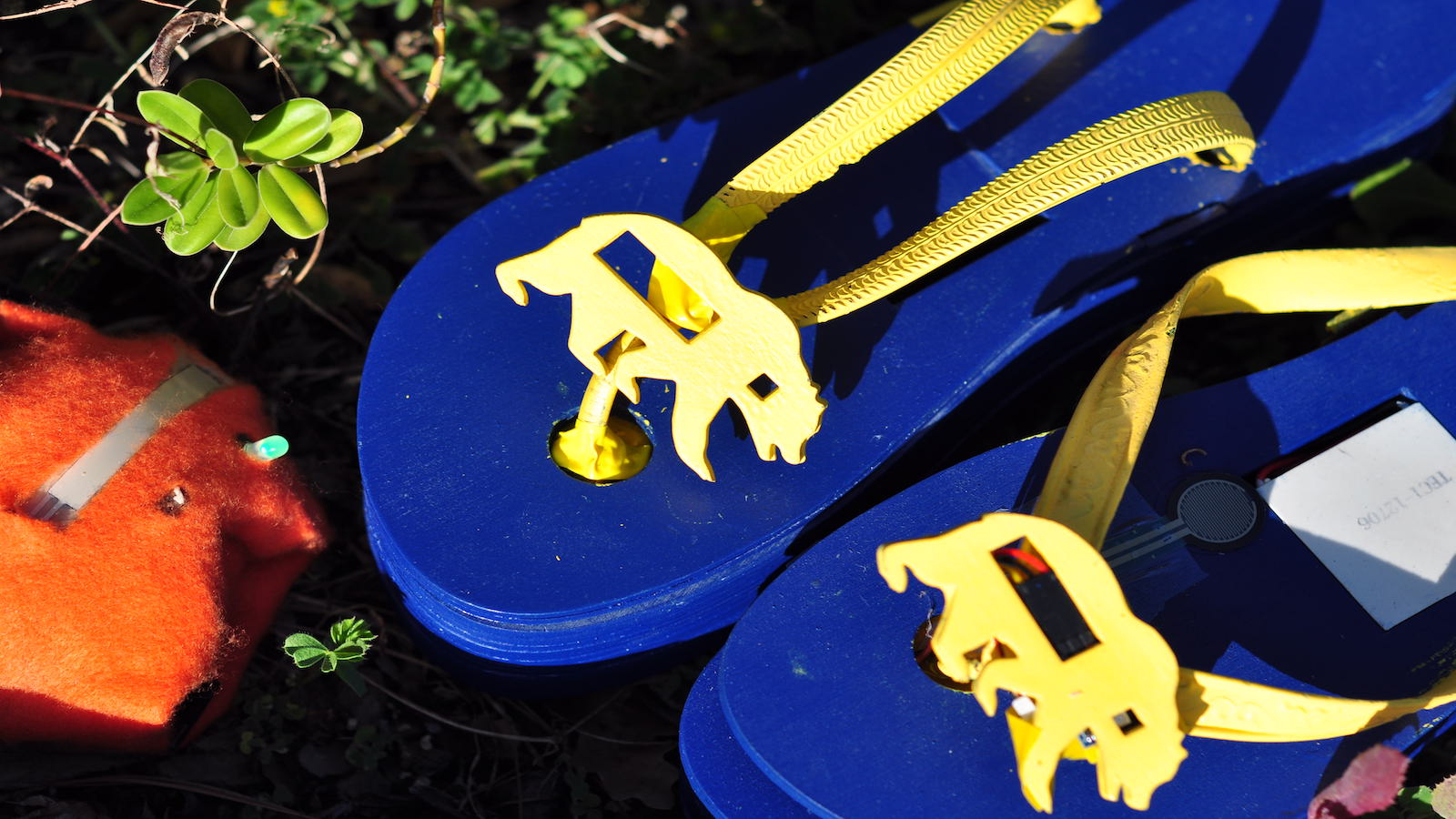
Flip-Fluvs
Carolyn Chen
Michelle Kim
Alyssa Li
Yang Liu
Christina Pappas
Flip-Fluvs are wearables designed to help wearers enjoy sunny weather safely. A UV sensor on the Flip-Fluv detects UV rays and triggers a haptic motor on the shoe to vibrate and an LED on the wristband to light up and notify the wearer that they should apply sunscreen. The wearer then uses the wristband to input the SPF they used, which then resets the notification cycle. This triggers the Peltier in the shoe to cool down and provide the user with the reward of a soothing cold sensation. The design was inspired by the fact that sunscreen is a simple but often elided method of protecting one’s skin and body from the various health detriments of UV rays. Since sunlight is usually considered to be positive, people are often unaware of how vigilantly they should protect themselves from its negative effects. Flip-Fluv is intended to increase their awareness and proactiveness against sun damage.
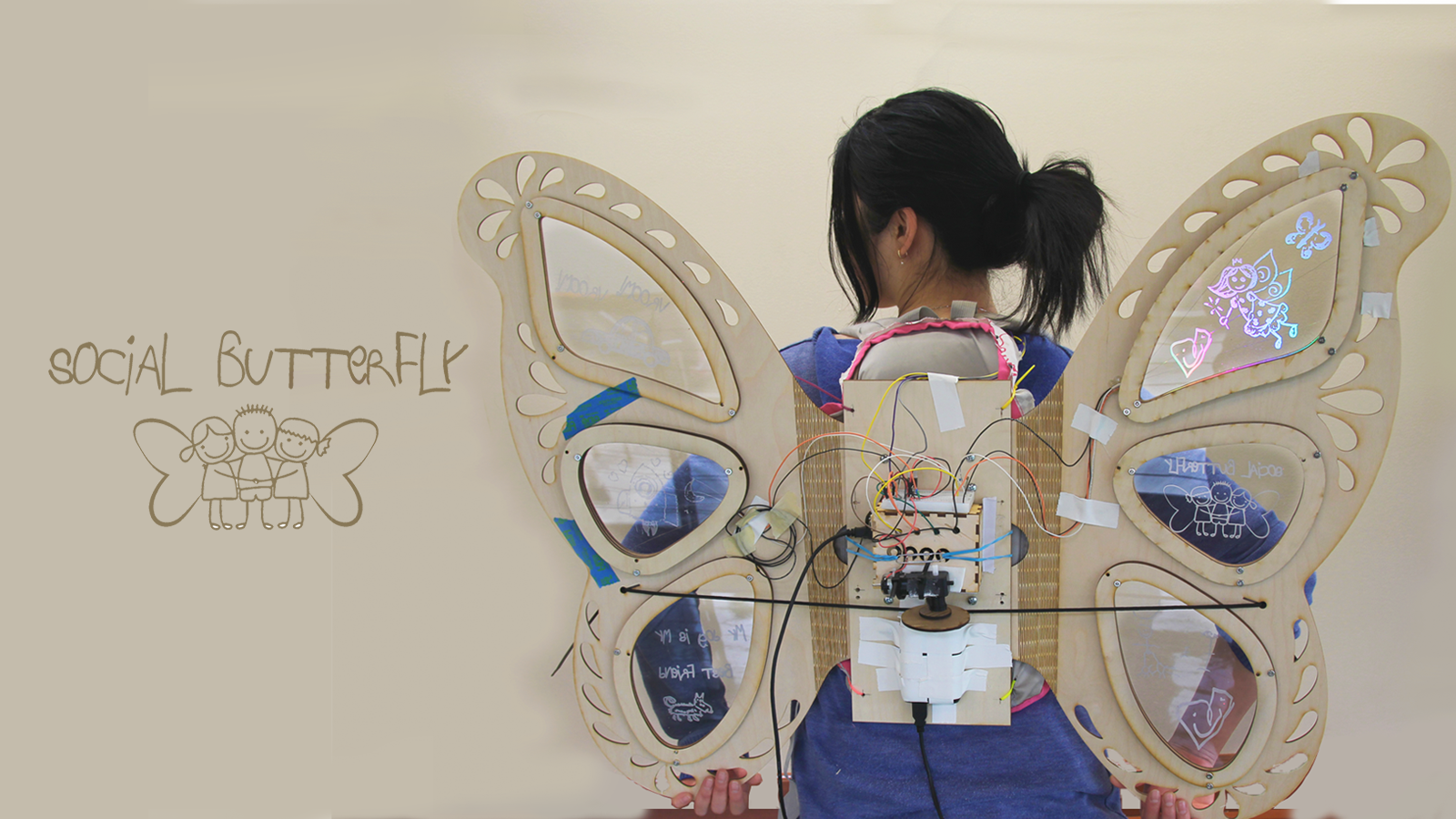
Social Butterfly
Justine Chia
Vivian Liu
Yuki Zhan
Varna Vasudevan
Kids who are just entering the social world may have a hard time getting out of their comfort zone when all they know is the cocoon of home. Social anxiety disorder can begin during formative elementary school years, resulting in low confidence in social situations. This can lead to trouble developing and maintaining friendships. Current solutions in schools include activities that encourage a positive learning environment and healthy social communication. Social Butterfly encourages this activity-based socialization using wings as a medium, capturing the playfulness, confidence, and larger-than-life personality associated with wearing wings. The wearer can attract the attention of nearby playmates by triggering a motor-actuated fluttering motion. Our wings also celebrate creativity and foster conversation – children can draw and write on six panels to create a set of visual, personalized conversation topics. Playmates can touch a fragment of the wing mosaic, which illuminates a panel as a conversation starter.
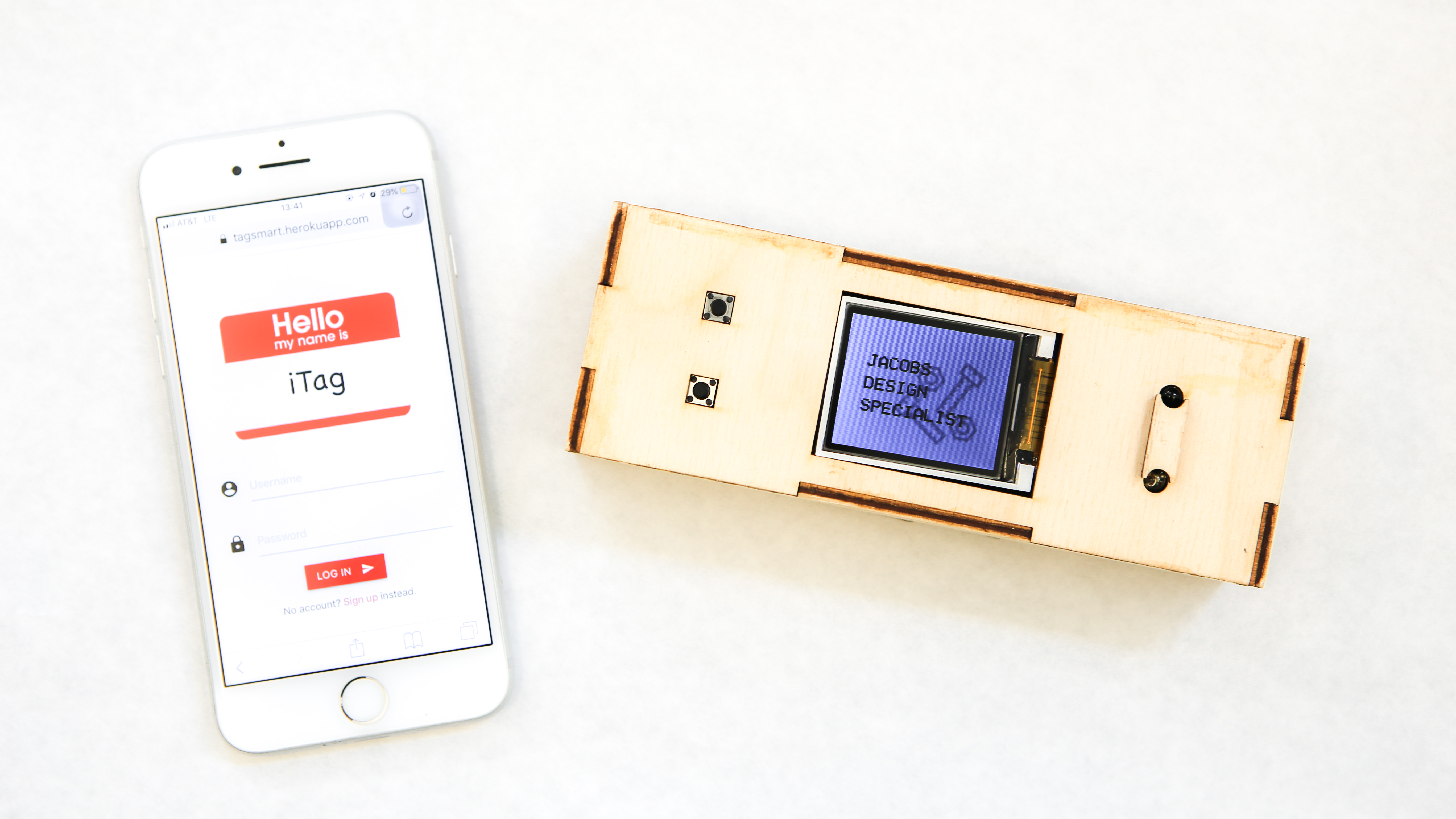
iTag
Essie Xu
Carina Sauter
Arnaud Bard De Coutance
Sally Tran
Vineet Nair
In the age of hyper connectivity, people are always on their phones, texting, calling, scrolling through social media...Real life human connections seem to be less and less important. We wanted to create a product that fosters in-person interactions between people. iTag is an all-in-one smart name tag for business networking, socializing, self expression, etc. To use iTag, you input your information on the iTag portal using your smartphone. This data connects to the iTag screen which can display a variety of information onto a screen, based on your purpose of use. There are a variety of modes available that can display your LinkedIn information, your emotional state, or hobbies you like. In any case, iTag is a device that can encourage and facilitate in-person communication between people.
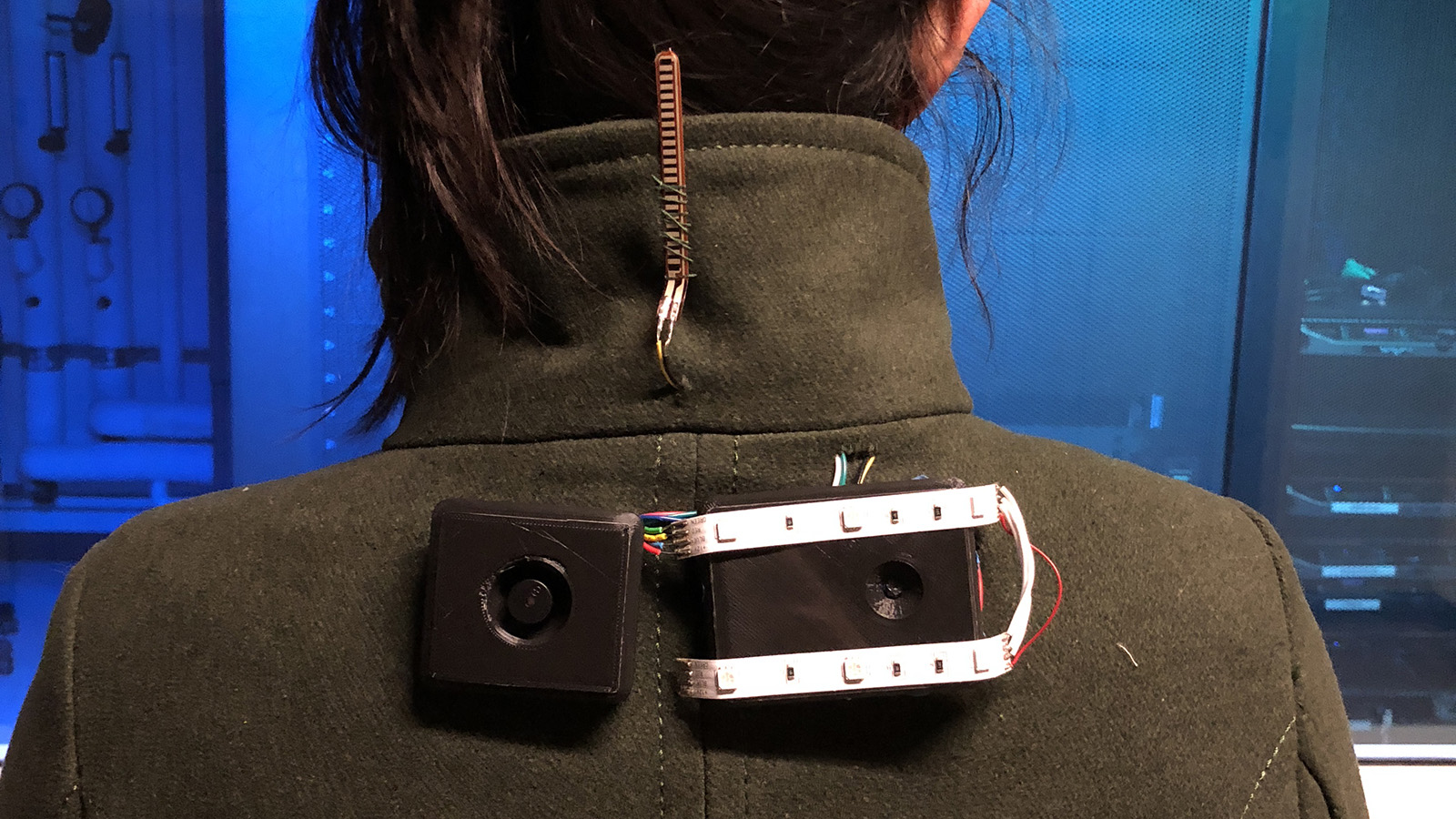
PaniCam
Kiran Delneuville
Nisha Pathak
Purva Jauvekar
Yayu Zheng
PaniCam is a wearable device, hidden in one's collar which helps the wearer safely journey home at night. Containing a camera, a piezo speaker and an alarm light system, PaniCam helps the wearer feel secure by providing video footage of a potential assailant, while emitting light and sound in order to scare the assailant away. PaniCam is contained within the collar of the wearer's jacket, and is activated as soon as the wearer feels like she or he is in a potentially dangerous situation. By popping their collar, the wearer activates the camera, recording the potential assailant. Should the assailant make a move, the wearer can then activate an audible and visual alarm via a small capacitive touch button located on the tip of the collar. PaniCam is a discrete, subtle solution to the dangerous realties of walking along at night.
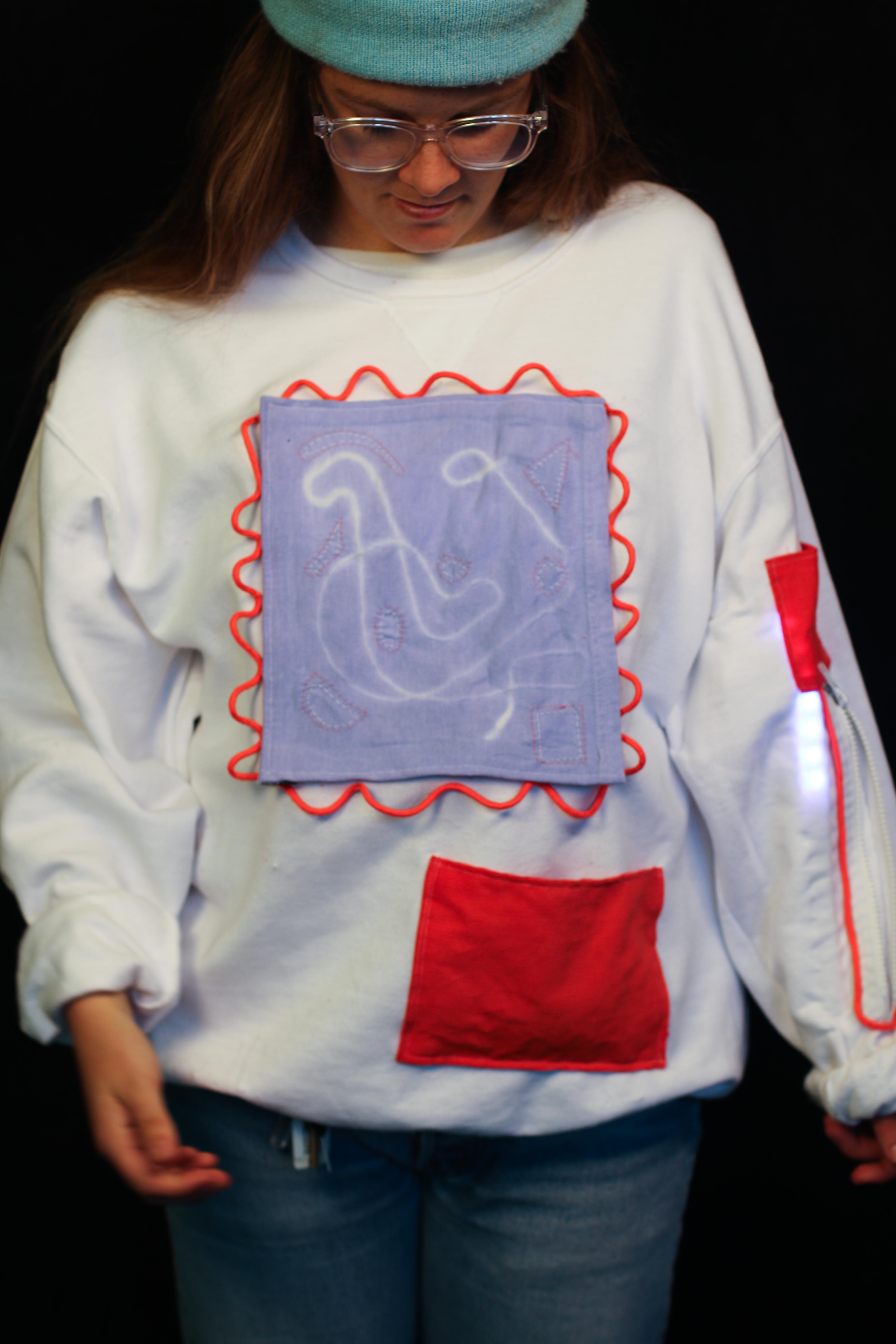
TheraSTITCH
Fiona Duerr
Advaita Patel
Conor Farese
Lieyah Dagan
TheraSTITCH helps individuals overcome panic attacks by giving them distractions, a breathing guide, and a visual symbol of their progress. Individuals suffering from anxiety often struggle with hyperventilation when a panic attack occurs. Breathing exercises and distraction can be used to overcome the attack by re-centering the user. While TheraSTITCH is designed to have a variety of distracting material for users to play with, the main interaction focuses around a zipper built into the sleeve to mediate users’ their breathing. At the onset of a panic attack, an LED trail will light up on the sleeve to guide the user through slow, 4-count breathing. Upon successful completion of four slow breaths, a unique image reveals itself on the user’s front patch, using thermochromic fabric to highlight and celebrate their progress. TheraSTITCH is a prototype of a line of textiles aimed at bringing wearable technology to users with mental health challenges.
First Day of Class • Laptop Smash Performance
On the first day of class, I wanted to make a point about expectations – about expectations for this course and more importantly about leaving them behind as we enagage in the material and topics within Critical Making. Rather than say it or even show a slide, I unexpectedly and dramatically lifted "my" laptop and smashed it across the floor of the classroom. The video of the performance is shown below.
-
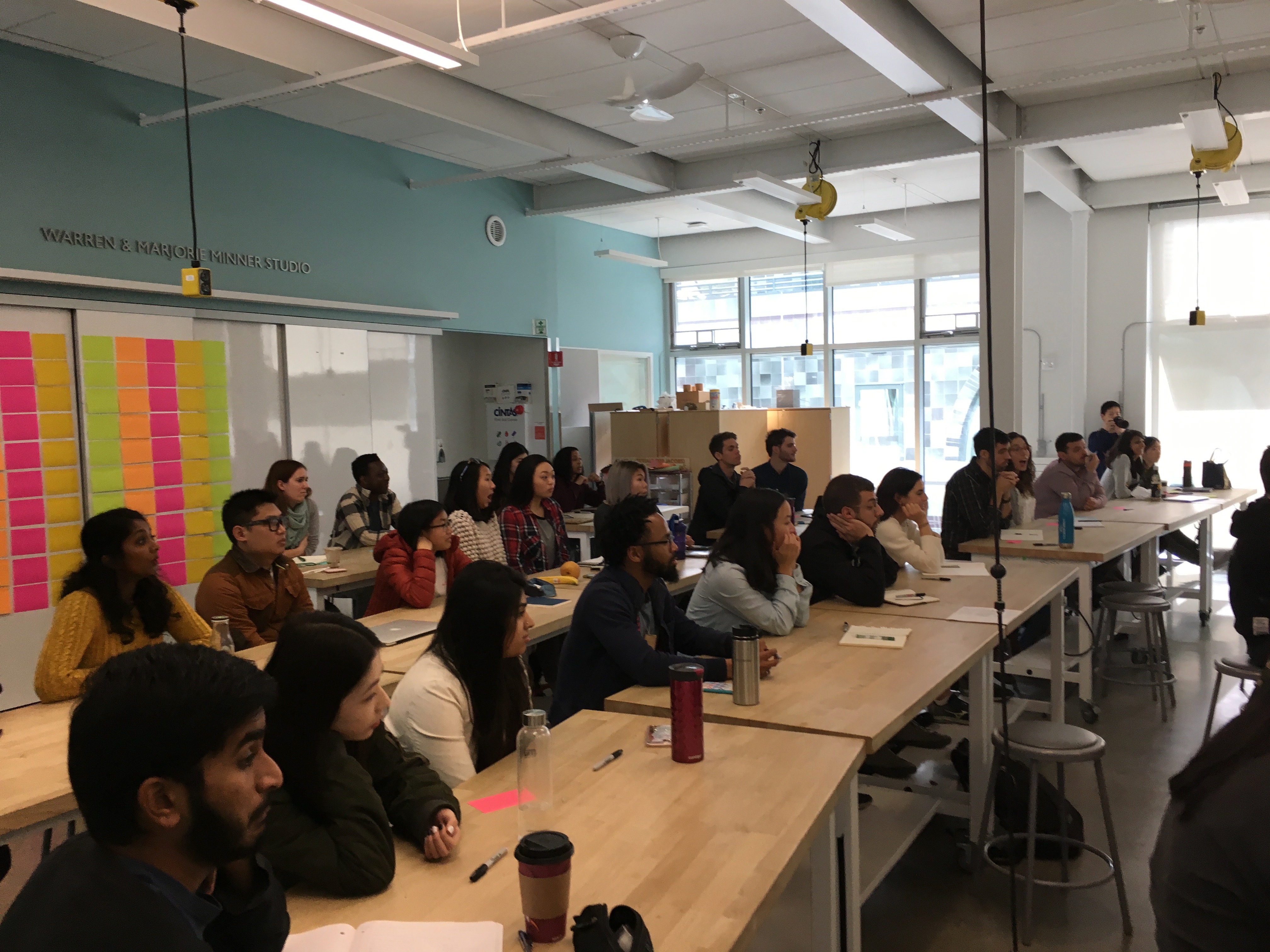
Class Reaction 1
Laptop Smash -
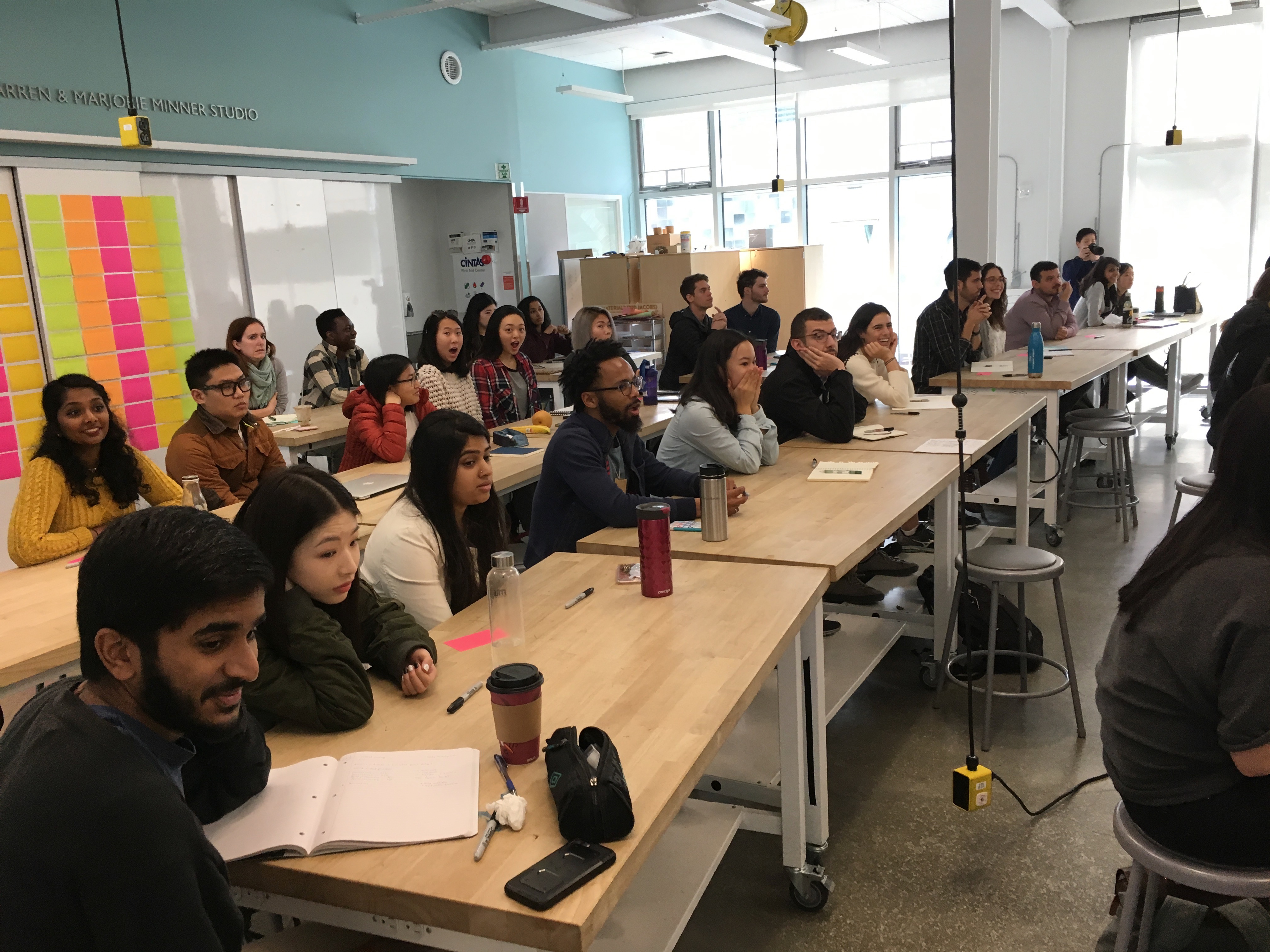
Class Reaction 2
Laptop Smash -
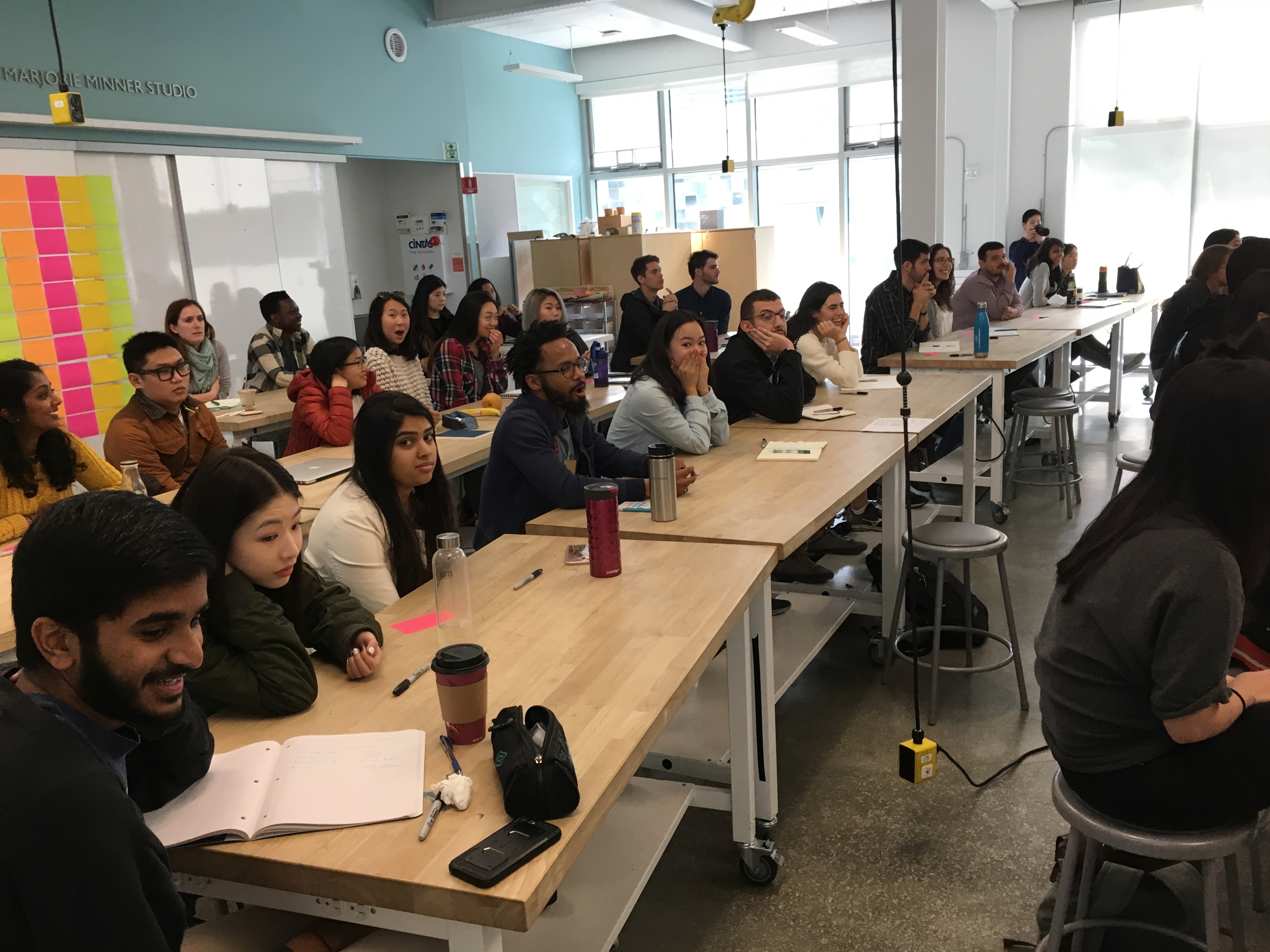
Class Reaction 3
Laptop Smash -

Final State
Laptop Smash
This is the making of the performance. I located a non-functional laptop headed for excess and salvage with help from Eric Fraser and Jon Kourda here at UC Berkeley. I carefully planned the event. I wanted the impact to be dramatic, so I removed the bottom of the laptop and all of the internal components. Then I carefully placed them all back into the laptop enough so that the bottom would still close completely. I left everything unscrewed and loose inside the laptop including the bottom to ensure it would impact dramatically and not just be a hard thud.
Next, I setup the room, ensuring that the impact area would be clear and safe and also that I could adequately conceal my real laptop underneath using a haphazardly stacked set of design textbooks as camouflage. You can see my real laptop in the image below, carefully concealed underneath the broken laptop. I was able to easily advance my slides using a handheld remote control. I placed a board across, concealing my real laptop and then placed the staged laptop on top. A few more books covered up the board and a fake cable were attached to the broken laptop giving the illusion that all was normal – as expected.
-
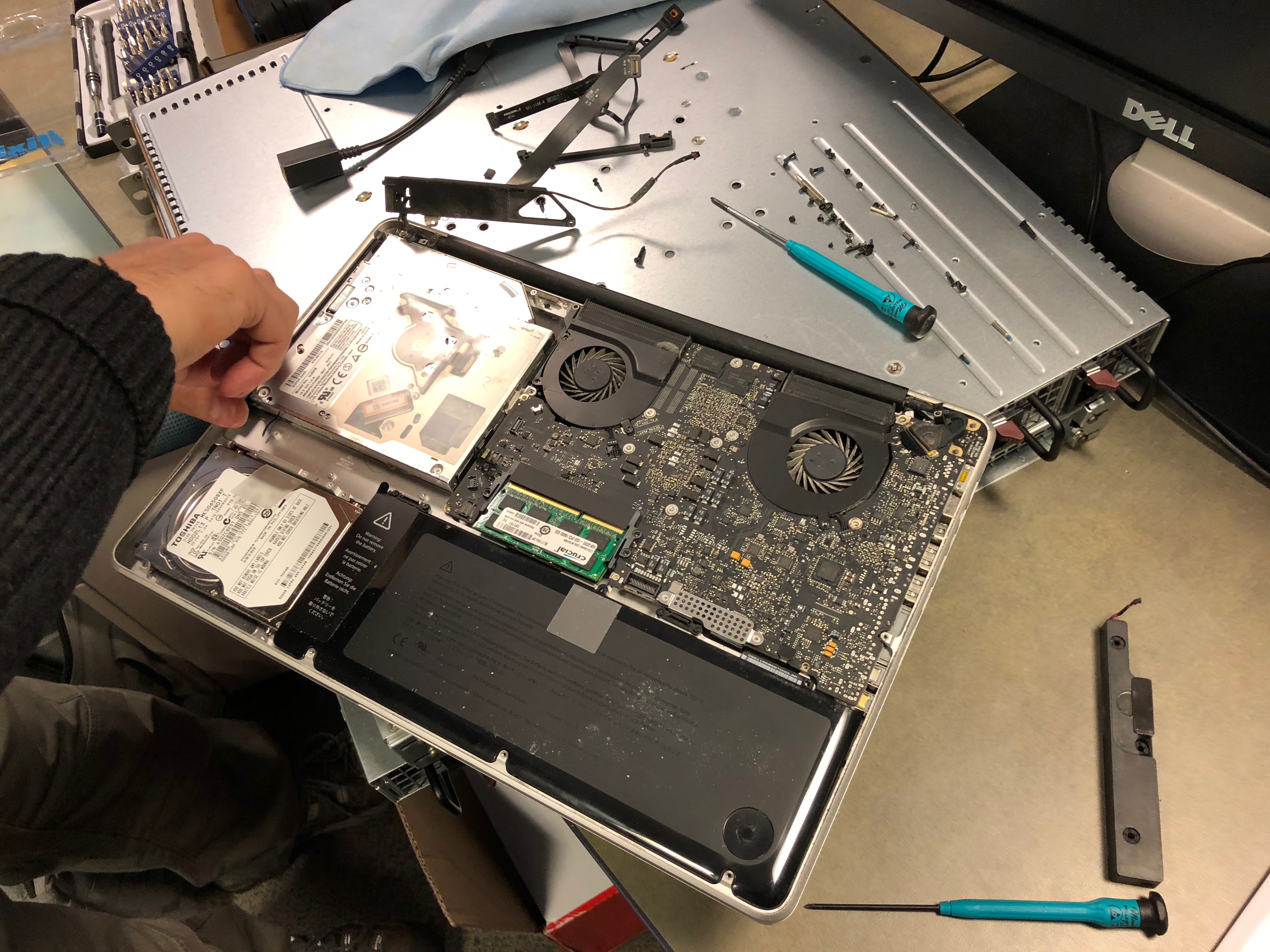
Disassembly
Laptop Smash -
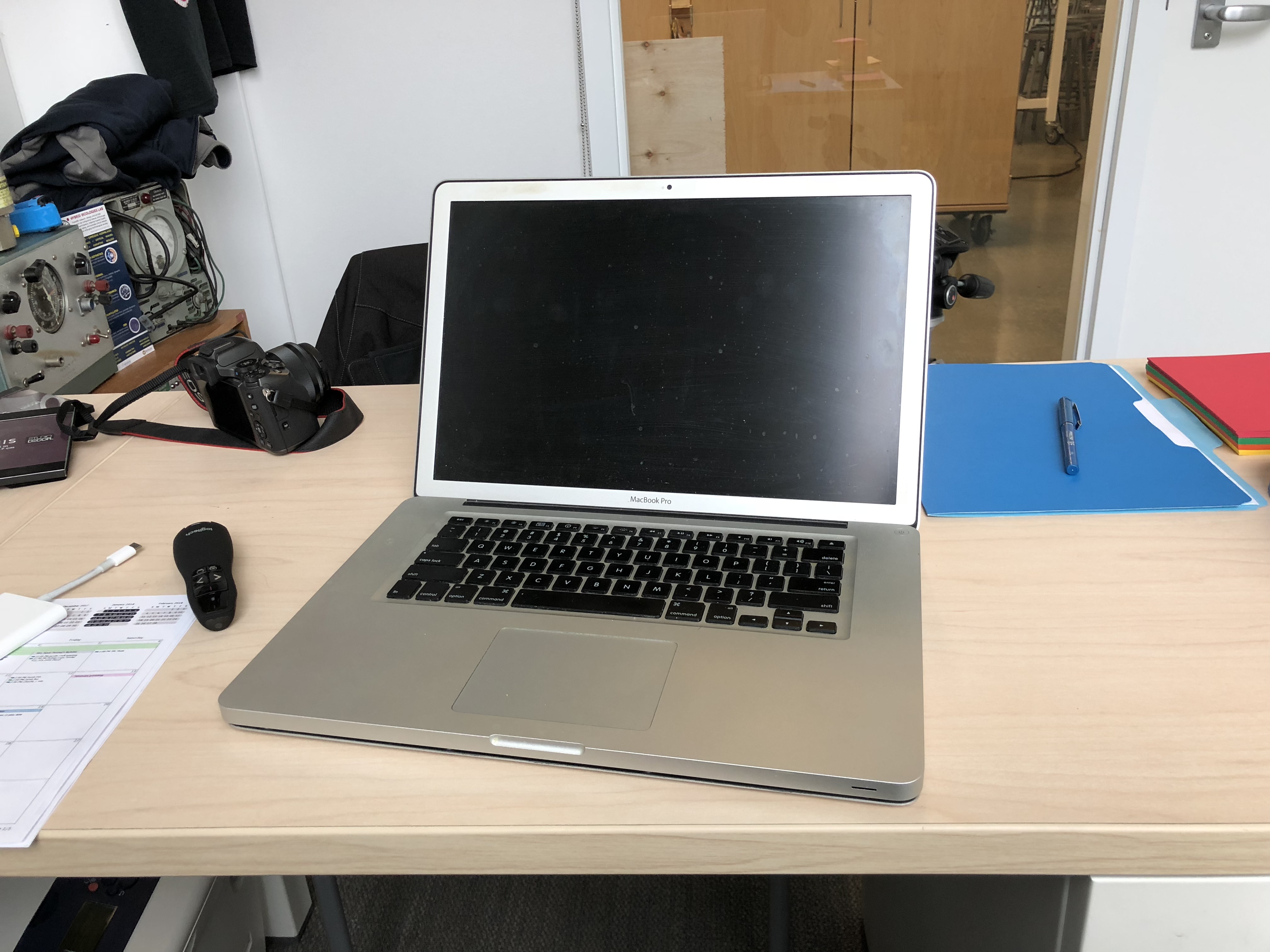
Precariously Resting
Laptop Smash -
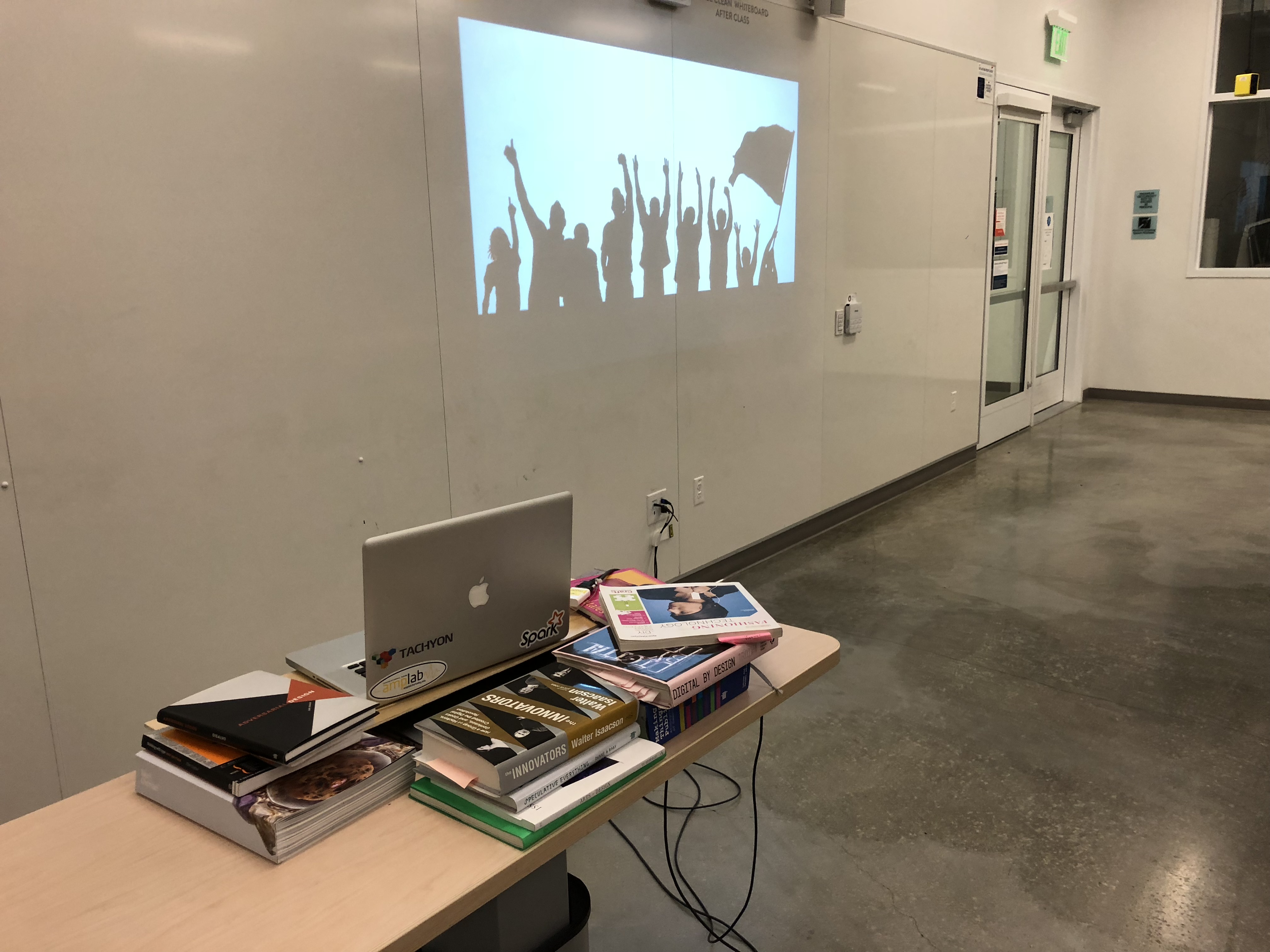
Classroom Setup
Laptop Smash -
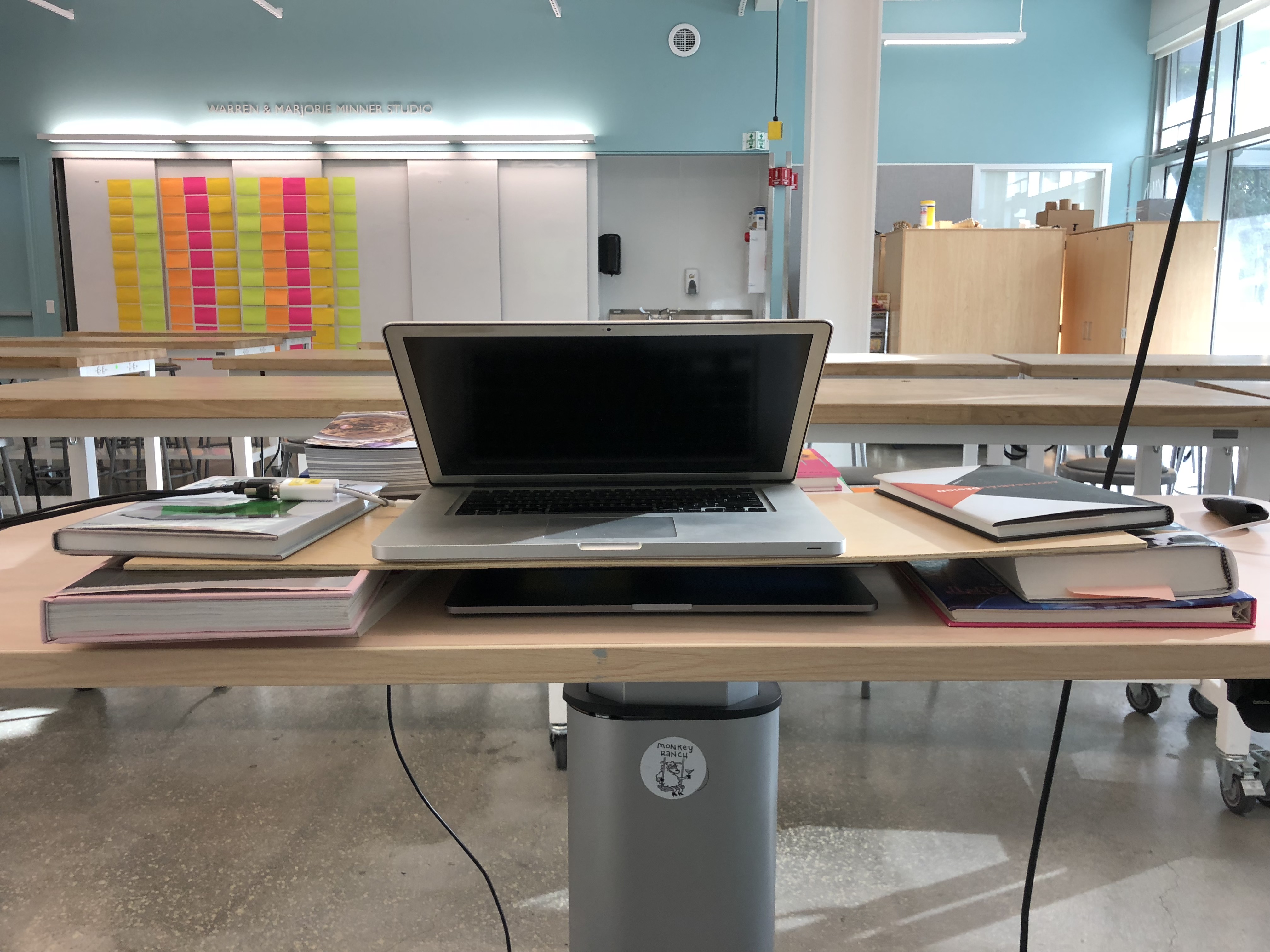
Hidden real laptop
Laptop Smash
I rehearsed the staging, where I would stand, what I would say, and how I would grab the laptop. Remember the bottom of the laptop would completely fall apart if lifted improperly. Finally, I made sure to come very early to class where my GSI, Christie Dierk, helped me get setup before any students arrived.
Class started and everything went smoothly. I asked everyone to introduce themselves by giving their name, what they study, an artists or scientist they admire, and something they DID NOT do over winter break. When it came to me I added that "I had not smashed a laptop over break" (a slight foreshadowing for what was to come 45 minutes later in class).
Finally, when the time came, my GSI, Christie distracted the class with an announcement while I ensured the camera was in position and I begin to stage the performance. When the moment came, I lifted the laptop and smashed it gloriously into the floor, causing it to fragment and shatter across the cement studio floor. A timed delay on the real slide deck displayed up a broken video signal and the class stopped in silence. When I had their attention, I called out our charge – to break from stereotypes, view the world through a lens of compassion, to be inclusive in all your actions, to make artifacts and experiences that are poetic and provocative, to use and develop your skills and passions to create change and to improve the lives and well being across communities, neighborhoods, society, and the world, and most of all to be the authentic you. At the end of the manifesto, everyone applauded and the performance ended. A few days later we critiqued and discussed the overall performance in class. And yes, the laptop parts all ended up properly recycled into electronic waste. Now back to class...let's make a difference!
Related performances include Spring 2017 Critial Making "Magic Wand" and Fall 2015 Critical Practices "Tour Group"
First Day of Class • Design Matrix
-
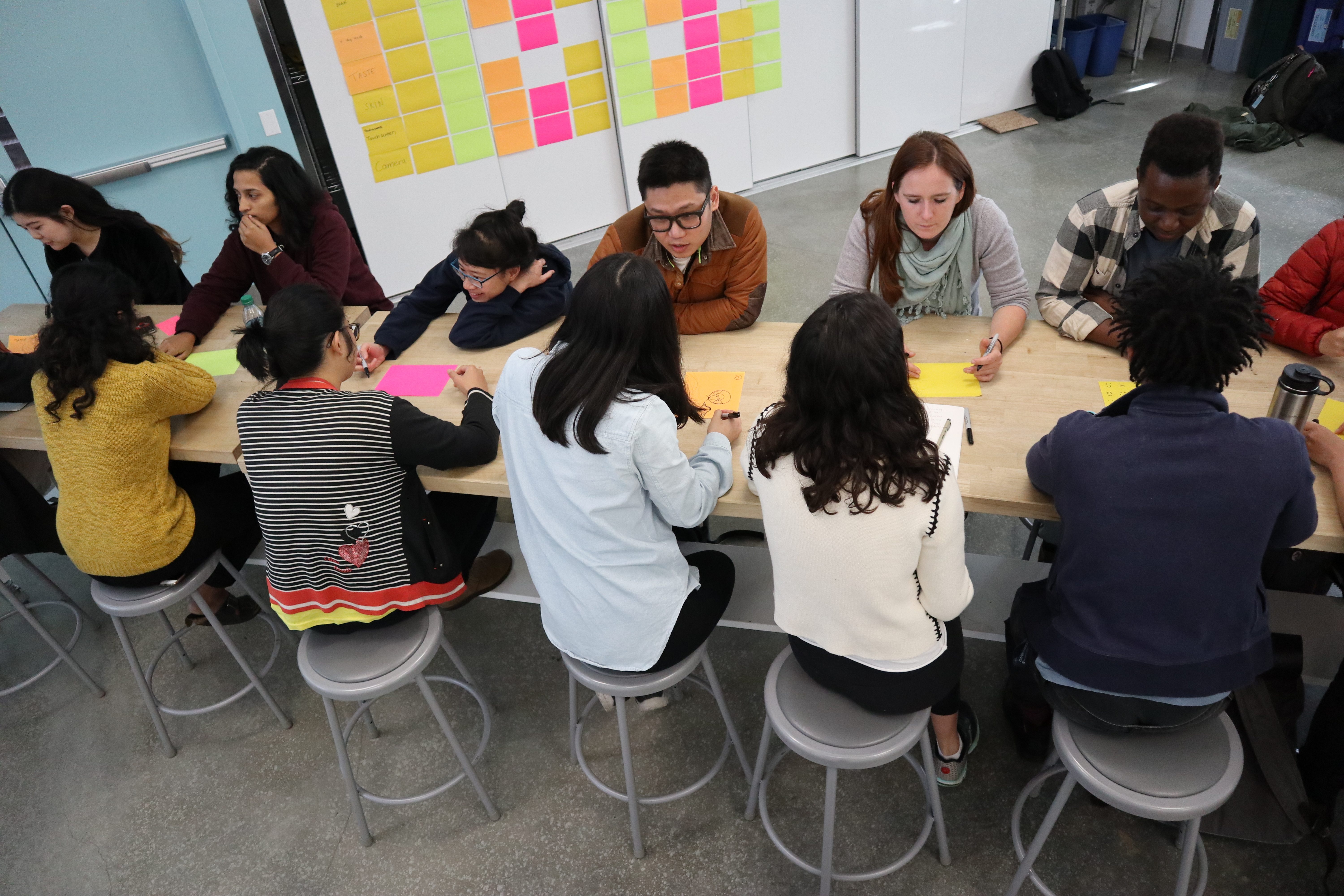
Design Matrix
First Class -
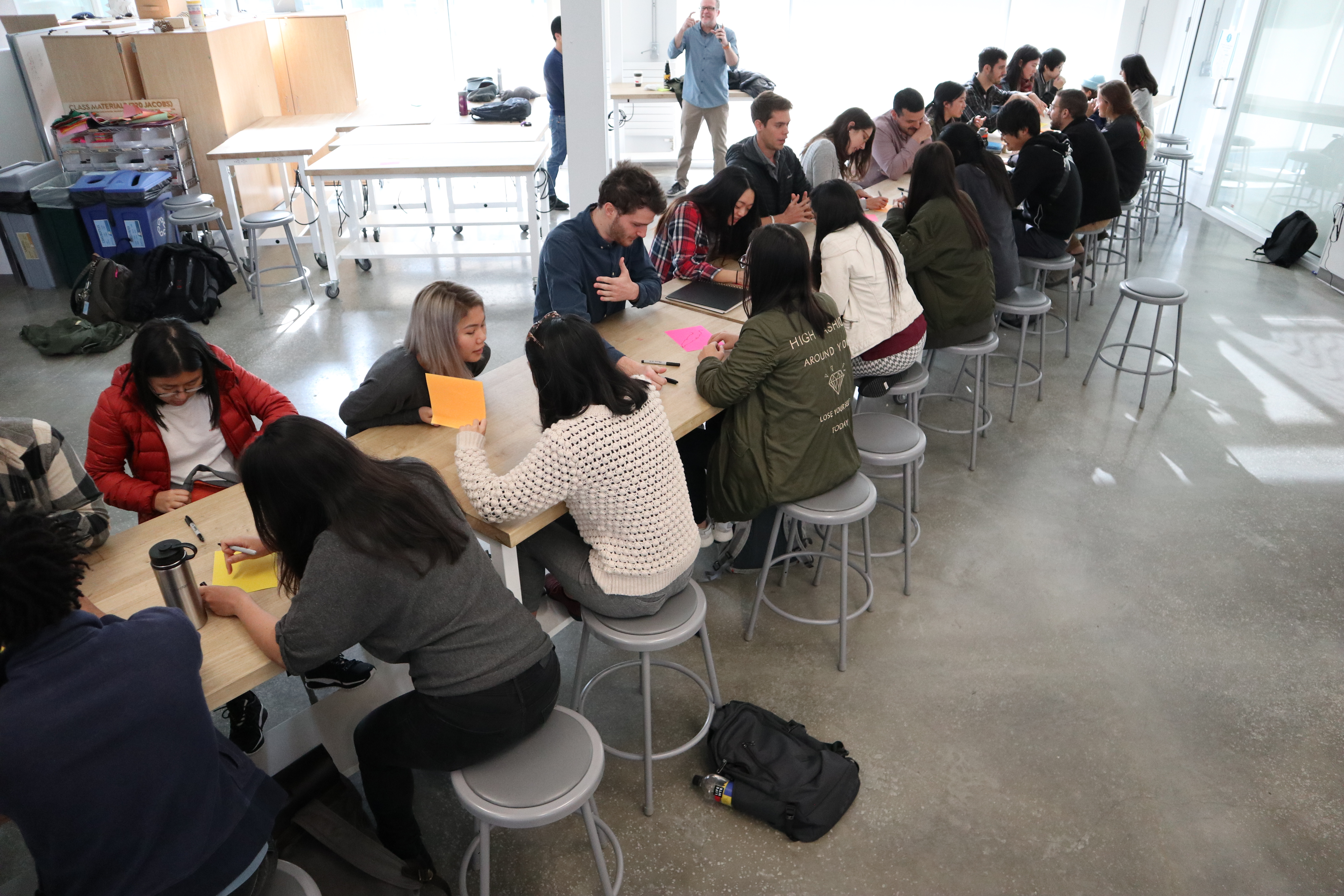
Design Matrix
First Class -

Design Matrix
First Class -
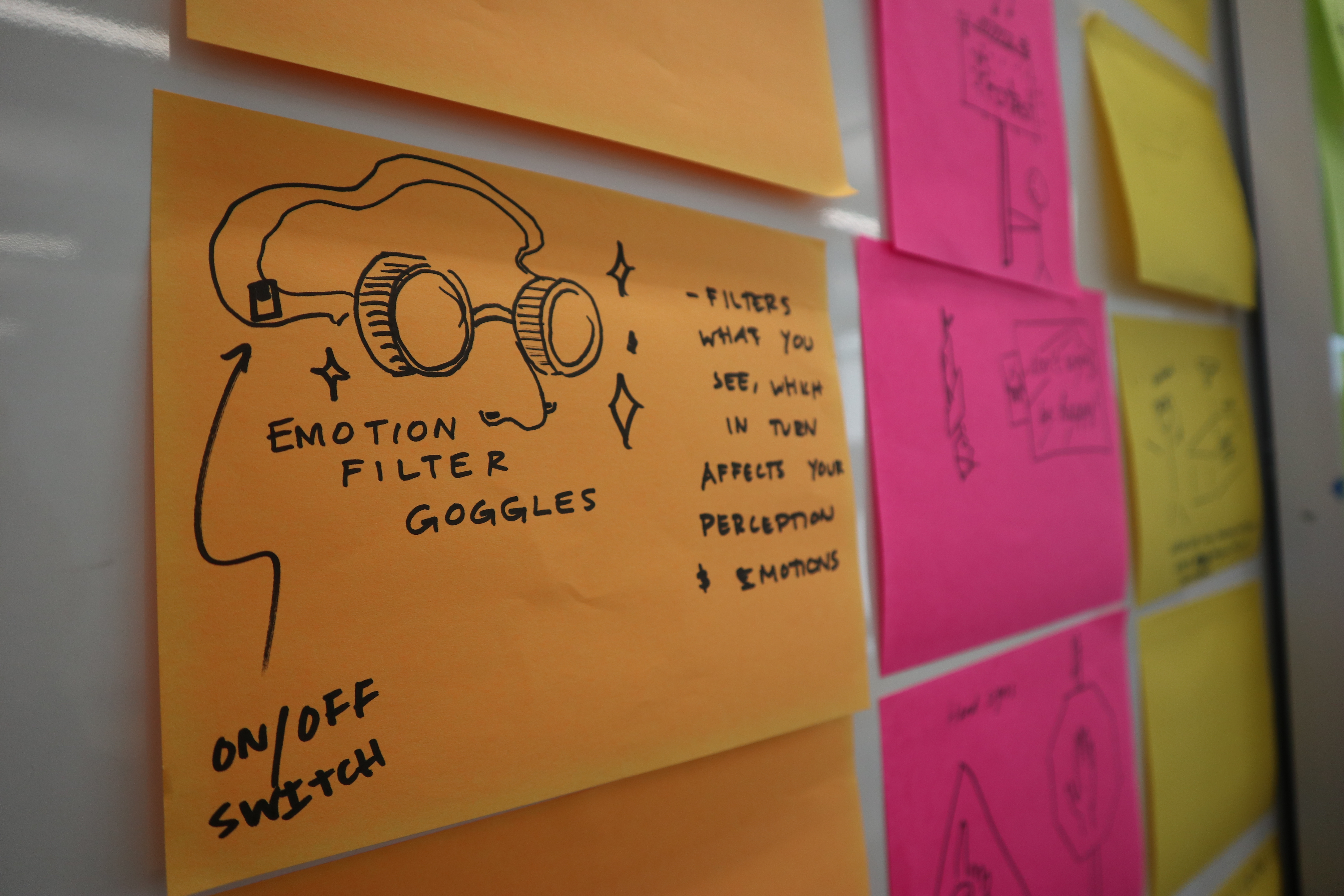
Design Matrix
First Class
Hyper Personal Protoyping Stand • In Class Field Activity
-
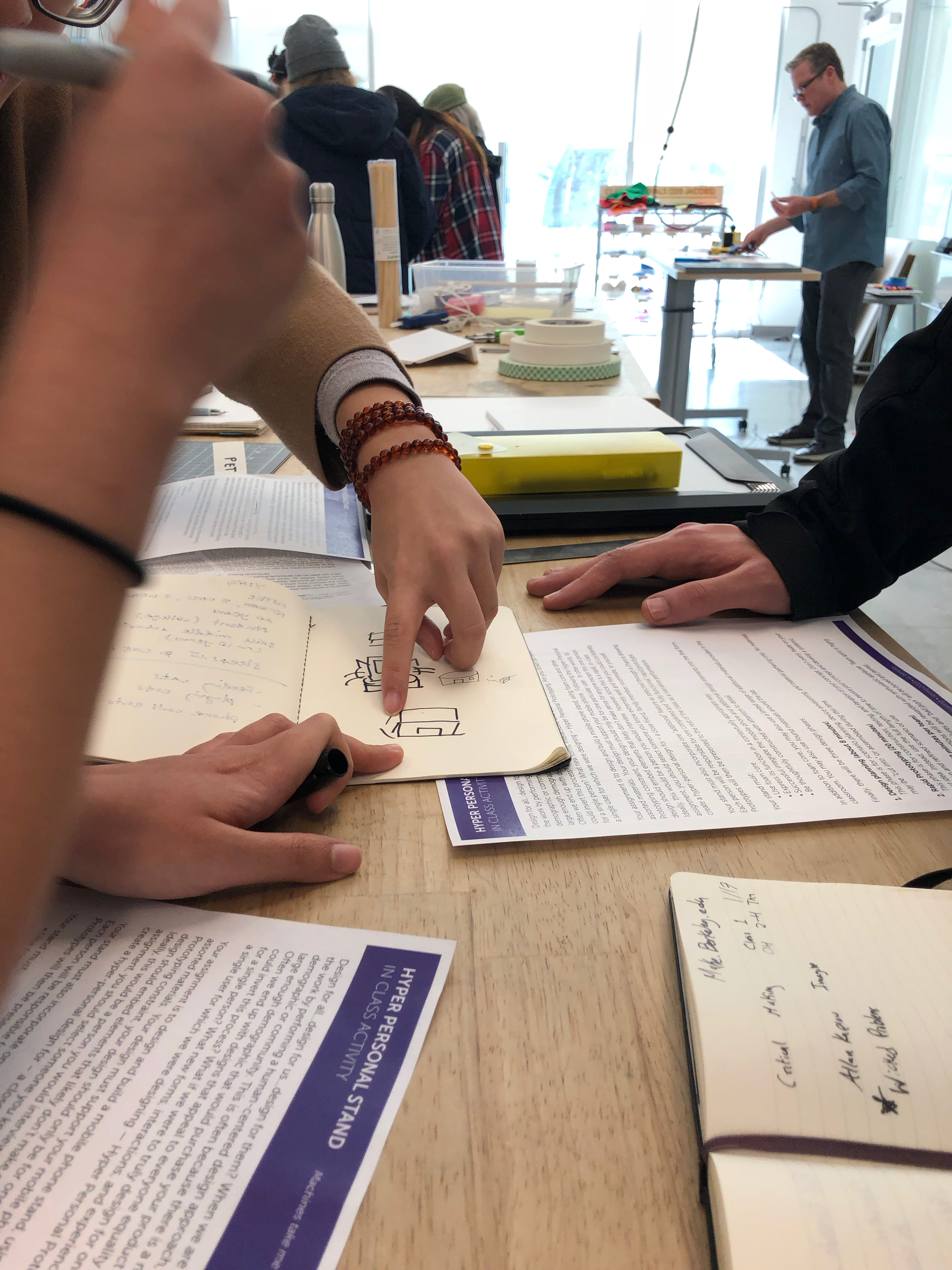
Hyper Personal Protoyping
In Class Field Activity -
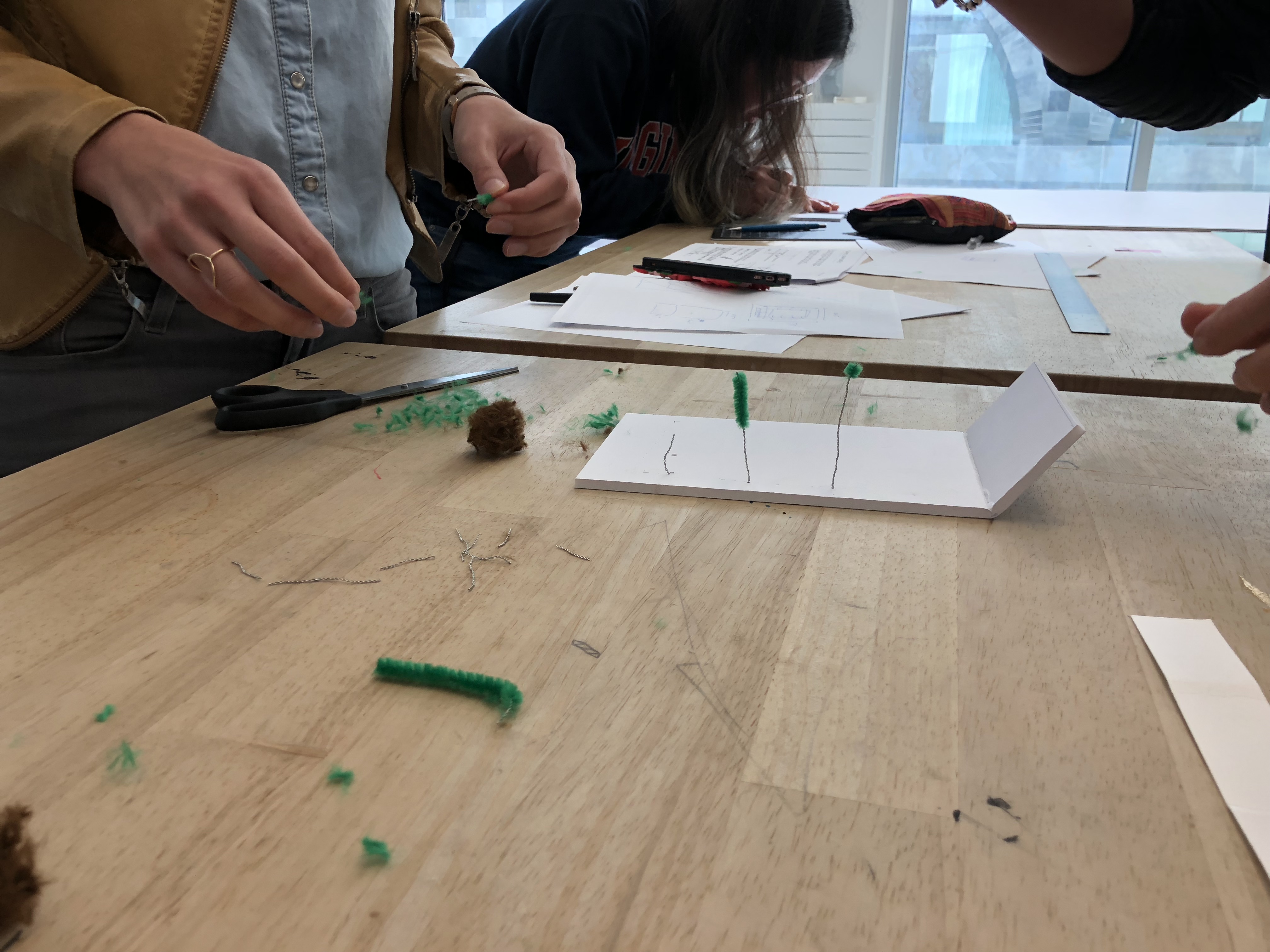
Hyper Personal Protoyping
In Class Field Activity -
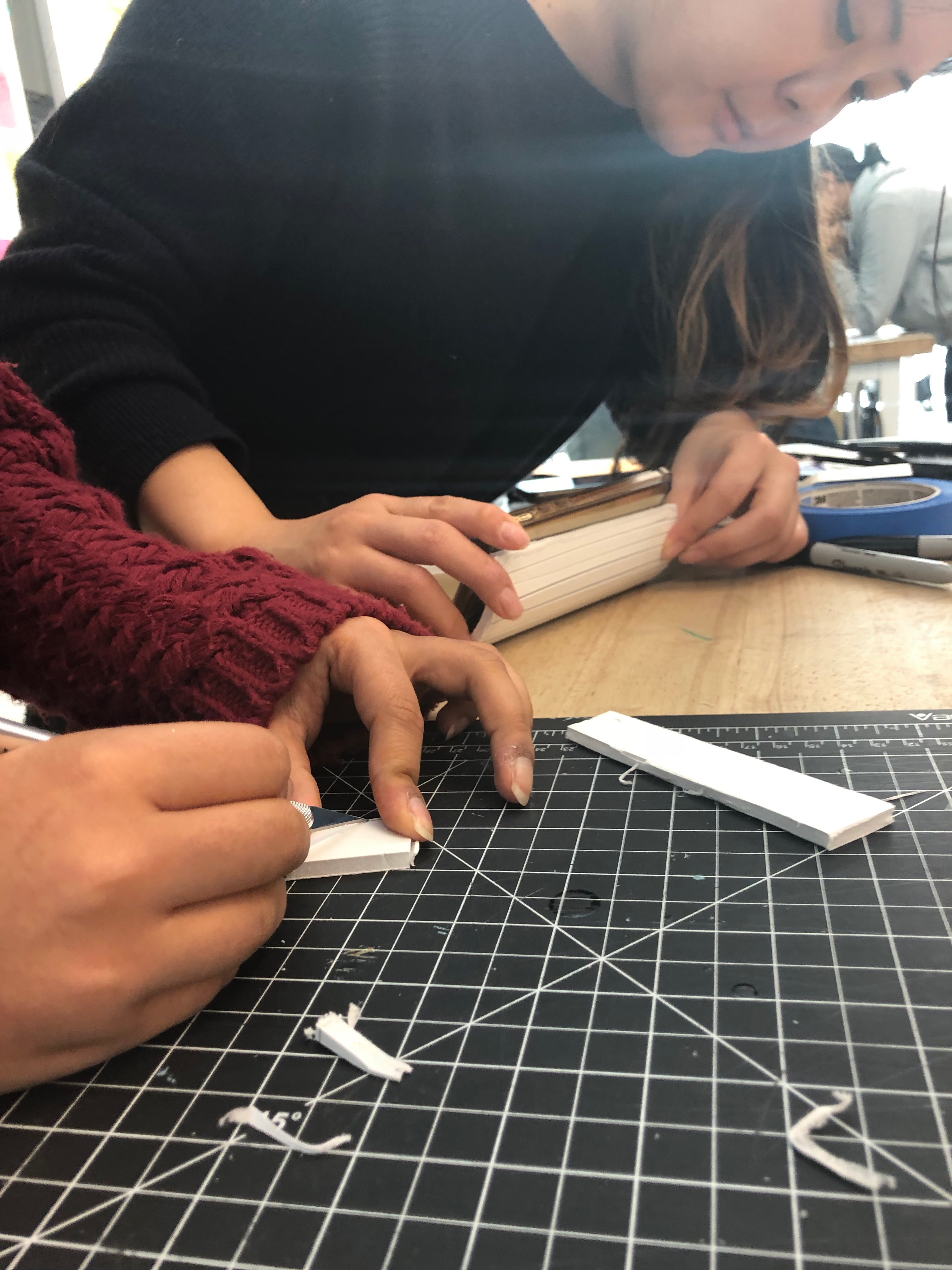
Hyper Personal Protoyping
In Class Field Activity -
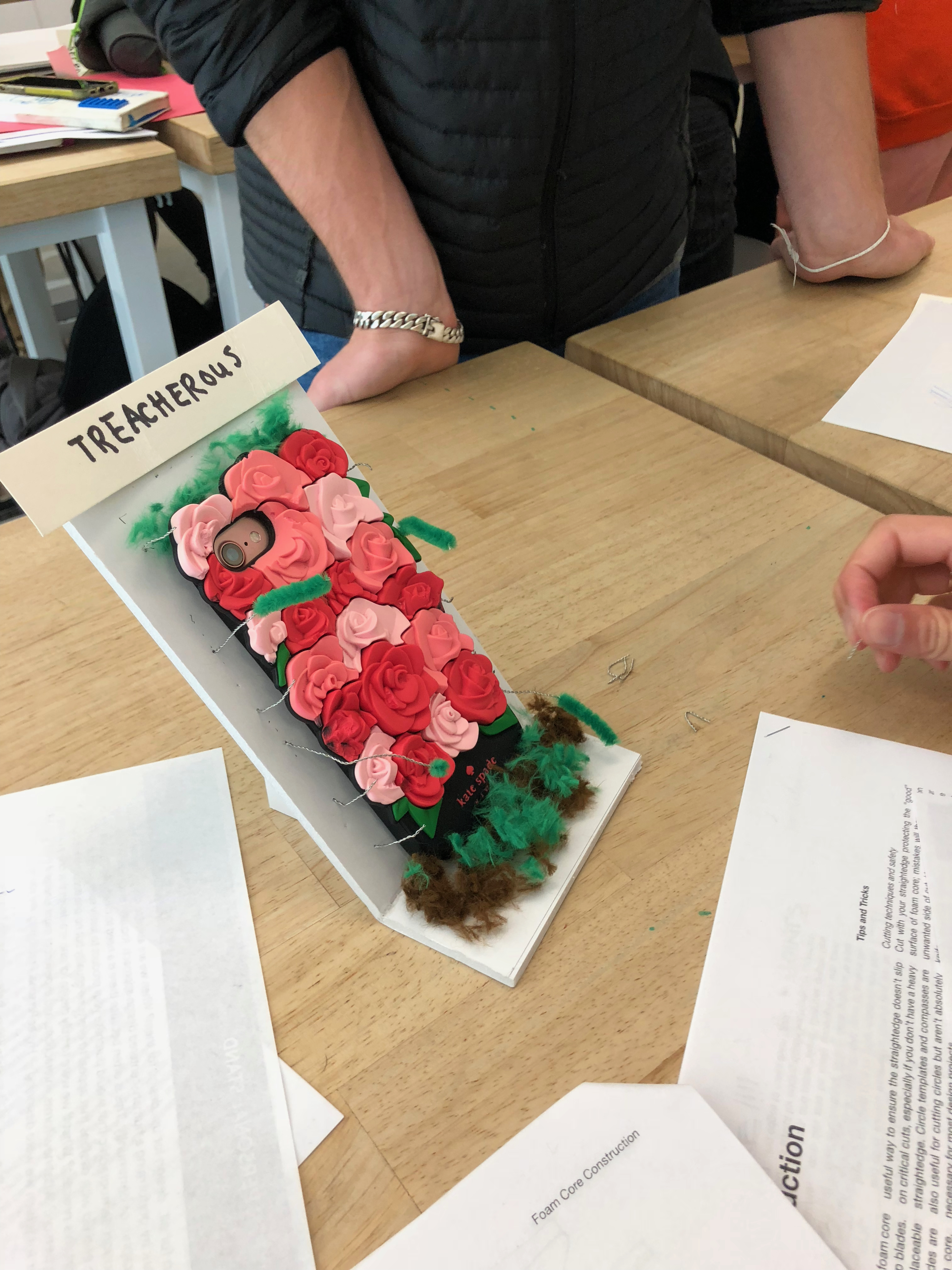
Hyper Personal Protoyping
In Class Field Activity
Sensory Cardboard • Field Activity 02
-
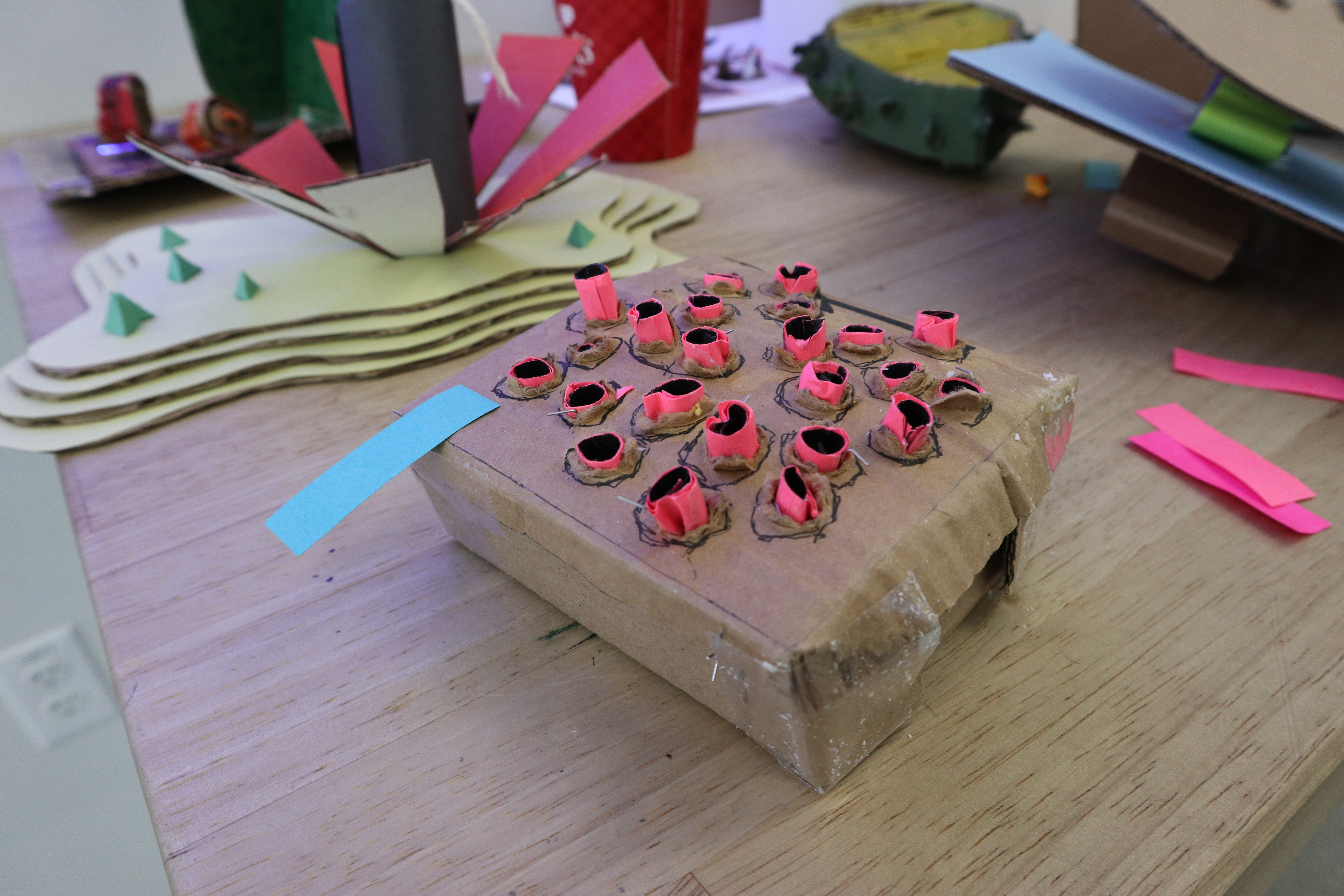
Sensory Cardboard
Field Activity 02 -

Sensory Cardboard
Field Activity 02 -
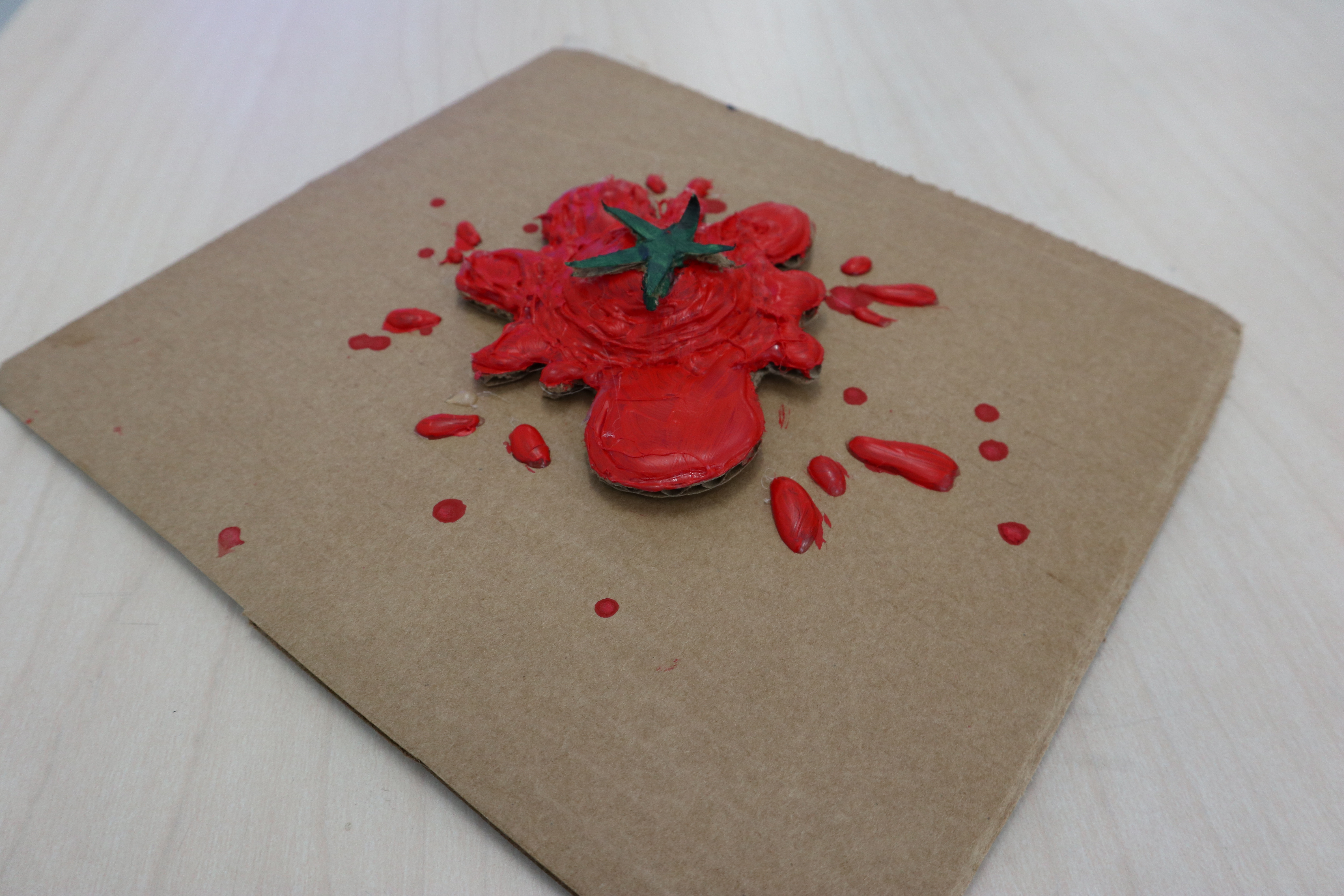
Sensory Cardboard
Field Activity 02 -
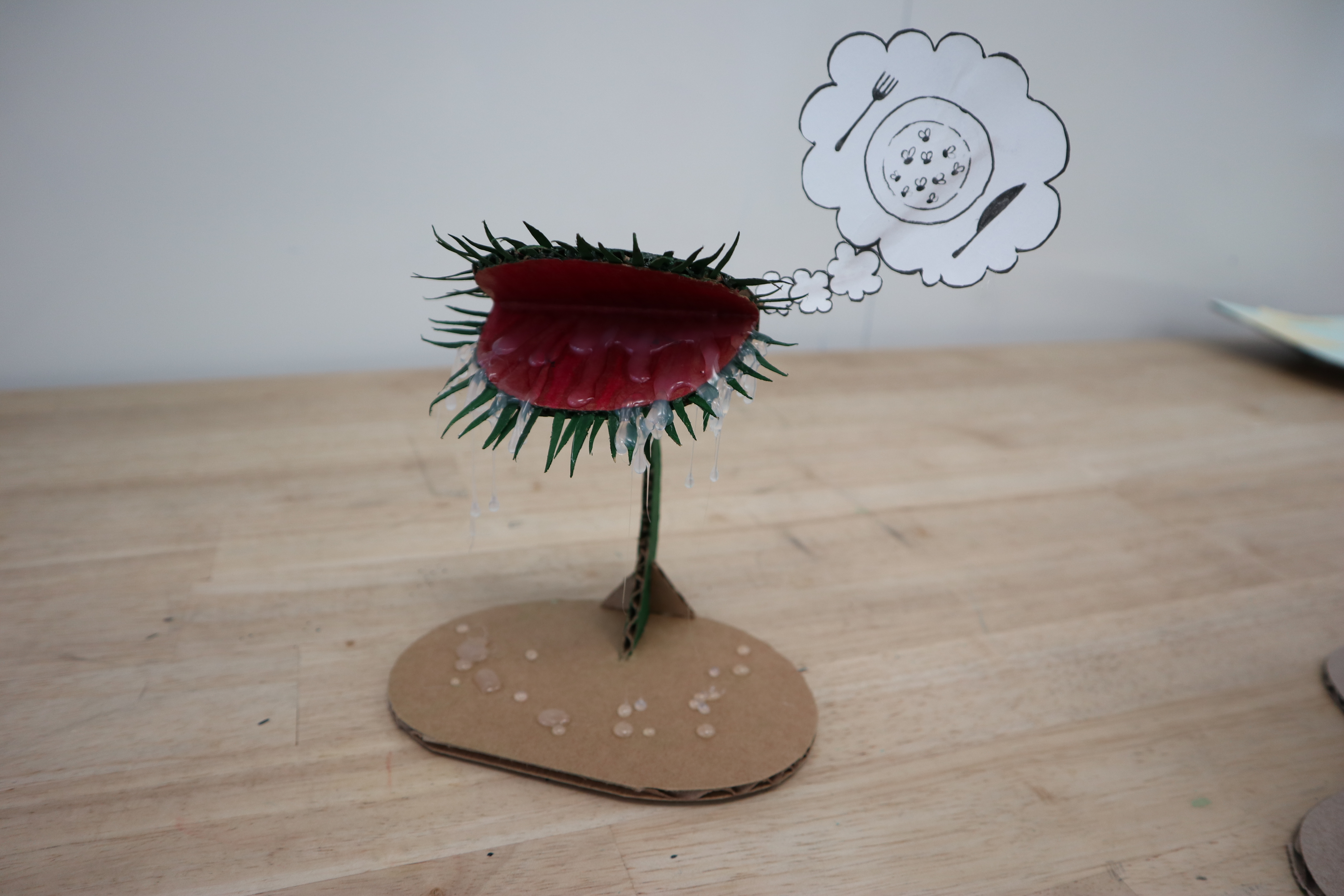
Sensory Cardboard
Field Activity 02
BoxIt • Field Activity 03
-
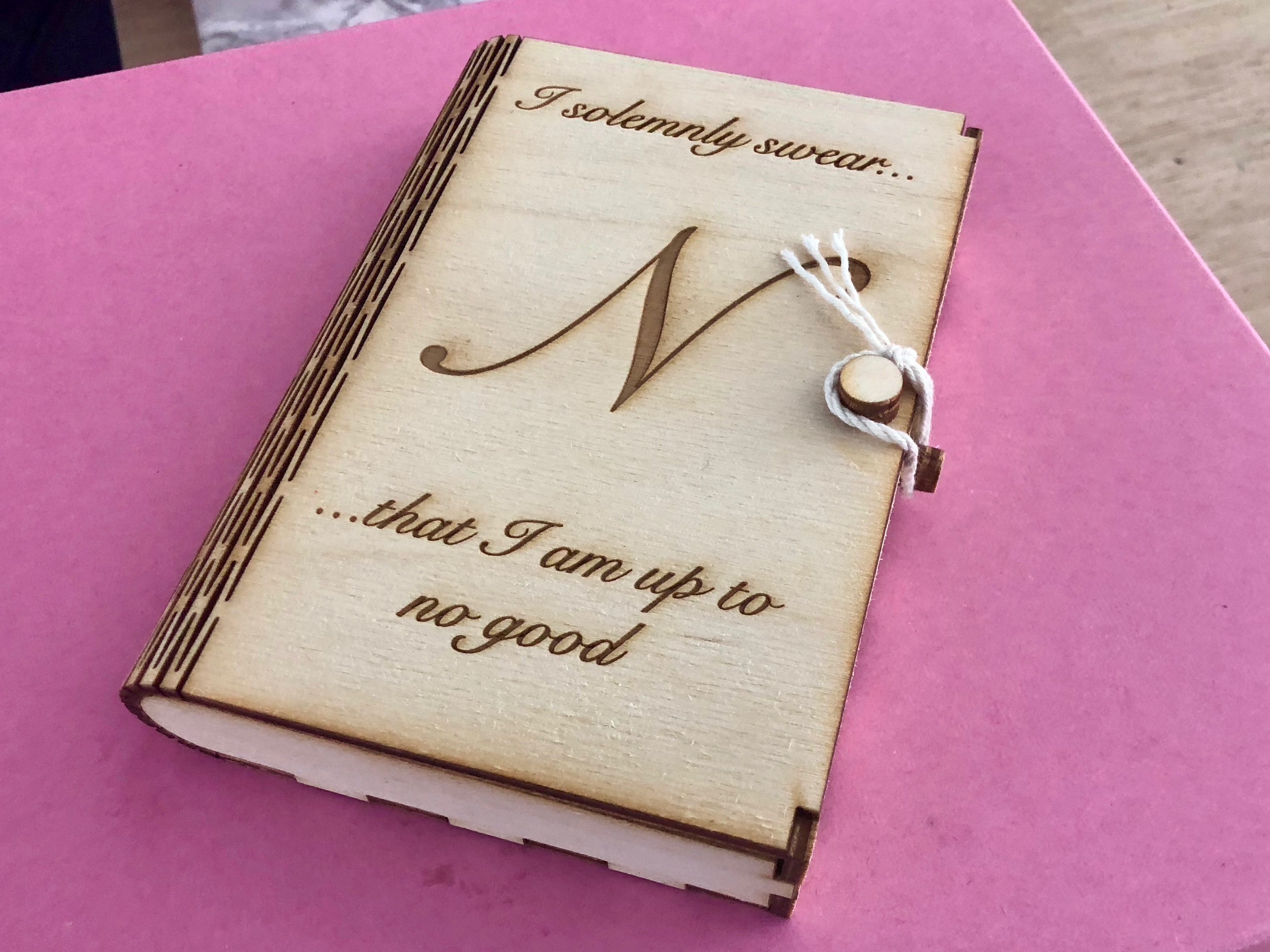
BoxIt
Field Activity 03 -
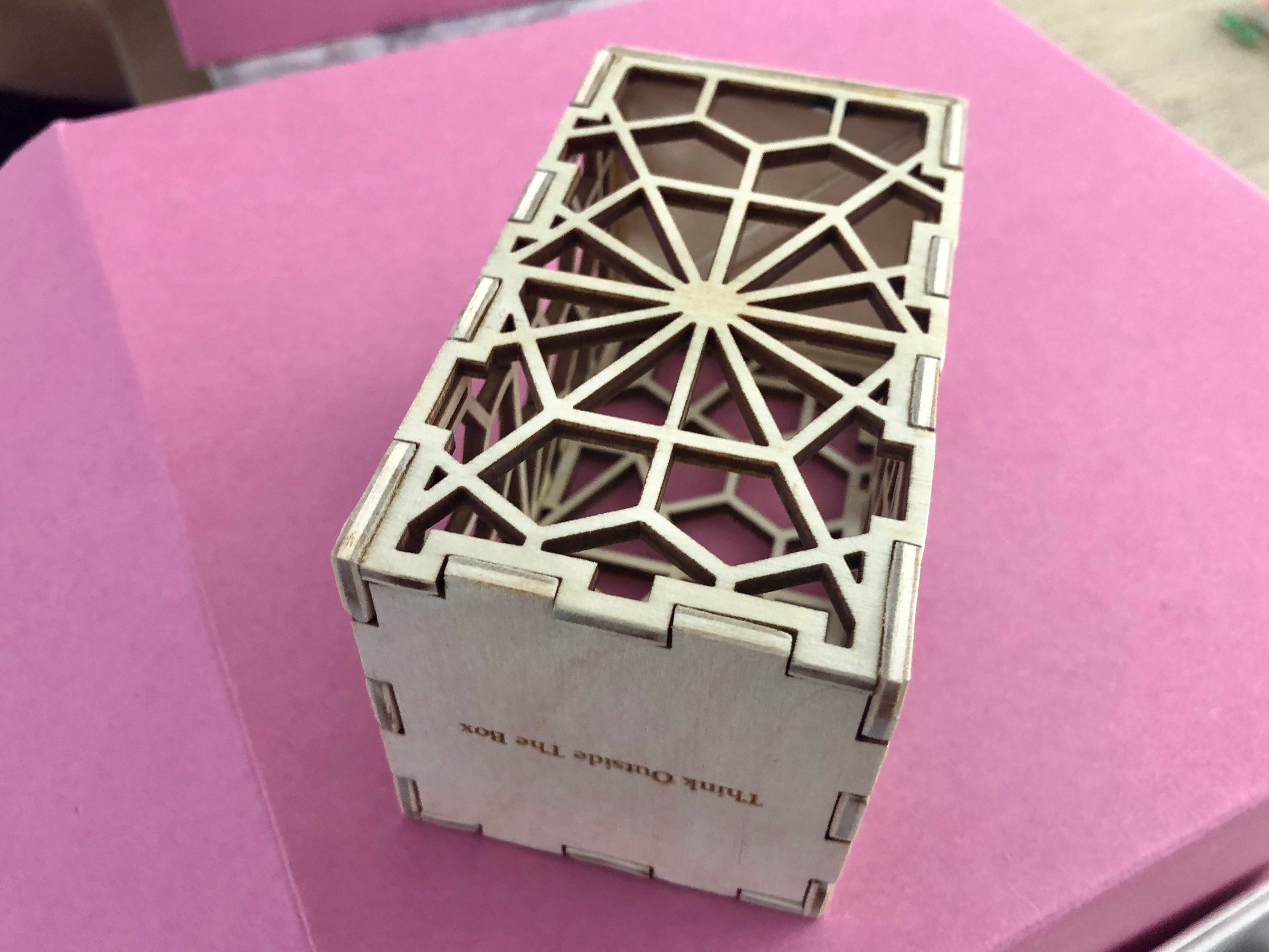
BoxIt
Field Activity 03 -
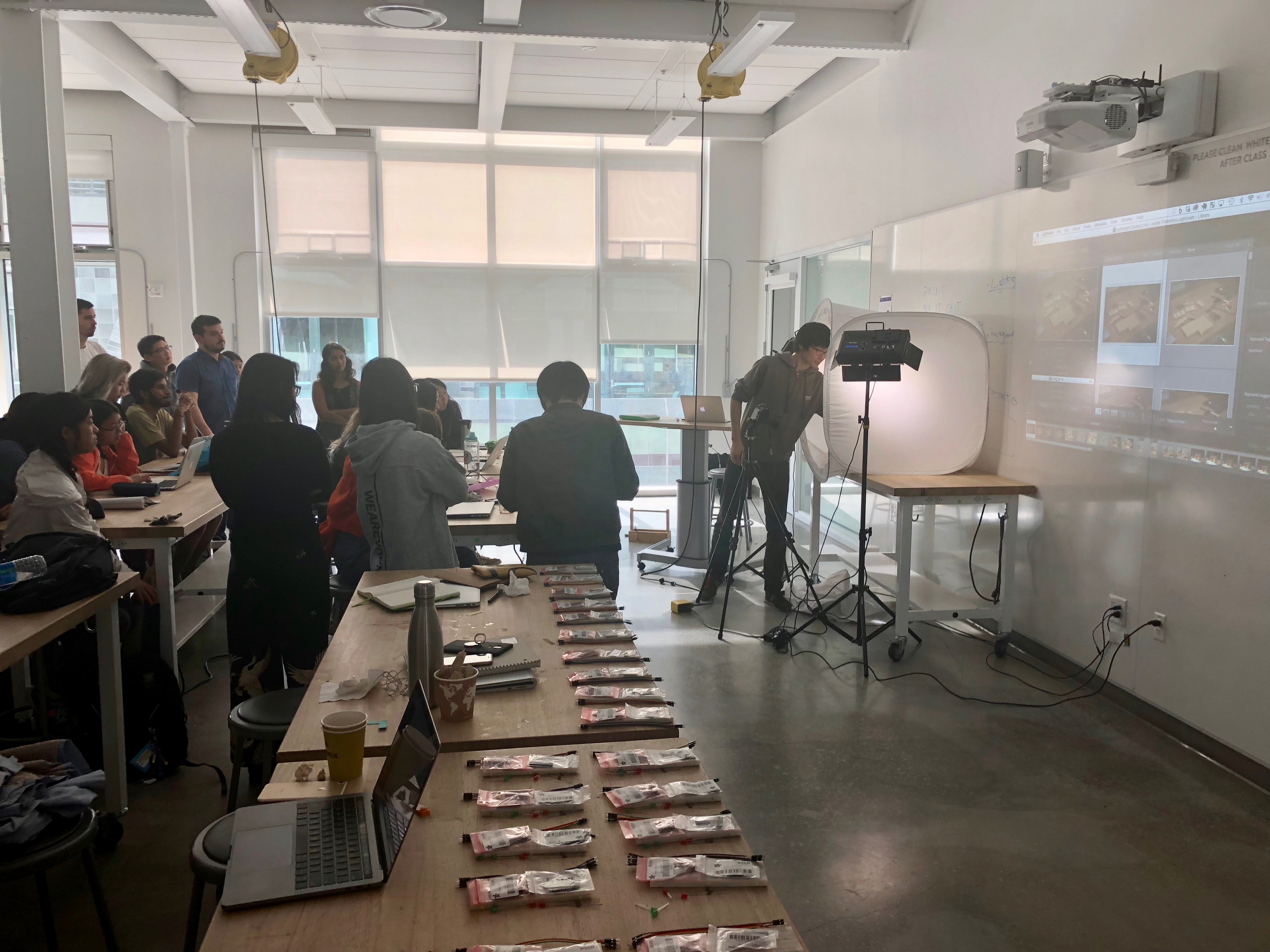
How to Document Work
How to Photograph -
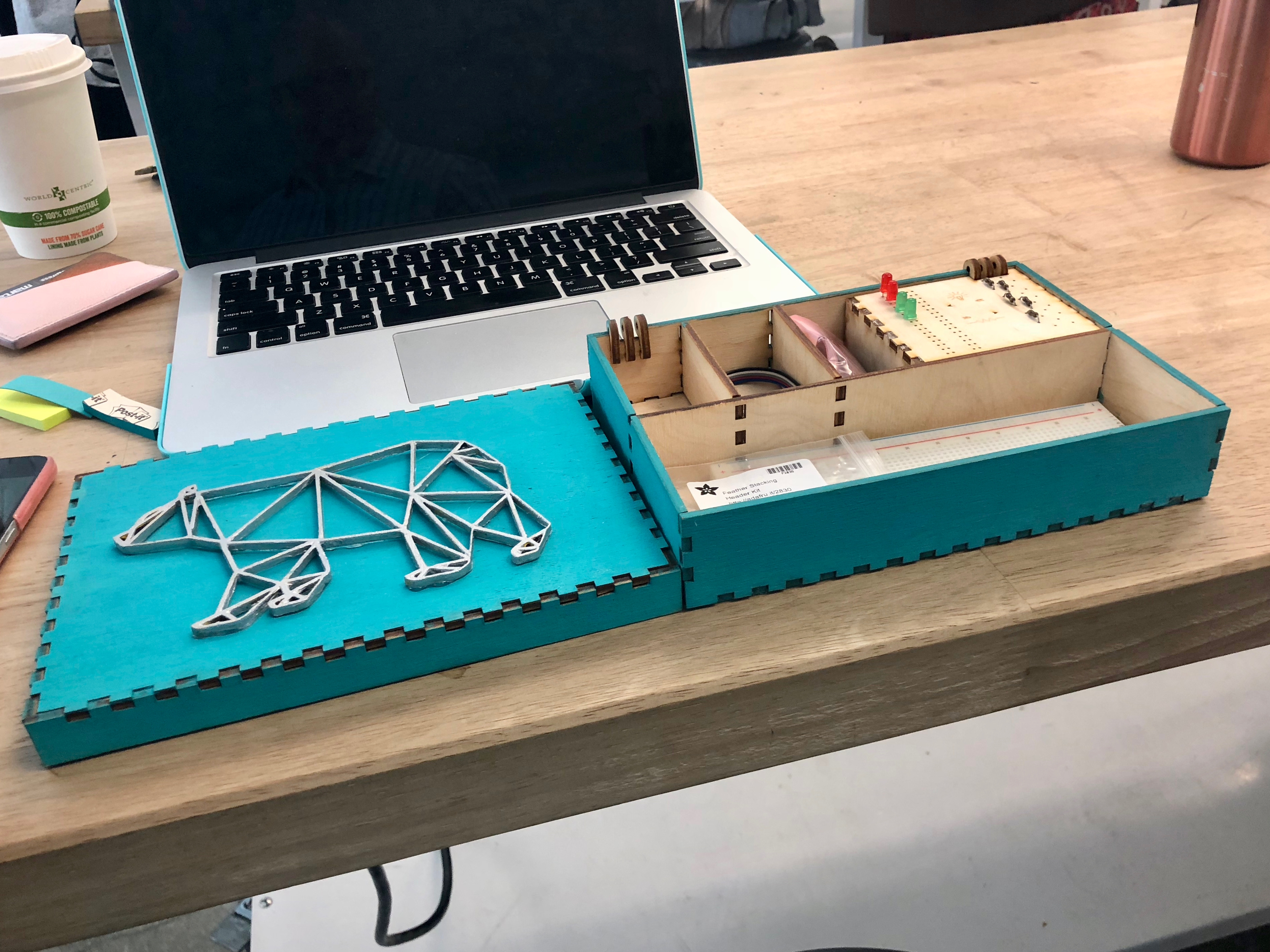
BoxIt
Field Activity 03
Provocation 01 • Protest Design
In this provocation, students were asked to design a new interactive object within the landscape of protest and activism. Below is a a video playlist of all of the 8 resulting projects (2 min each).
Design Noir • Field Activity 04
We never share results from the Design Noir Field Activity publicly. Here we are during the critique with candles lit.
-
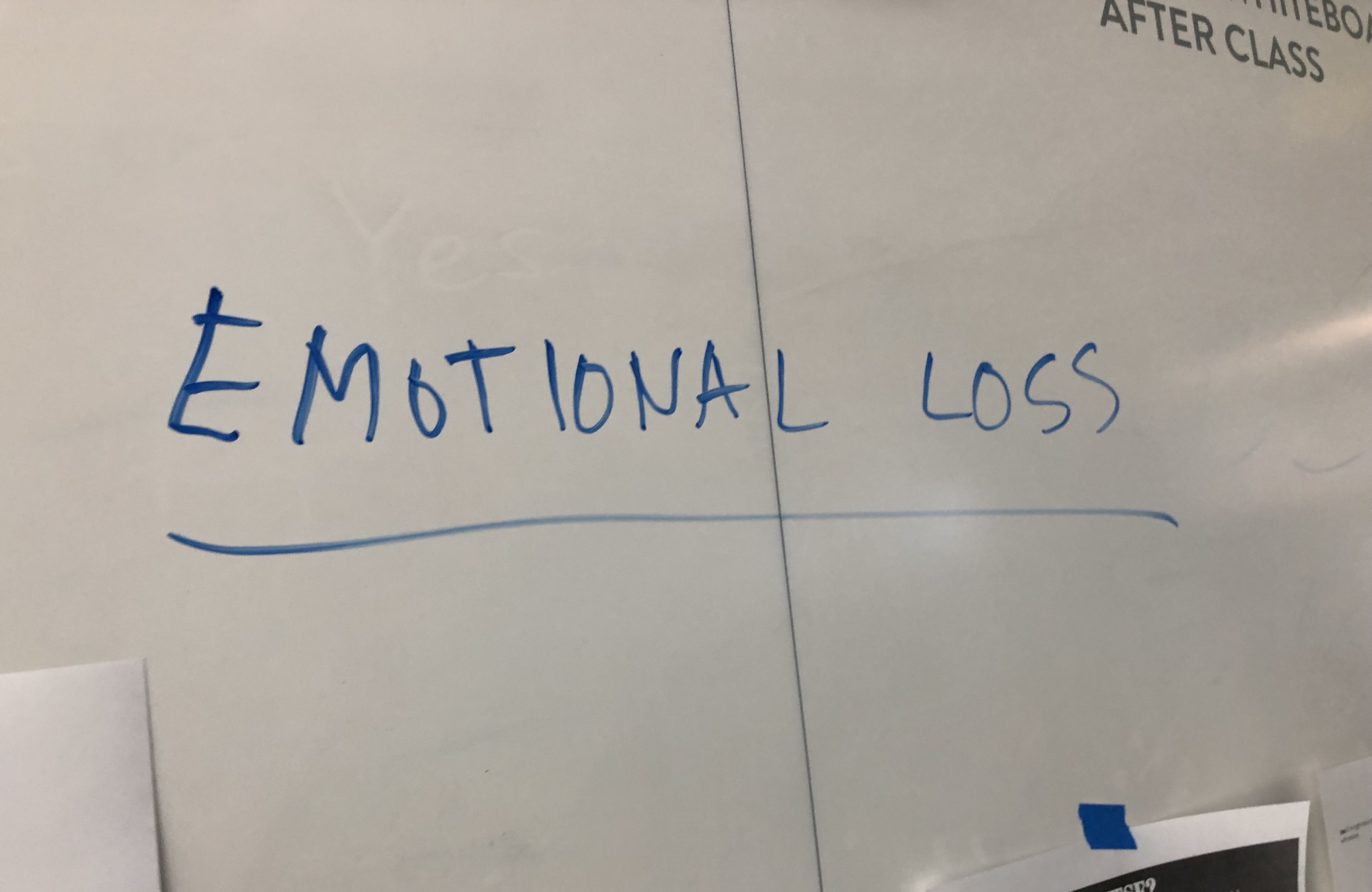
Design Noir
Field Activity 04 -

Design Noir
Field Activity 04 -
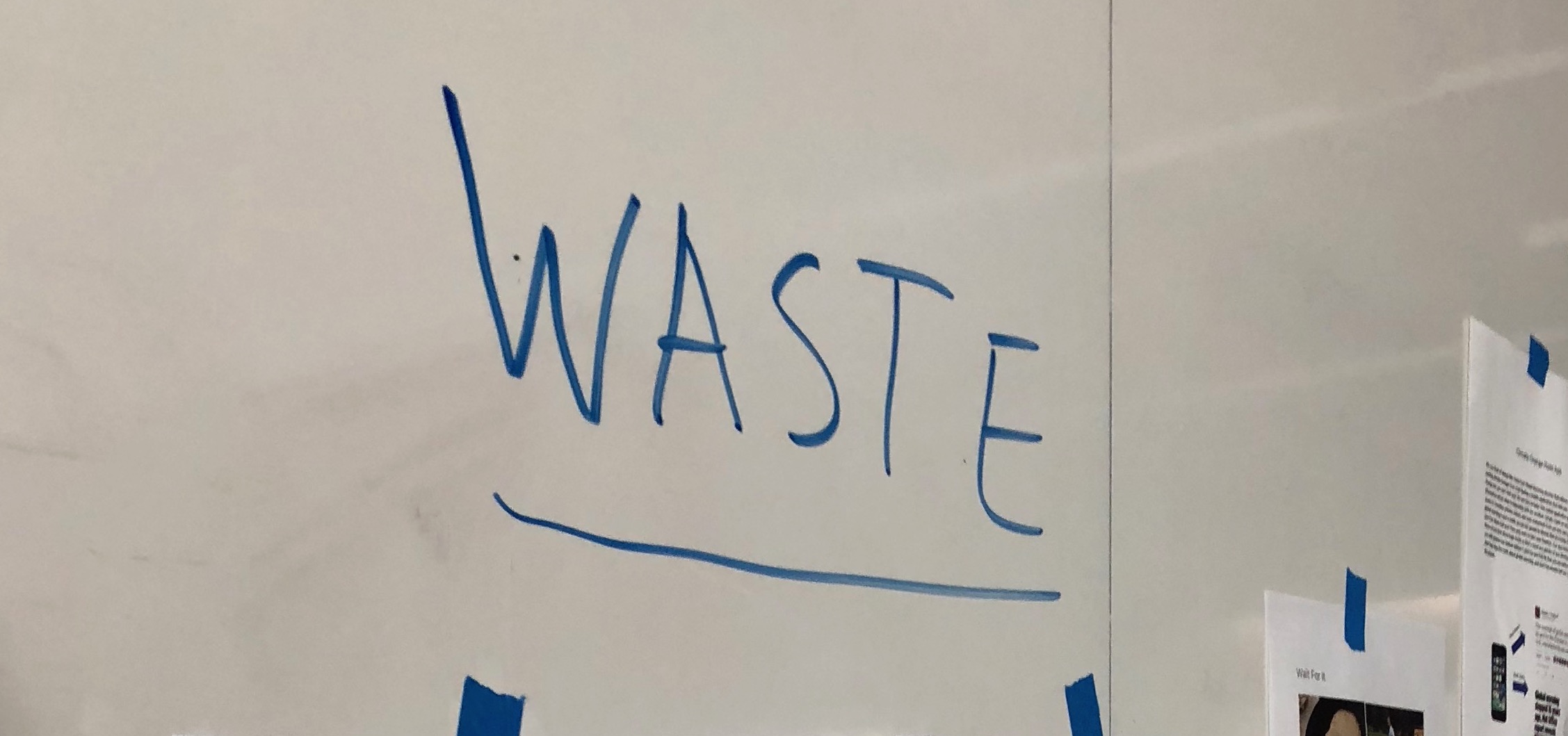
Design Noir
Field Activity 04 -
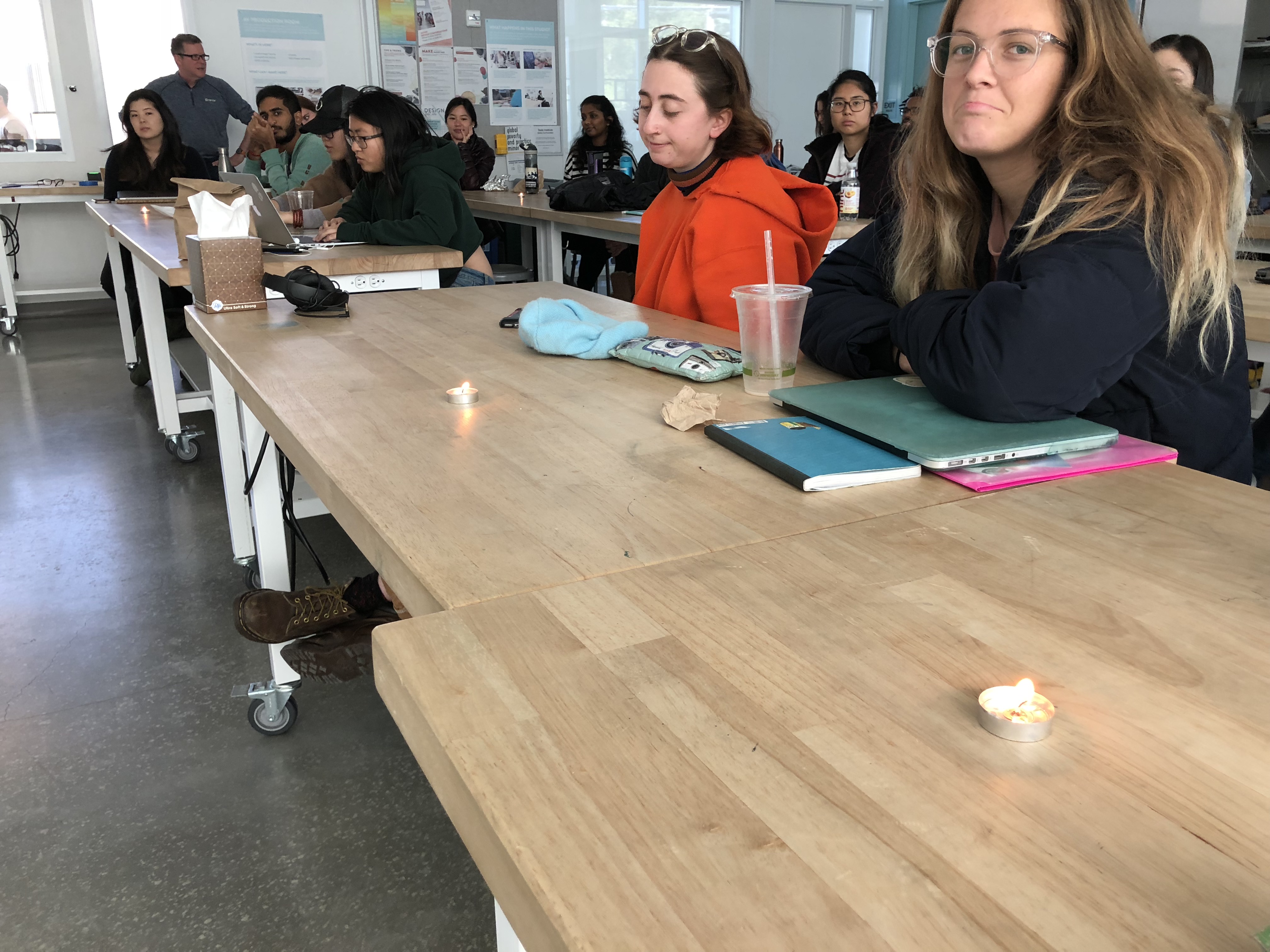
Design Noir
Field Activity 04
Fiat Faciendi 150 • Field Activity 05
-

Fiat Faciendi 150
Field Activity 05 -
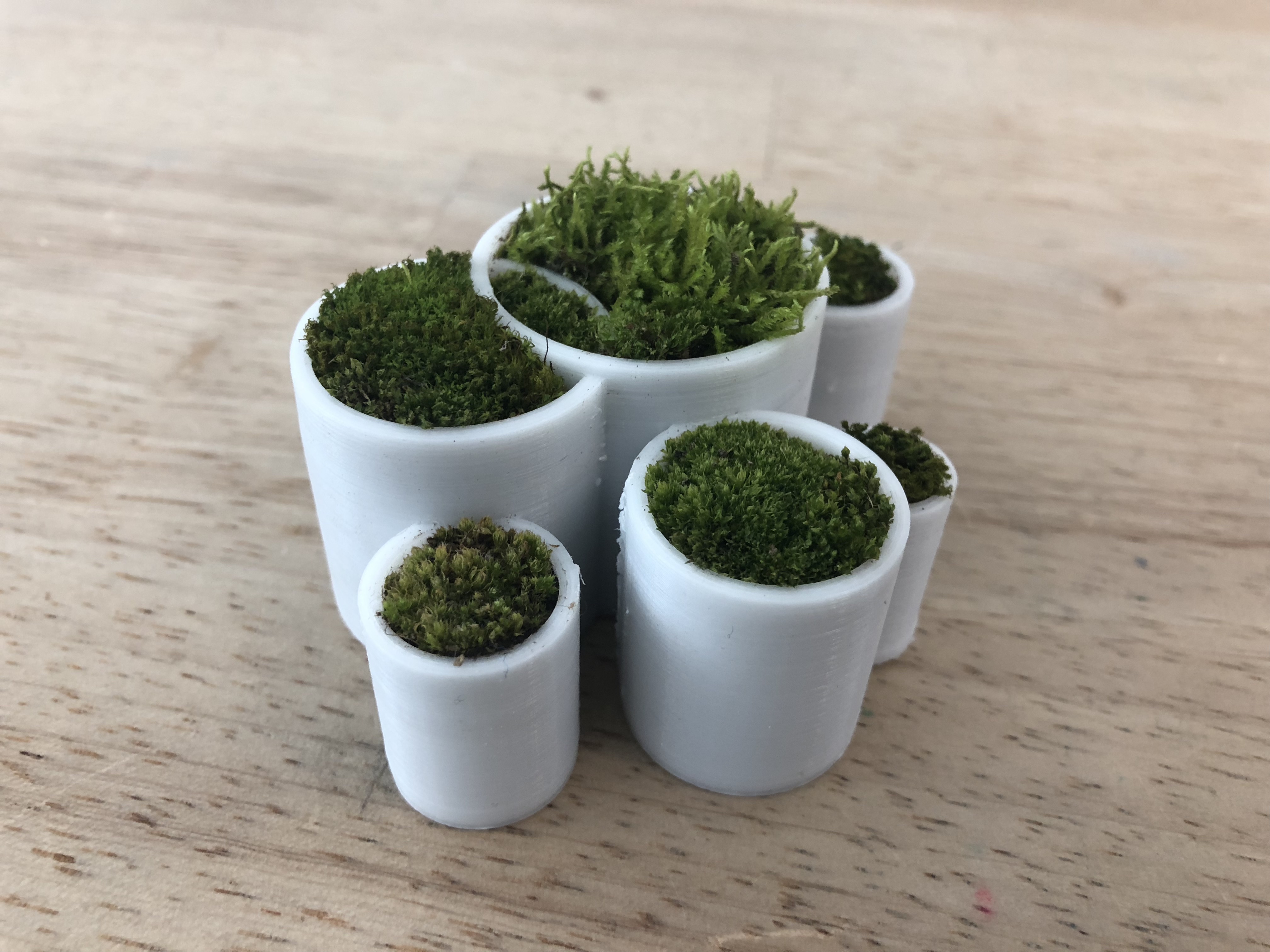
Fiat Faciendi 150
Field Activity 05 -
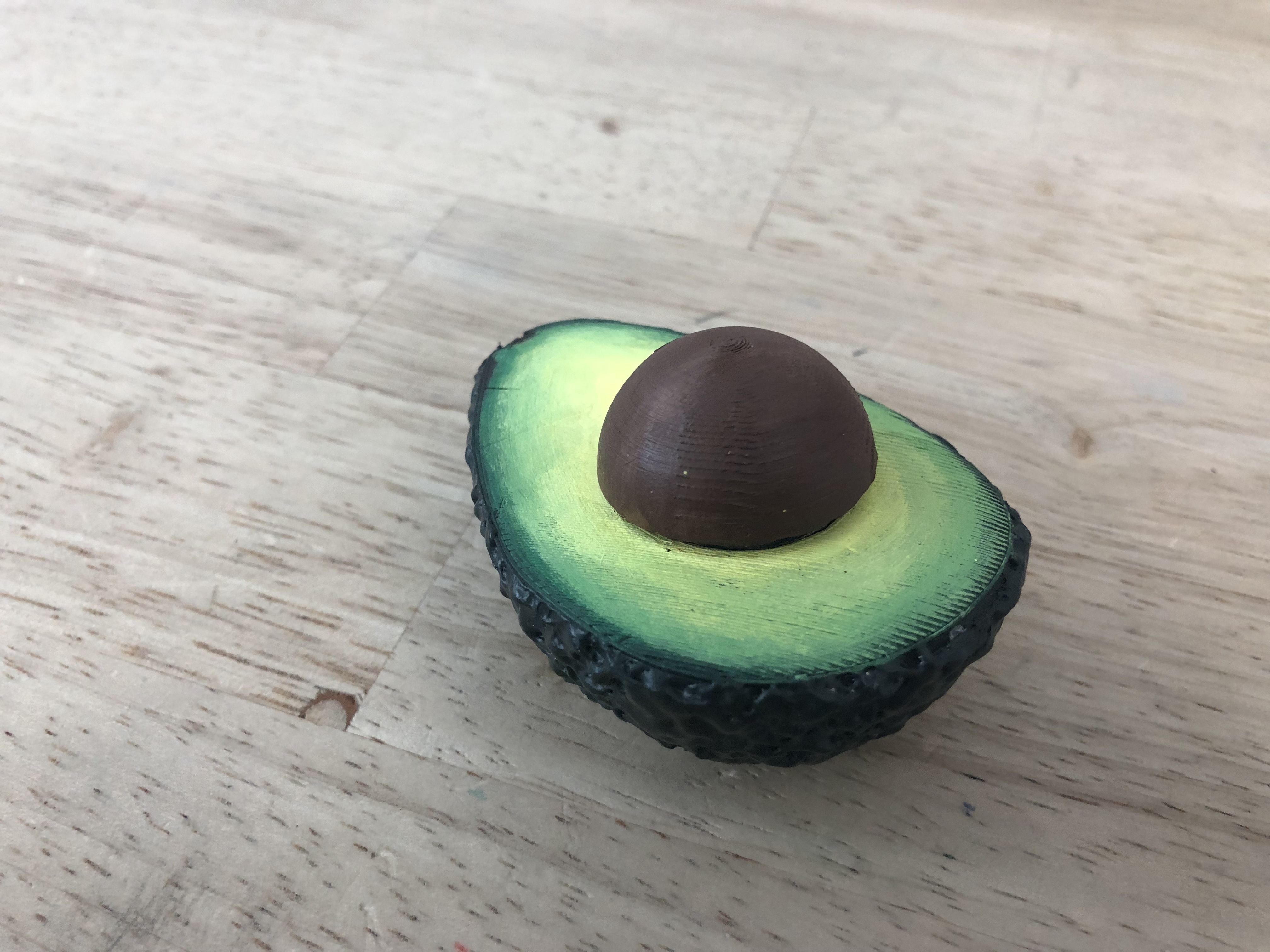
Fiat Faciendi 150
Field Activity 05 -
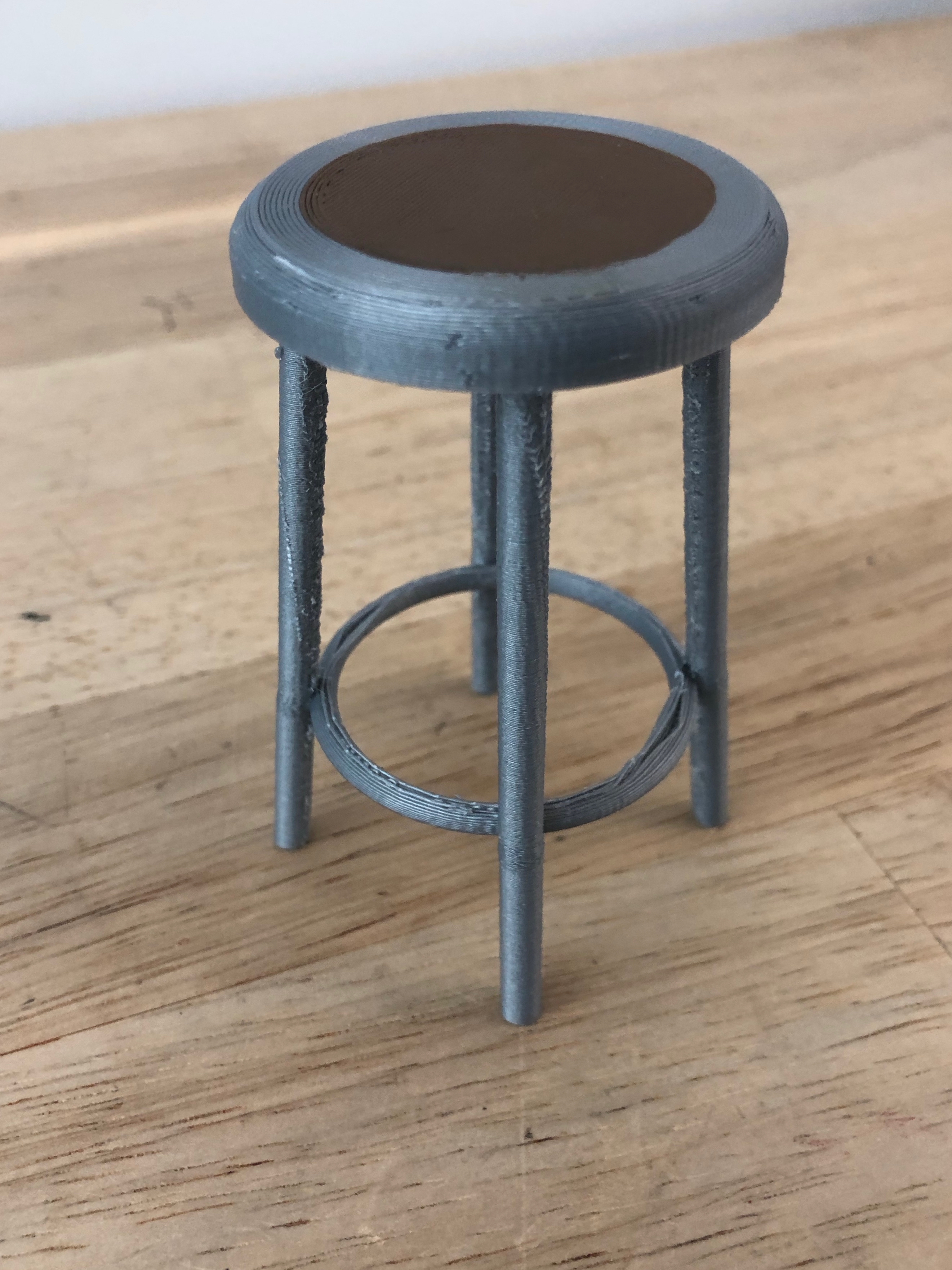
Fiat Faciendi 150
Field Activity 05
Provocation 02 • Move On
In this provocation, students were challanged to design or redesign objects used as part of human powered movement.
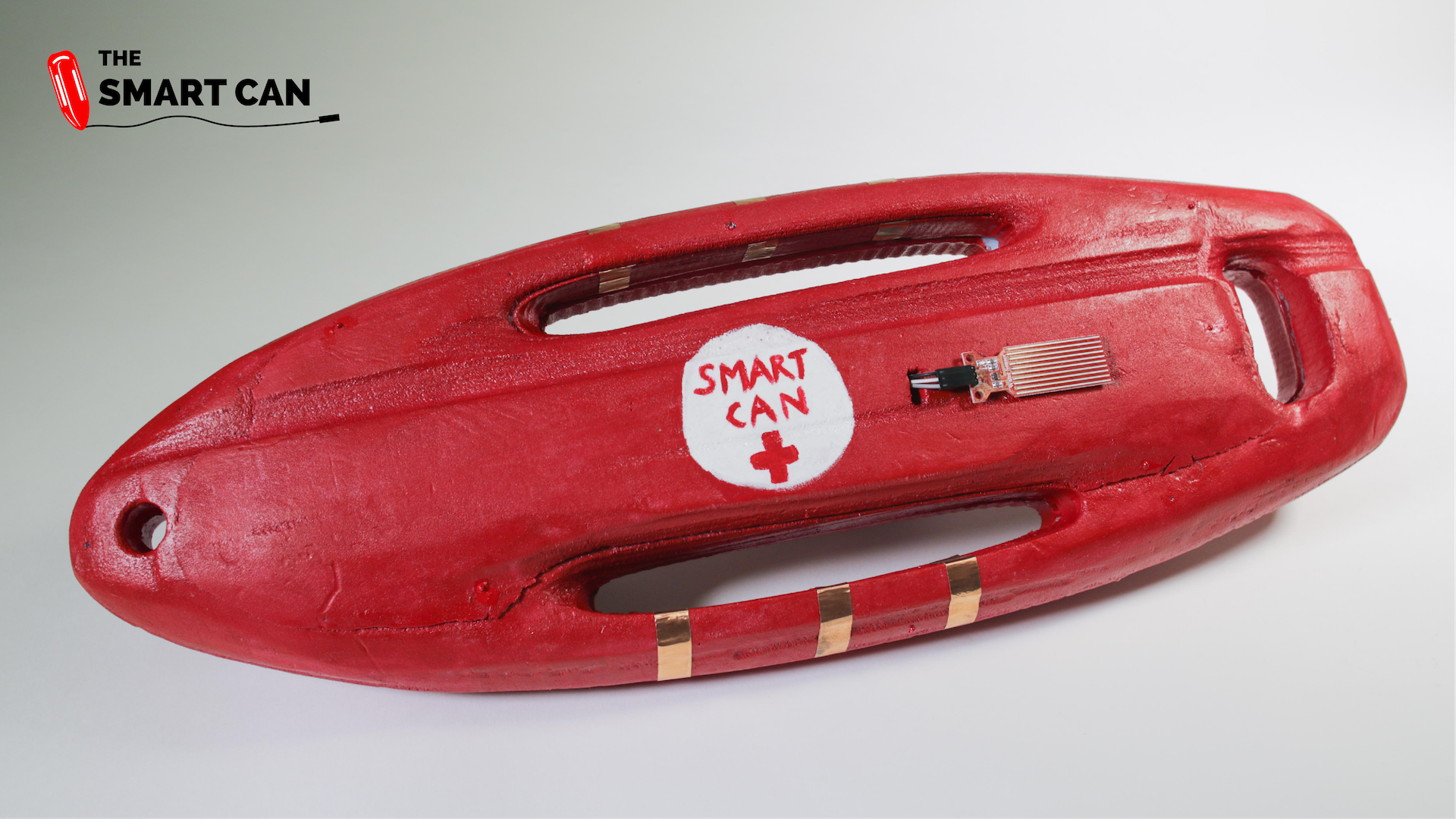
Operation Record-A-Rescue
Fiona Duerr, Purva Juvekar, Nour Eldifrawy, Christina Pappas
Operation Record-A-Rescue's Smart Can empowers lifeguards to focus on their most critical jobs - saving lives! - by autonomously collecting and aggregating ocean rescue data in real-time. Though it's hard to believe in this hyper-connected day and age, lifeguards are currently expected to hand-record rescue information following each and every rescue occasion - upwards of 50 occasions on busy days. Because this practice requires lifeguards to divert their attention away from the water, it is at best unrealistic and at worst unsafe. To remove the burden of collecting rescue data from lifeguards, we have equipped the standard Burnside buoy ("can"), a device uniformly relied upon by lifeguards to tow swimmers to safety, with the ability to automatically send a signal and record data every time a rescue occurs. Our "Smart Can" is augmented with capacitive sensors on both handles along with a water sensor, which - when activated simultaneously, meaning that a rescue is in progress - communicate with the lifeguard tower through WiFi. In the future, we envision all lifeguards using Smart Cans and thereby creating a dynamic heat map of rescues helping to inform lifeguard resourcing, provide information on "hot zones" and rip tides, and empower the public with transparent real-time data.
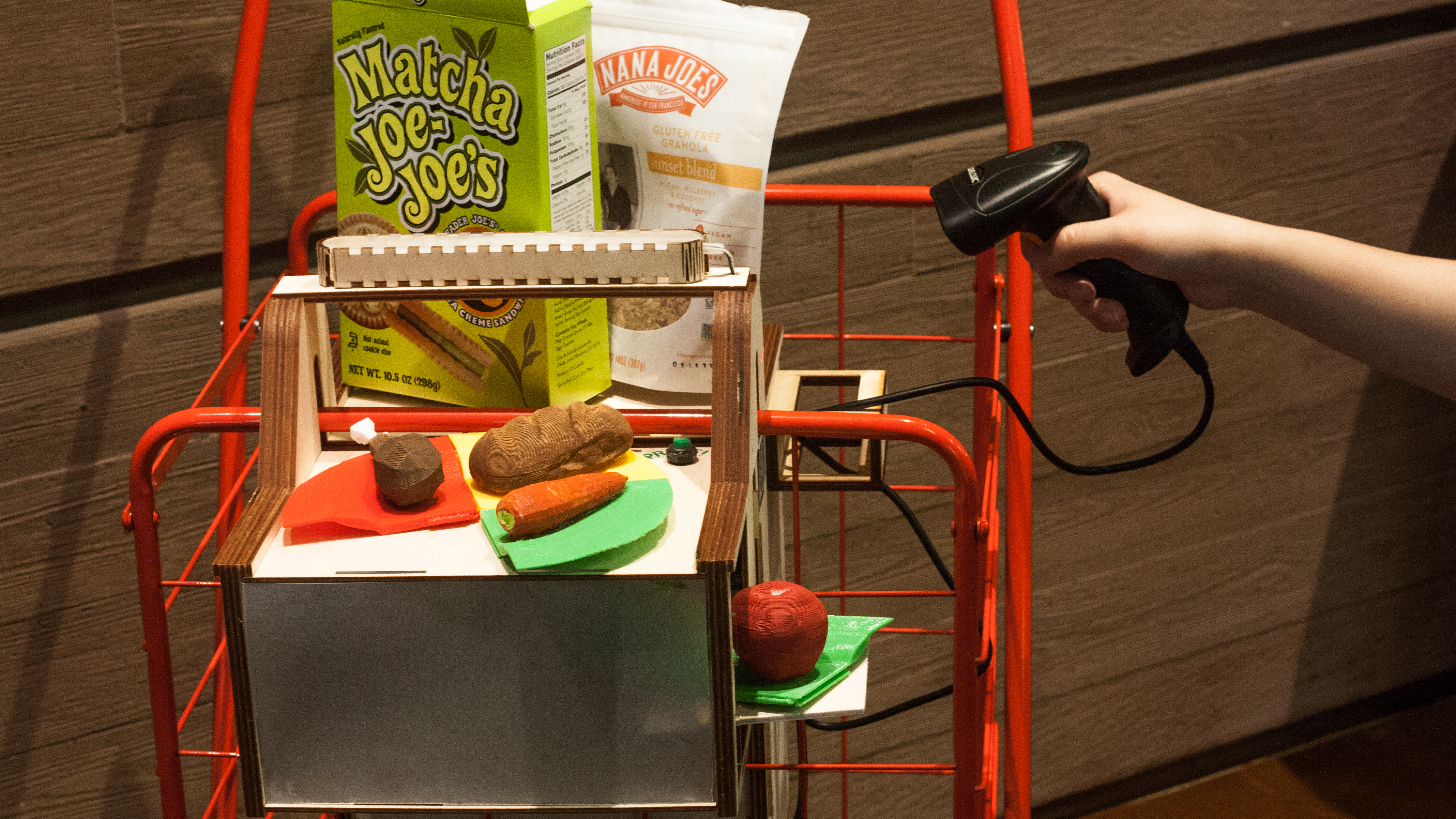
Nutriplay
Sally Tran, Justine Chia, Kiran Delneuville, Michelle Kim
NutriPlay is an educational toy meant to inform and empower children about nutrition and healthy eating. The device consists of a box with a motorized hatch and a row of indicator lights, along with a barcode scanner. Scanning unhealthy items will cause red lights to flash, indicating a wrong choice. Healthier items will result in green lights, which will accumulate until the child has scanned nine healthy items to win the game and the child can then open the box and retrieve their prize. In doing so, they learn to associate good nutrition with a sense of reward and accomplishment. The prizes included with NutriPlay are a set of model food puzzle pieces, which can be assembled into a nutritionally balanced meal. Our intent is for NutriPlay to turn grocery shopping into an engaging, productive activity for children and help them build the foundations for healthy lifelong relationship with food.
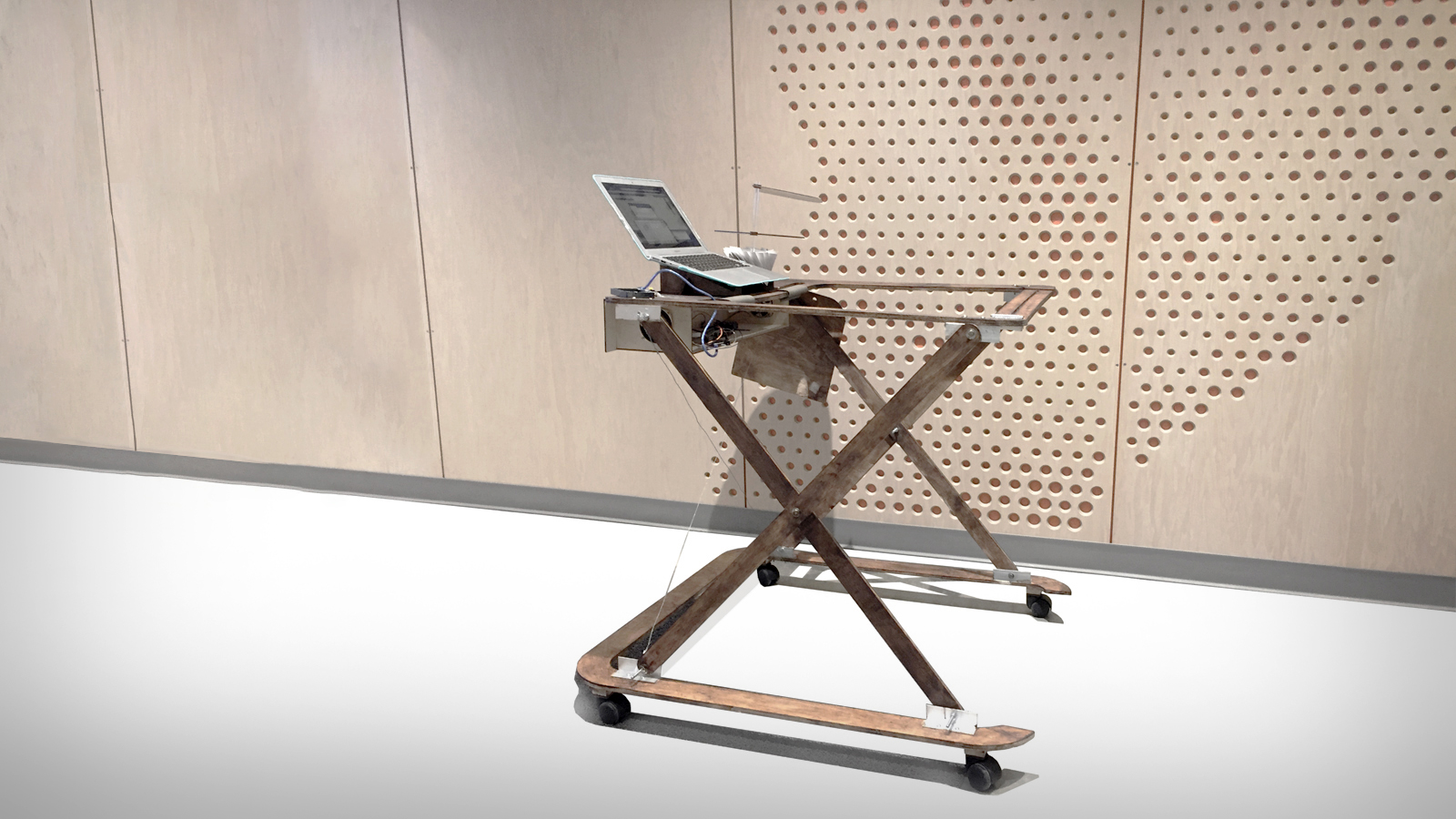
Angel Walker
Crystal Lee, Vivian Liu, Yang Liu, Advaita Patel
Angel Walker is an assistive device that helps passionate self starters take their first steps into the world of Startup-dom. Angel Walker is a mobile organizational space specifically designed for startup ventures. The walker comes with many features that every startup needs such as a work space, prototyping display shelf, promo material and business card holder, microkitchen, and built in sound system for that background elevator music when you do your elevator pitch! When you meet a potential investor or customer, there are designated buttons you can press that will automatically record down the time and meeting place of your interaction onto the online site so you can keep track! Angel Walker is your startup on the-go!

BoBa: BOunce BAck into shape!
Carolyn Chen, George Moore, Vineet Nair, Yayu Zheng
Bounce Back Into Shape (BoBa) is a bouncy ball augmented with sensors (gyroscope and force sensitive resistor) and actuators (haptic motors and a digital RGB LED strip) that facilitates exercise and physical activity on a regular basis, while also helping you move from place to place in both indoor and outdoor settings. BoBa targets young kids (aged 5-12) by incorporating fun, playful elements and gamifying the exercise experience. By integrating hardware with software, it provides immediate positive feedback to incentivize children to be more active even while completing mundane, everyday tasks and not just during sports. Thus, we aim to tackle the problem of rising childhood obesity and early-onset type II diabetes in the United States. This modular product can easily be installed on other bouncy ball applications like ergonomic office chairs and yoga balls in gyms, and adapted for other demographics like adults and seniors.
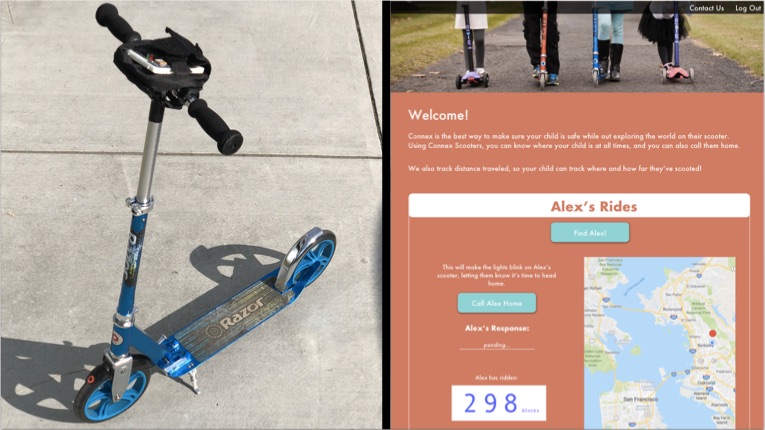
Connex
Conor Farese, Carina Sauter, Leeann Yi Hu, Yuting Zhan
Connex is a scooter built to allow children to explore the world while giving parents the information they need to allow their children to venture out. In today’s world, even when children are excited to go outside, many parents struggle with not supervising their children, as they experience their own anxiety and fear of not knowing where they are. Today's parents feel uneasy letting their children out of sight. Our solution creates a way for parents to communicate with and track their children in a more transparent way. Connex has a GPS for easy tracking; parents can use a web portal to track their kids and signal them to come home. Connex will give parents the assurance they need to allow their children to explore while encouraging them to only check in on their children when necessary. Our design challenges current prevalent kids tracking devices and will hopefully spark a valuable conversation about safety, anxiety and privacy in the modern era.
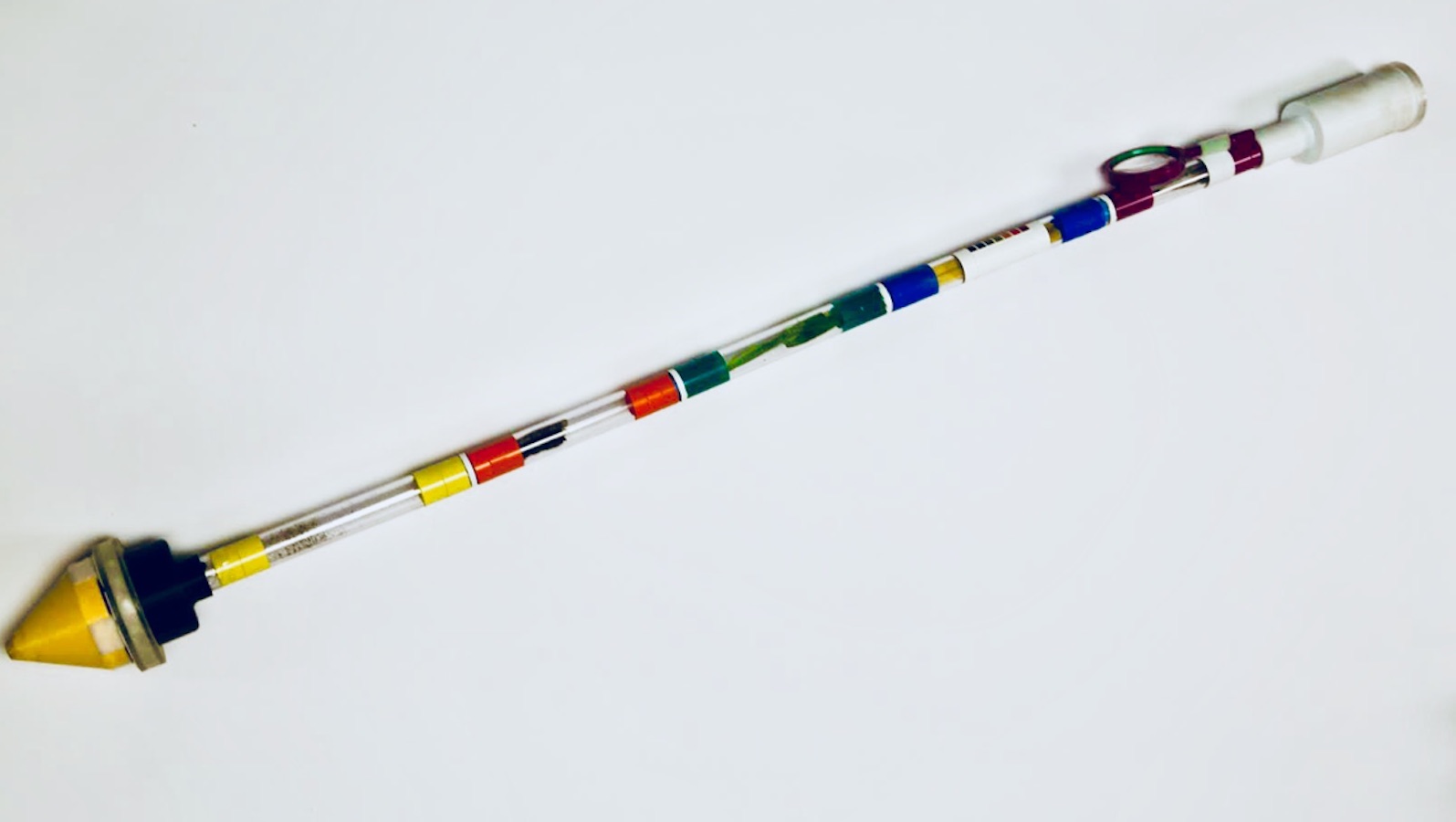
Fantastick
Alyssa Li, Lieyah Dagan, Arnaud Bard de Coutance, Silvia Kim
The phrase “children are naturally scientists” is one we hear often. And yet, these innate qualities in children may be hindered by a new and obsessive attachment to mobile devices and applications. This shift has had detrimental effects on children, including obesity, decreased attention spans and poor academic performance. As a response, we developed FantaSTICK, a fun tool that augments the classroom experience for children, through guidance and structure that can support their natural curiosity and activity and ultimately empower them to engage with the outdoors (like scientists) rather than their mobile devices. FantaSTICK is divided into detachable modules corresponding to colors and tasks. The purple module stores tools, the blue, litmus paper for testing PH, the green, plants or flowers, the orange, insects, and the yellow, soil as well as a moisture sensor. To begin the journey into the outdoors, parents and teachers place beacons in areas with data they would like the children to explore. When a child finds a beacon, a light at the top of their handle will indicate which module should be used for sensing or collecting. After a fun adventure, children can take their discoveries back to the classroom or the home, where teachers and parents can use an online platform that visualizes and records these discoveries through an interactive map and a personal profile. Changes in this data over time, as well as changes in the level of activity of the children, can be used to spark conversation, education, and further discovery.
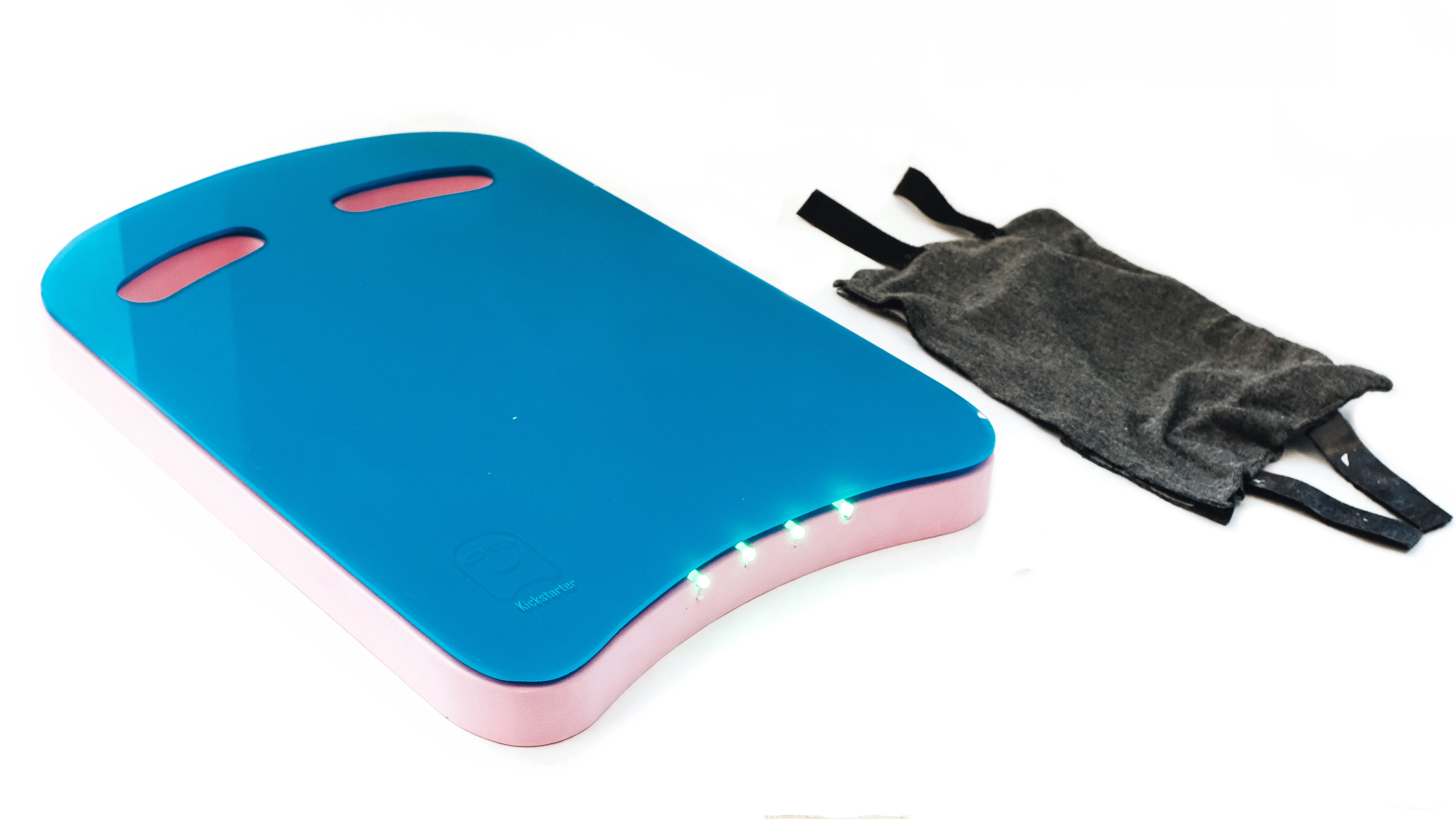
Kickstarter
Arianna Ninh, Essie Xu, Varna Vasudevan, Edward Rivero
Kickstarter is a dynamic, assistive kickboard equipped with interactive technology to assist with swimming education, helping beginning swimmers learn to navigate obstacles and swim with the proper straight-legged kicking technique. The ultrasonic sensor embedded into the front of the kickboard detects walls, people, and other obstacles; a motor provides haptic feedback via a vibration motor under the hand-holds in order to allow the swimmer to maneuver and avoid collisions. The flex sensor in the knee-pad detects bending in the knees during freestyle kicks and uses radio communication with LED lights in the kickboard to provide feedback on kicking technique. The lights turn green when the user is exhibiting proper kicking technique, yellow with minimal bending, and red if knees are too bent. The kickstarter kickboard is perfect for amateurs that are learning to master great kicking technique, using real-time interactive technology to provide feedback and augment the swimming education experience.
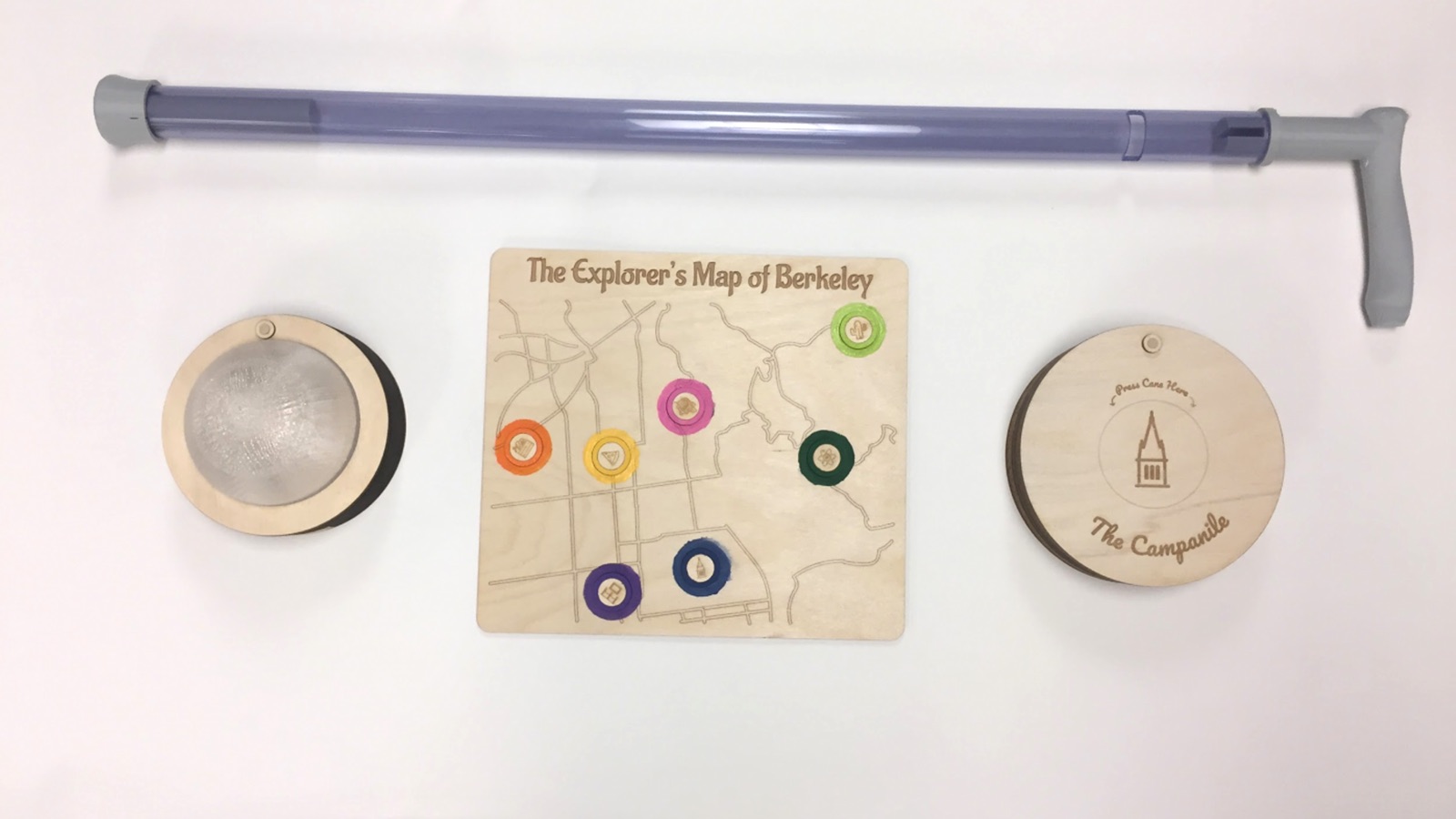
Coinnexion
Katherine Qiu, Nisha Pathak, Nigel Mevana
We wanted to make a product that helps the elderly population feel more confident, more excited to leave their homes, and excited to socialize in their communities. This population oftentimes relies on a cane for mobility but the social stigma associated with using a cane can deter people from using one when they need it or from going out at all. That’s why we chose to build a cane that interacts with its environment. In fact, the only way our product works is if you use your cane to check in at selected locations. Each user receives a map and a cane from town hall. On the map, specific locations have been cut out and need to be filled in with collectible coins. To obtain these coins, the user must travel to each location and check in using their cane by pressing their cane into our stamper. This triggers a ring of LEDs to light up in a globe. These lights notify the location’s staff that a new user has checked in. It’s only when a user has checked in that a staff member gives them the coin designed for that location. The special cane has been built to allow for storage of the coins in its tube. The handle is also easy to remove so the user can take the coins out and place them on their map. We hope that the collecting of coins will motivate users to explore their community and encourage them to visit their favorite places.
Class Culture
Images (and a video) from throughout the semester including our classroom activities, field trip to SFMOMA, critiques, and moments of inspration and making.
